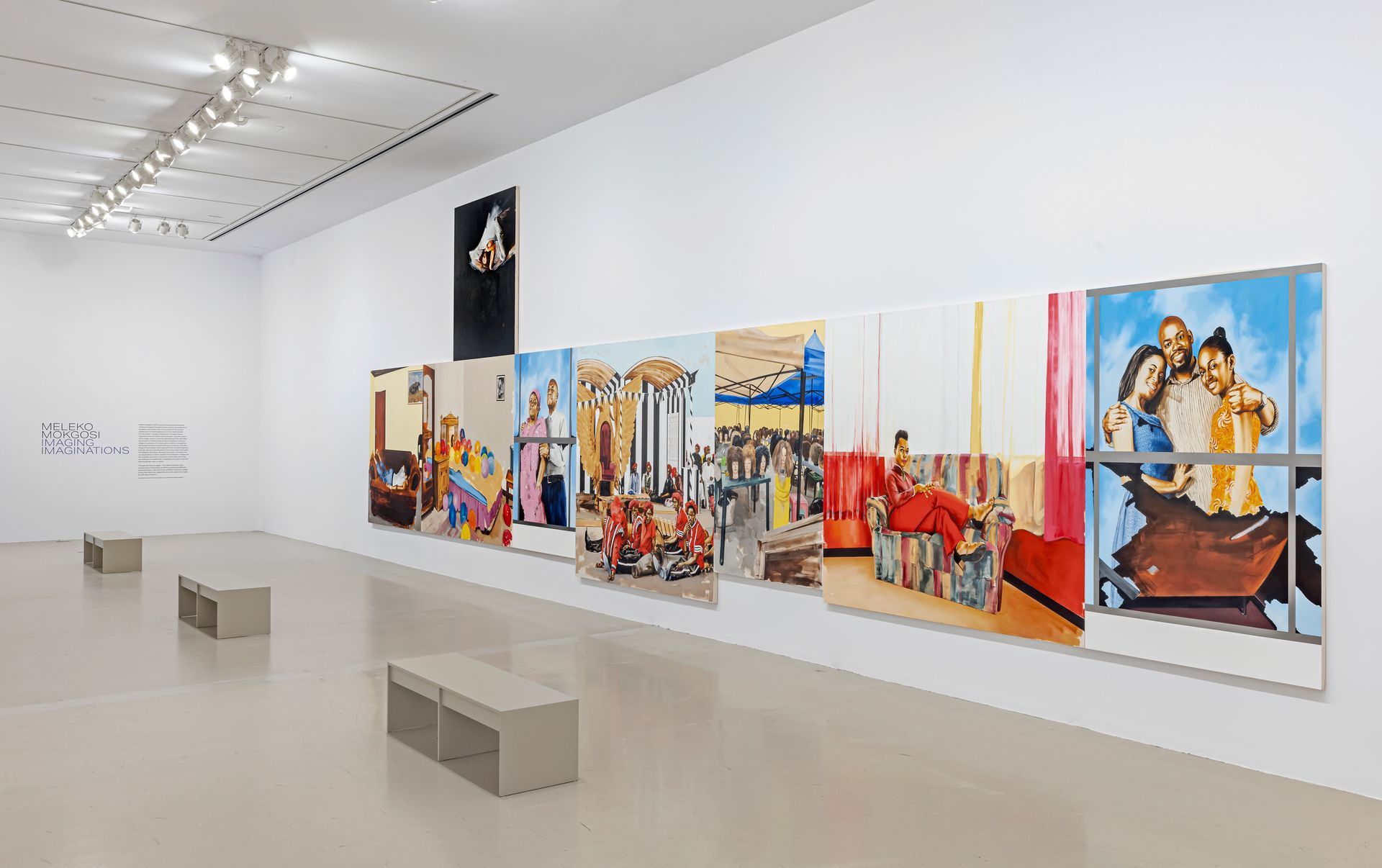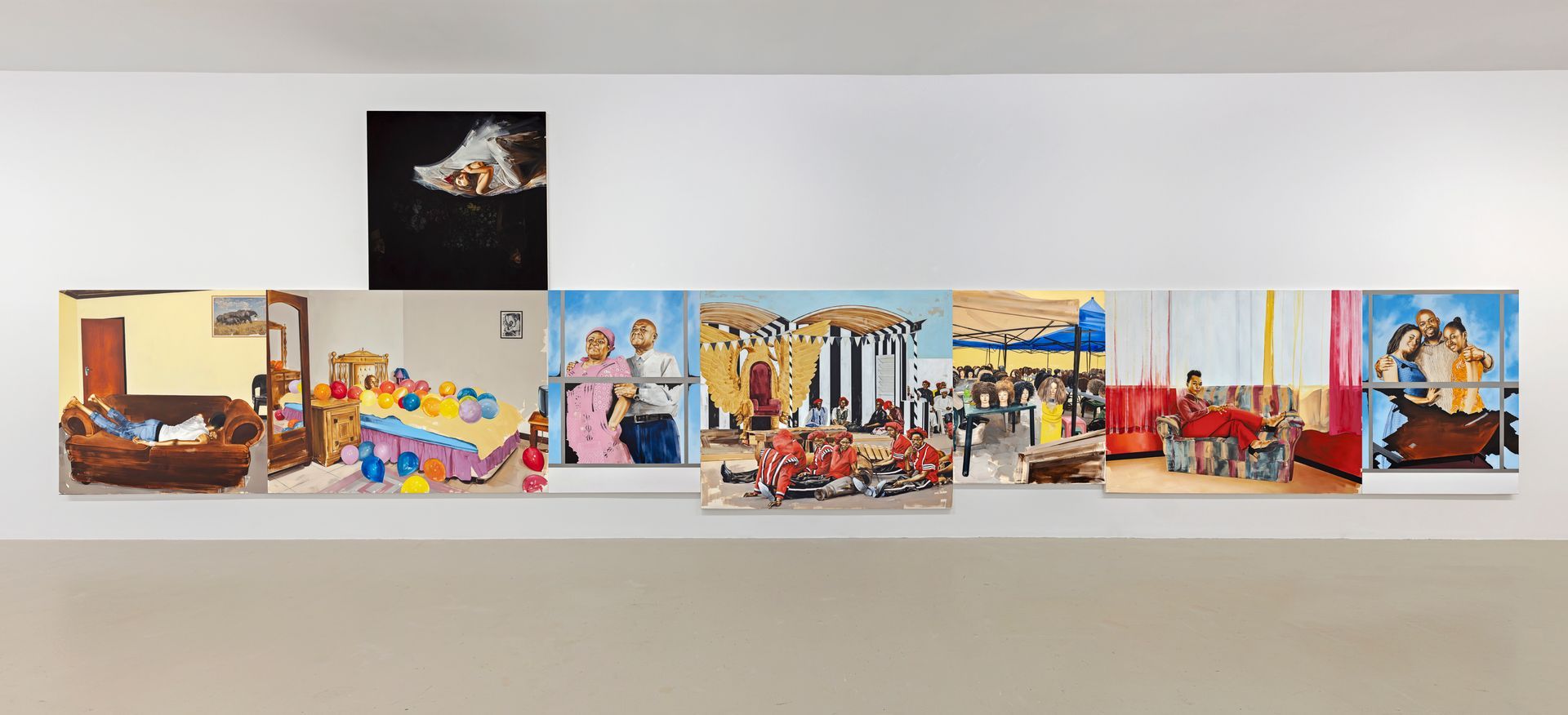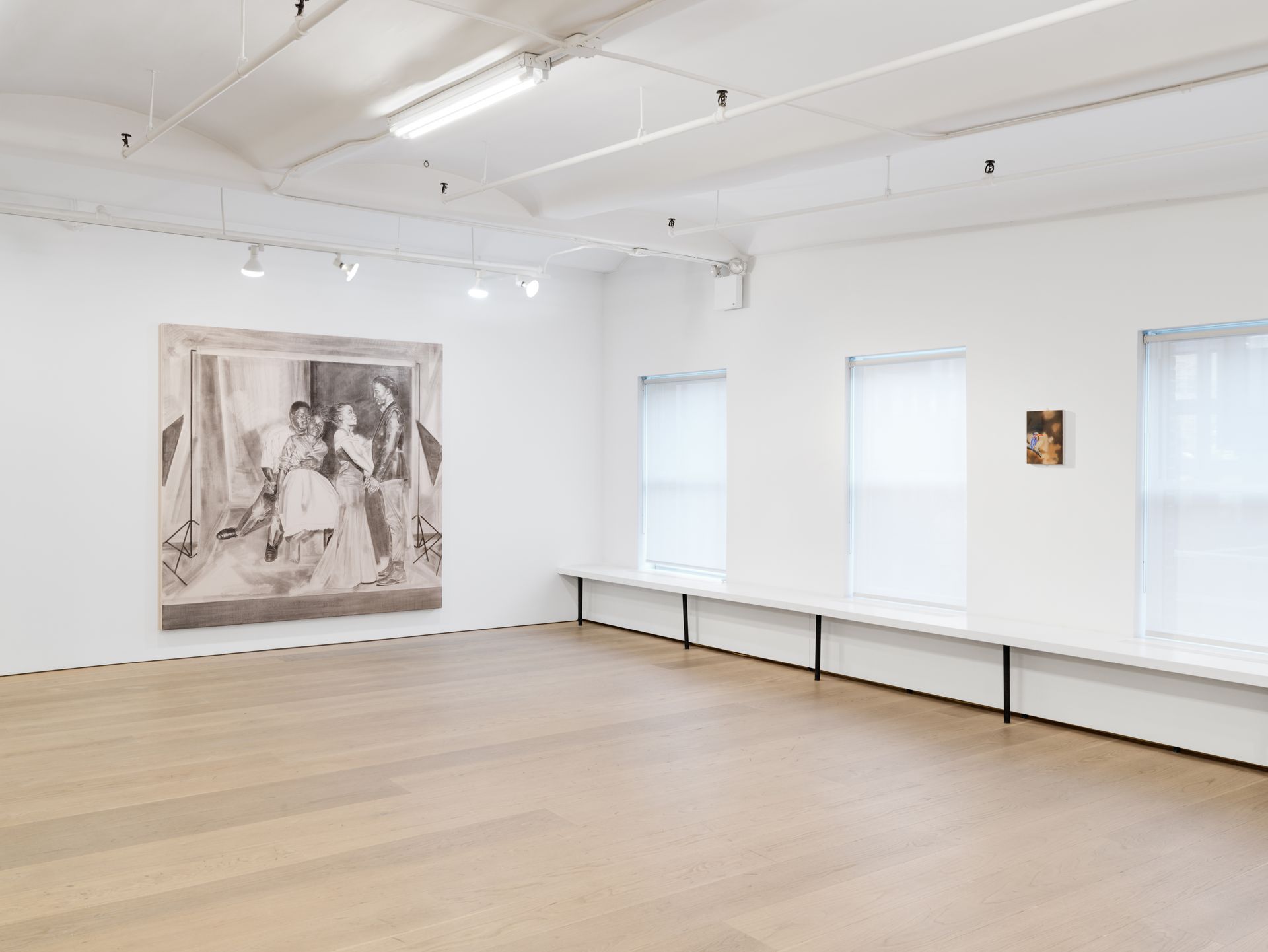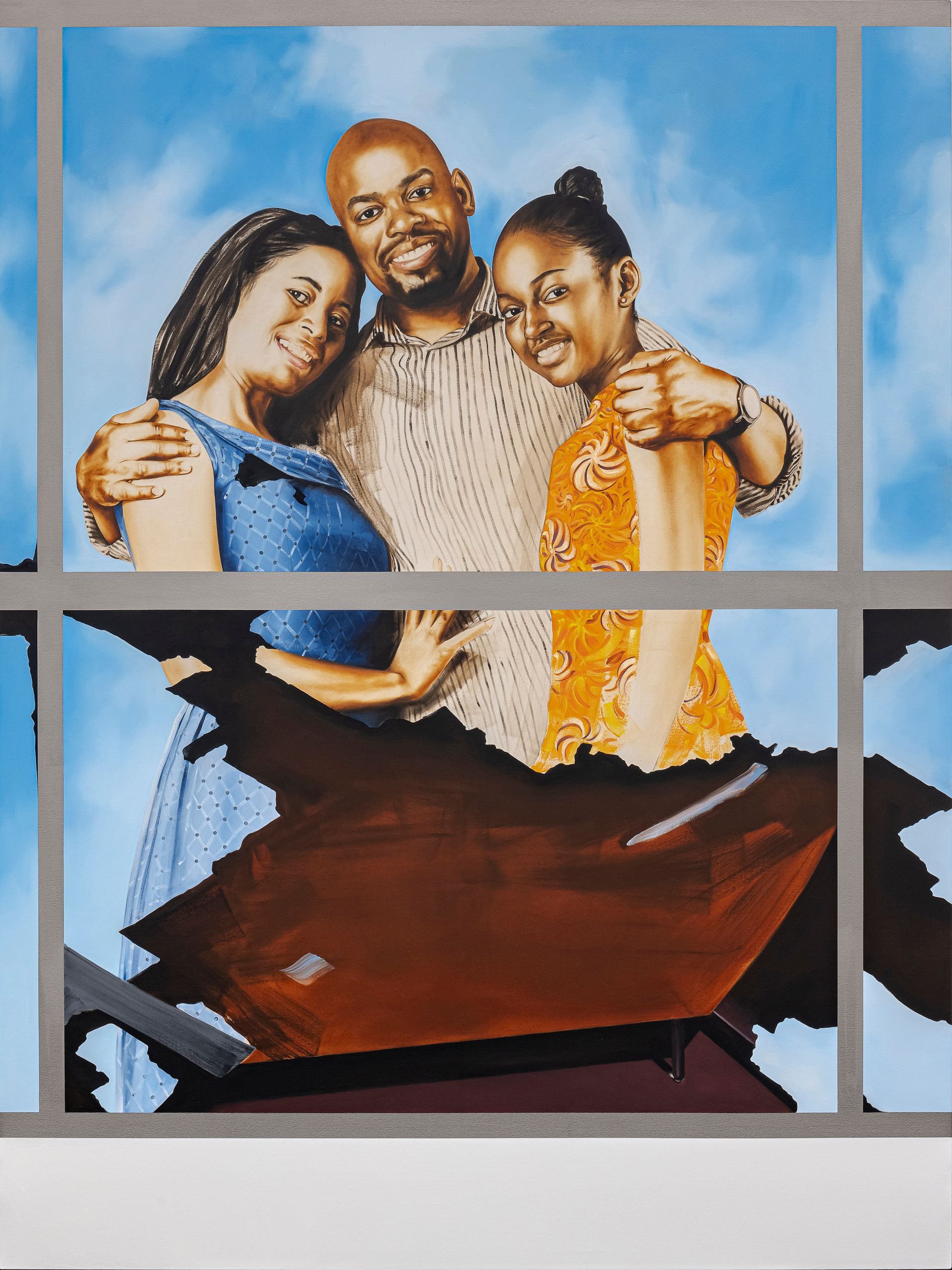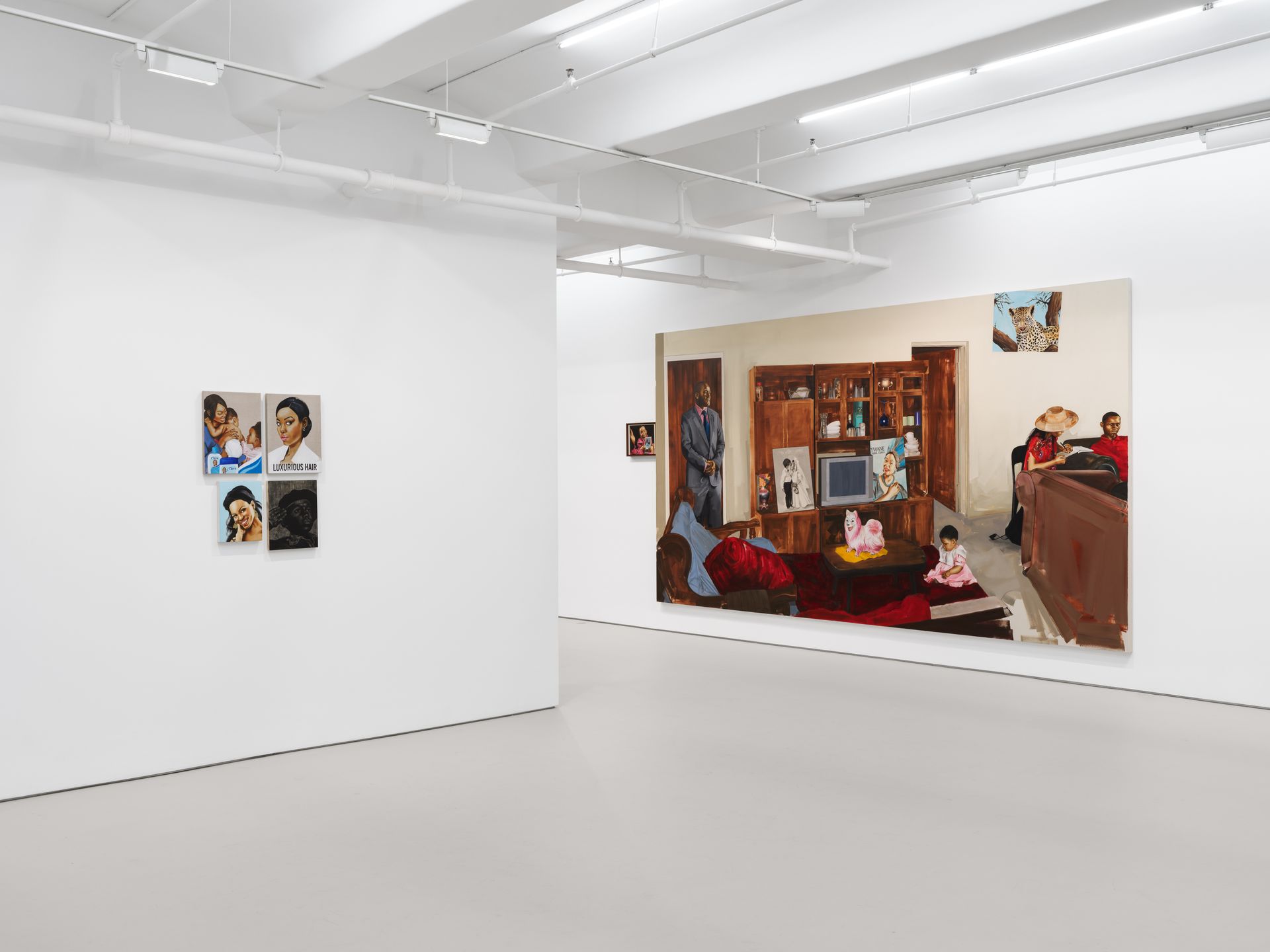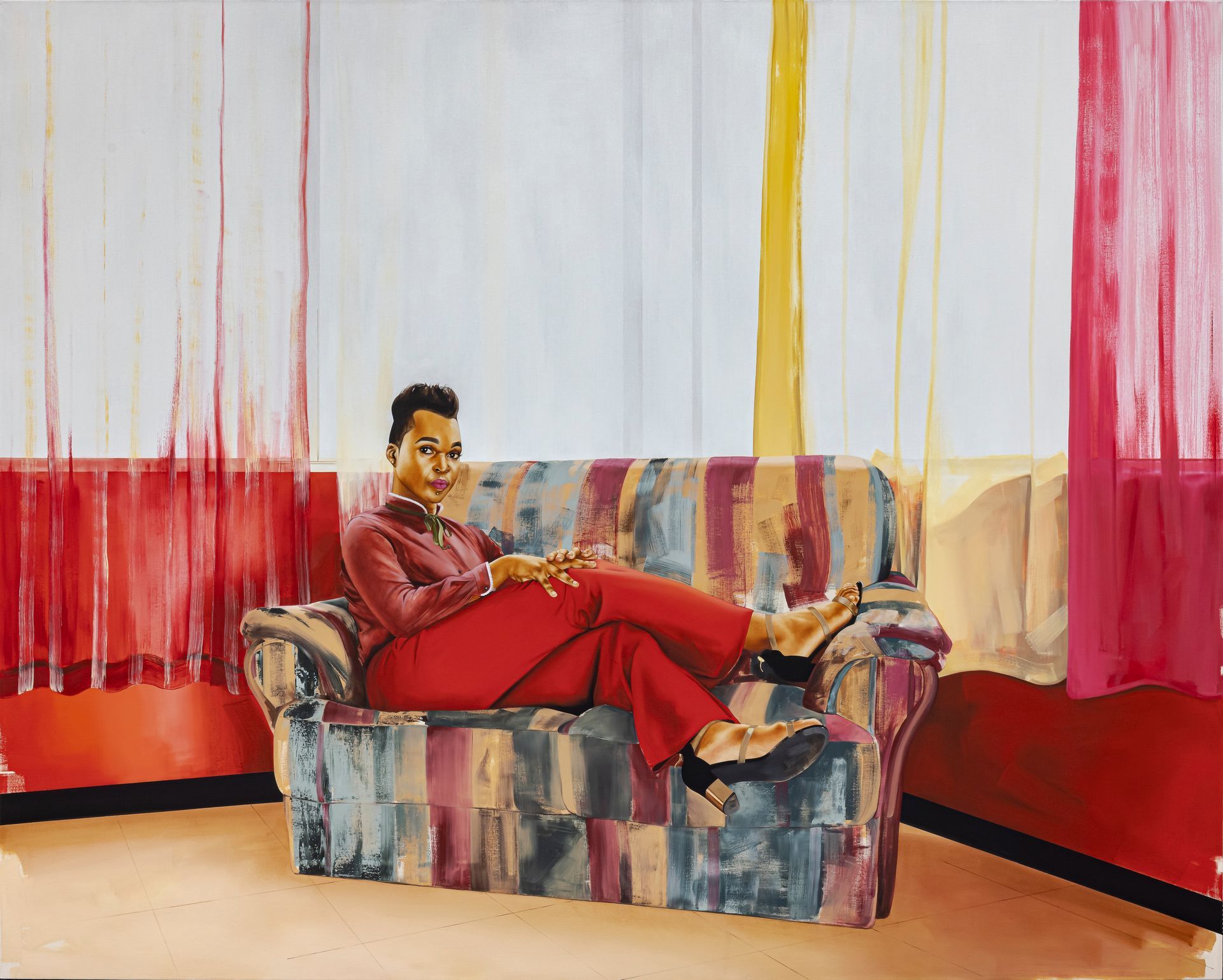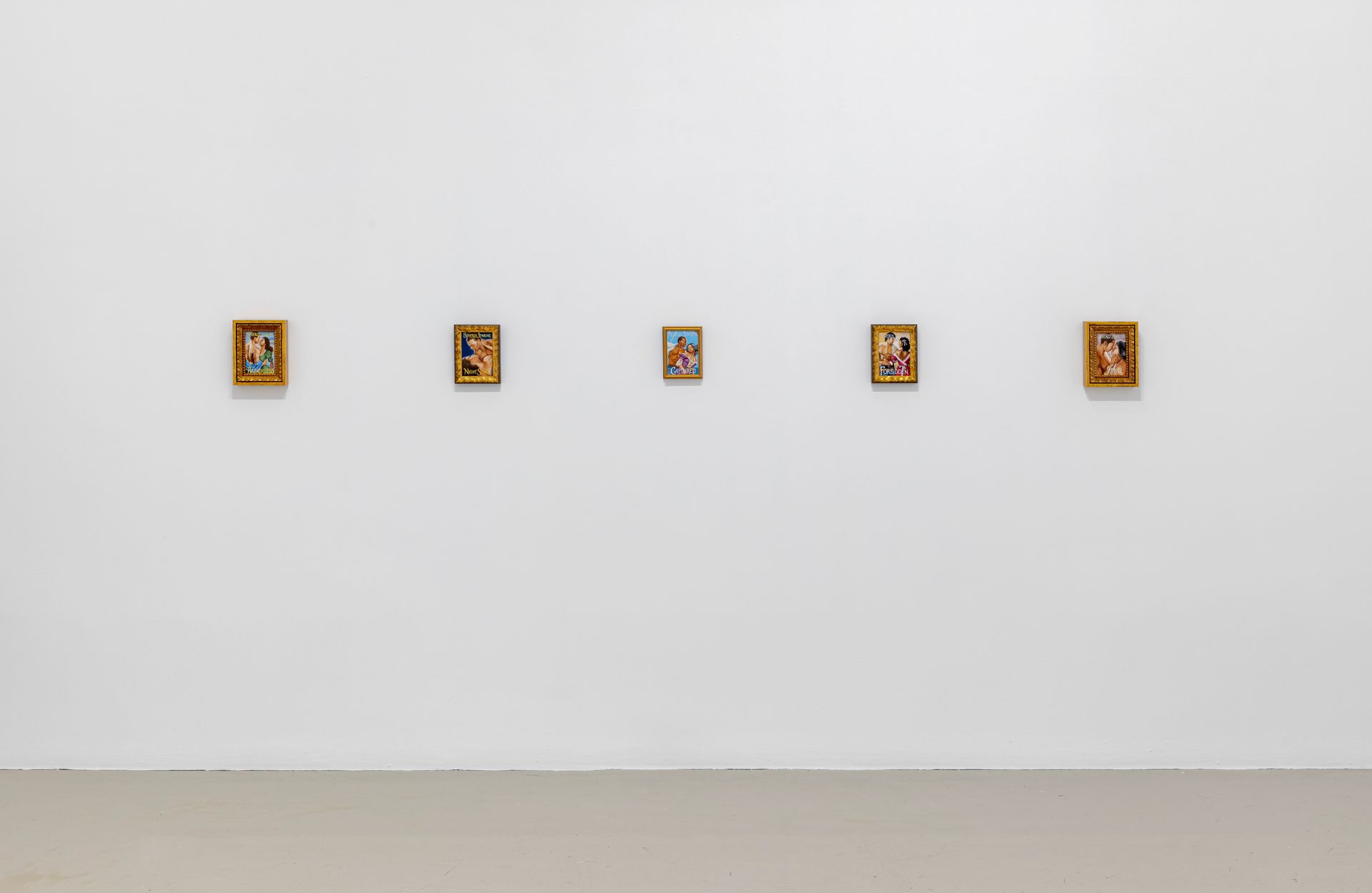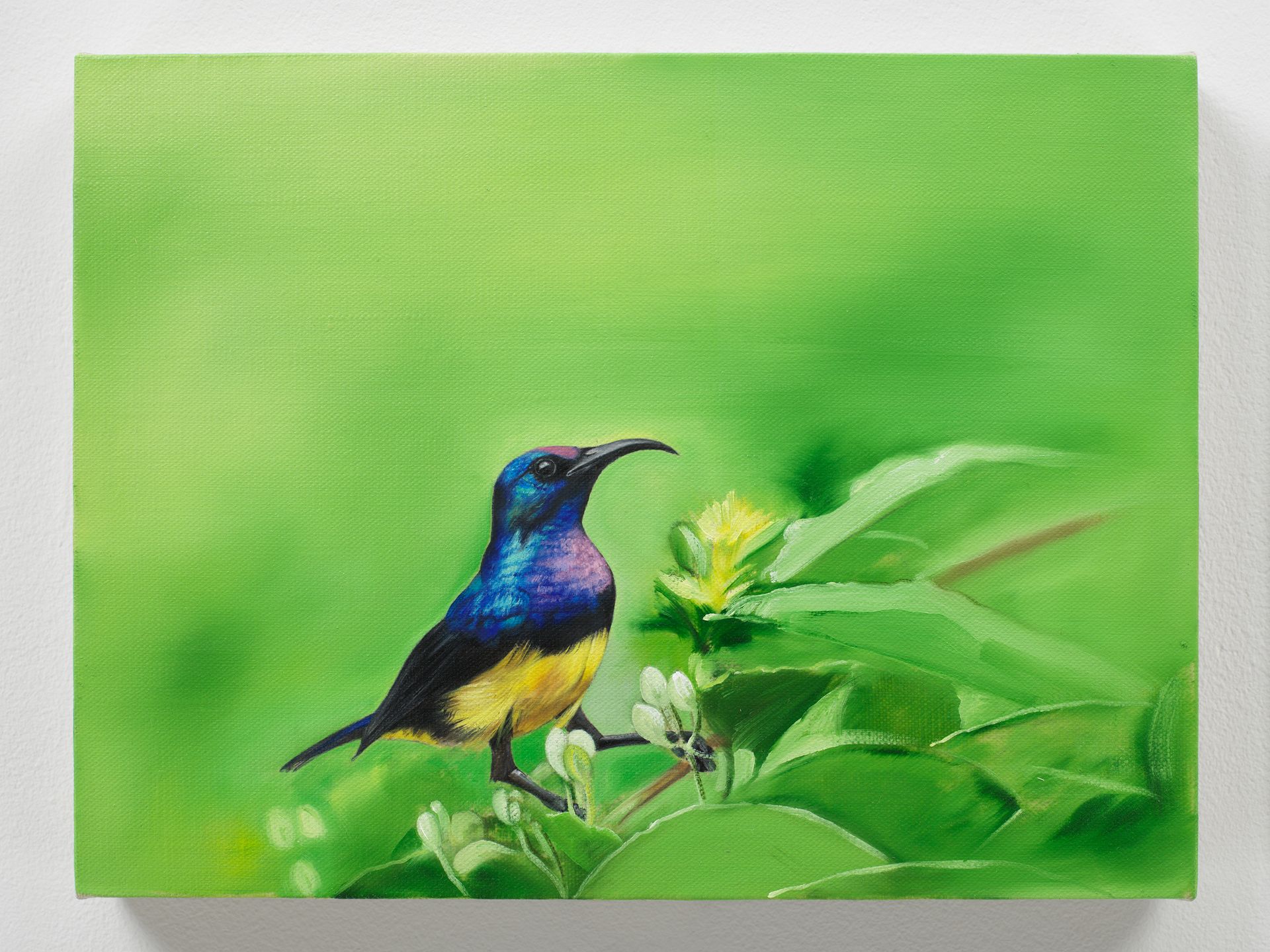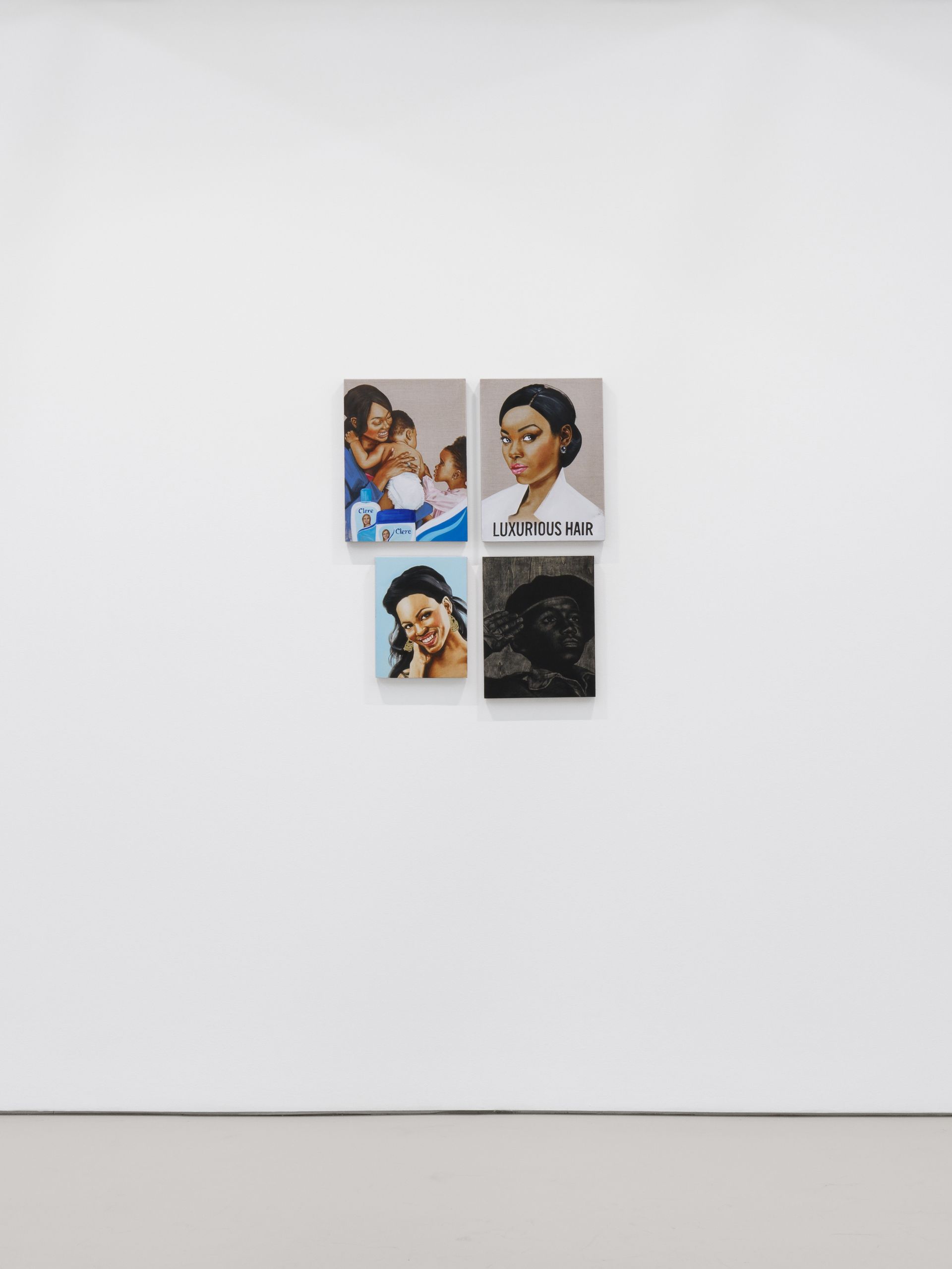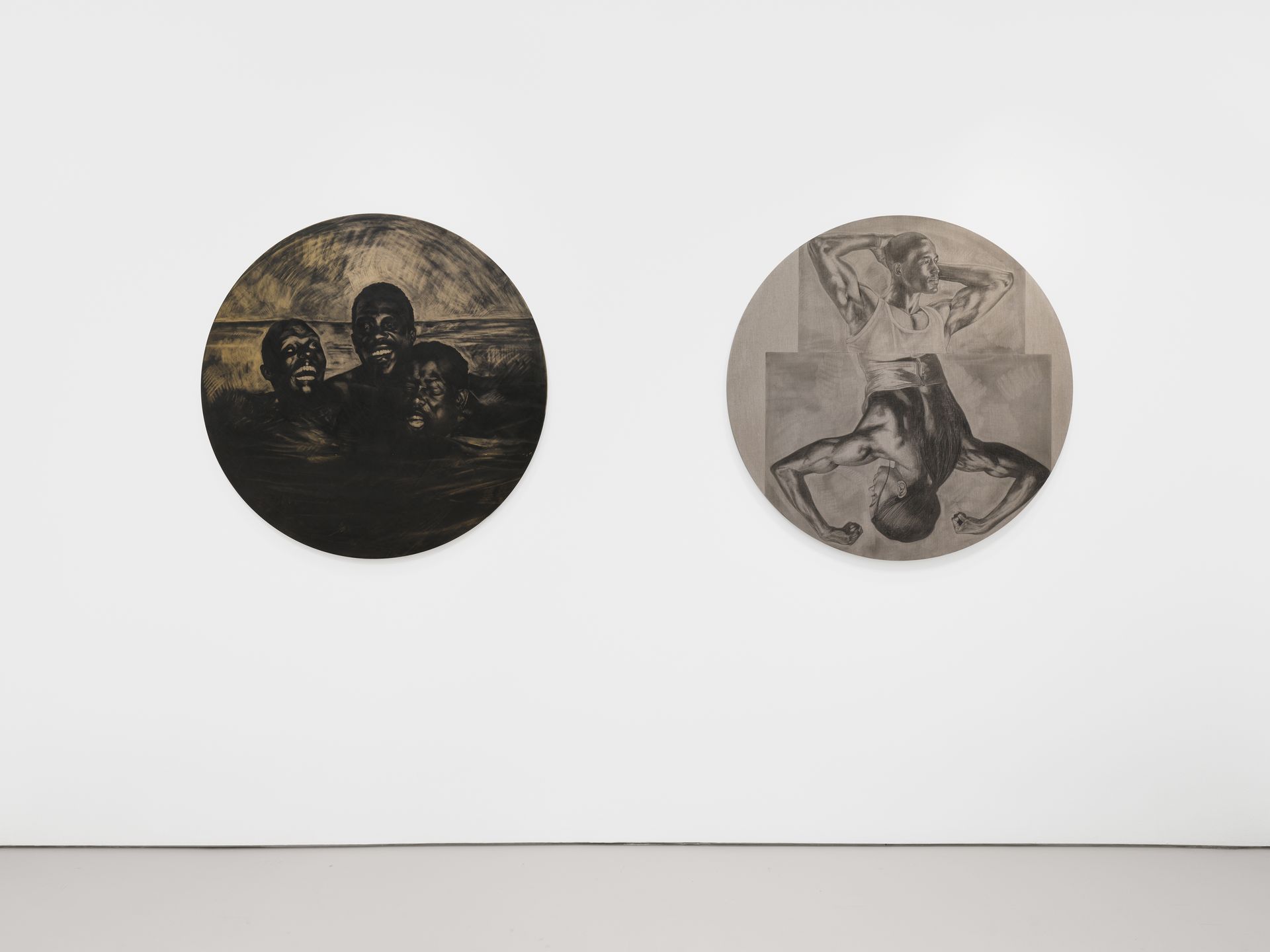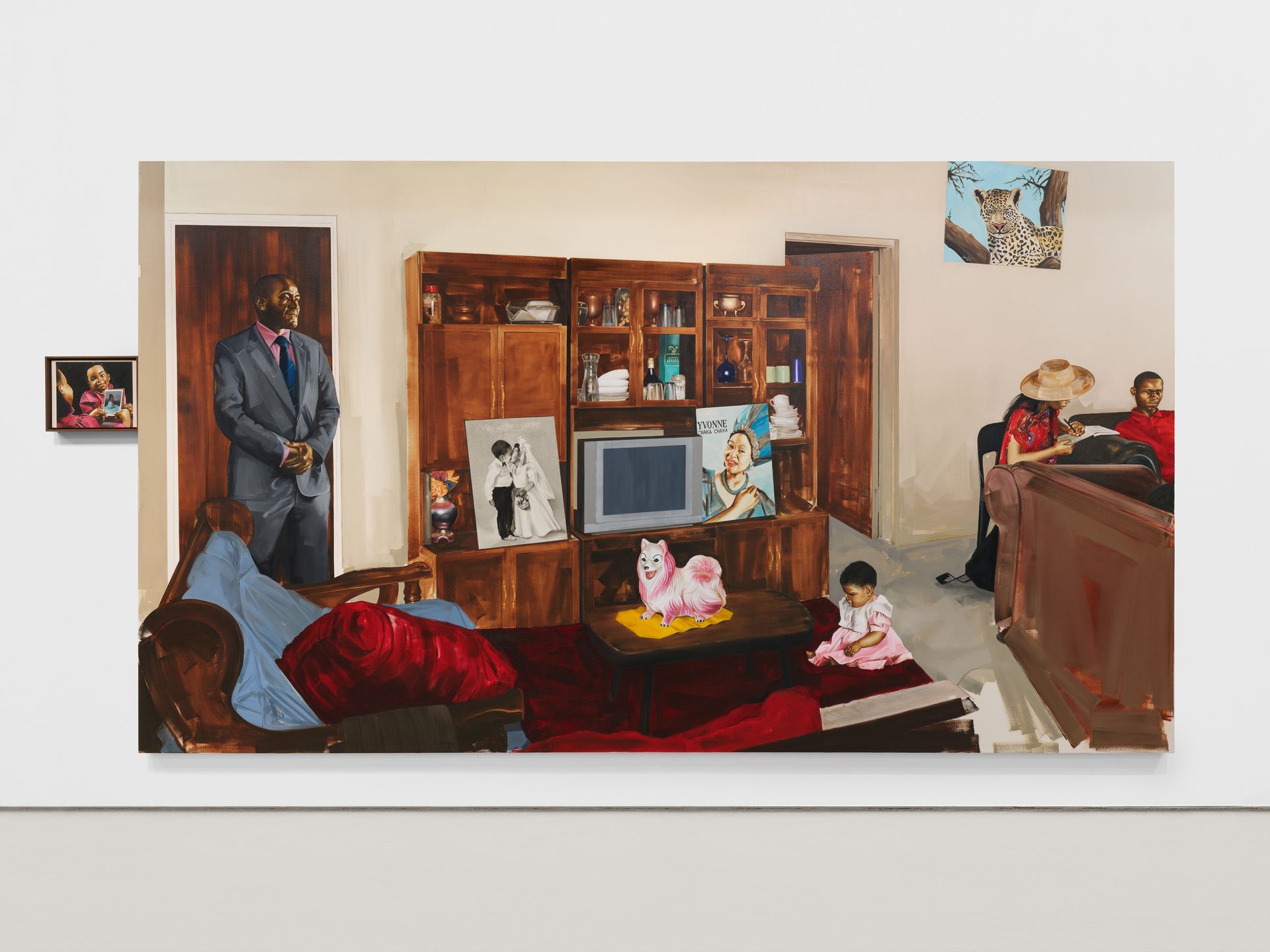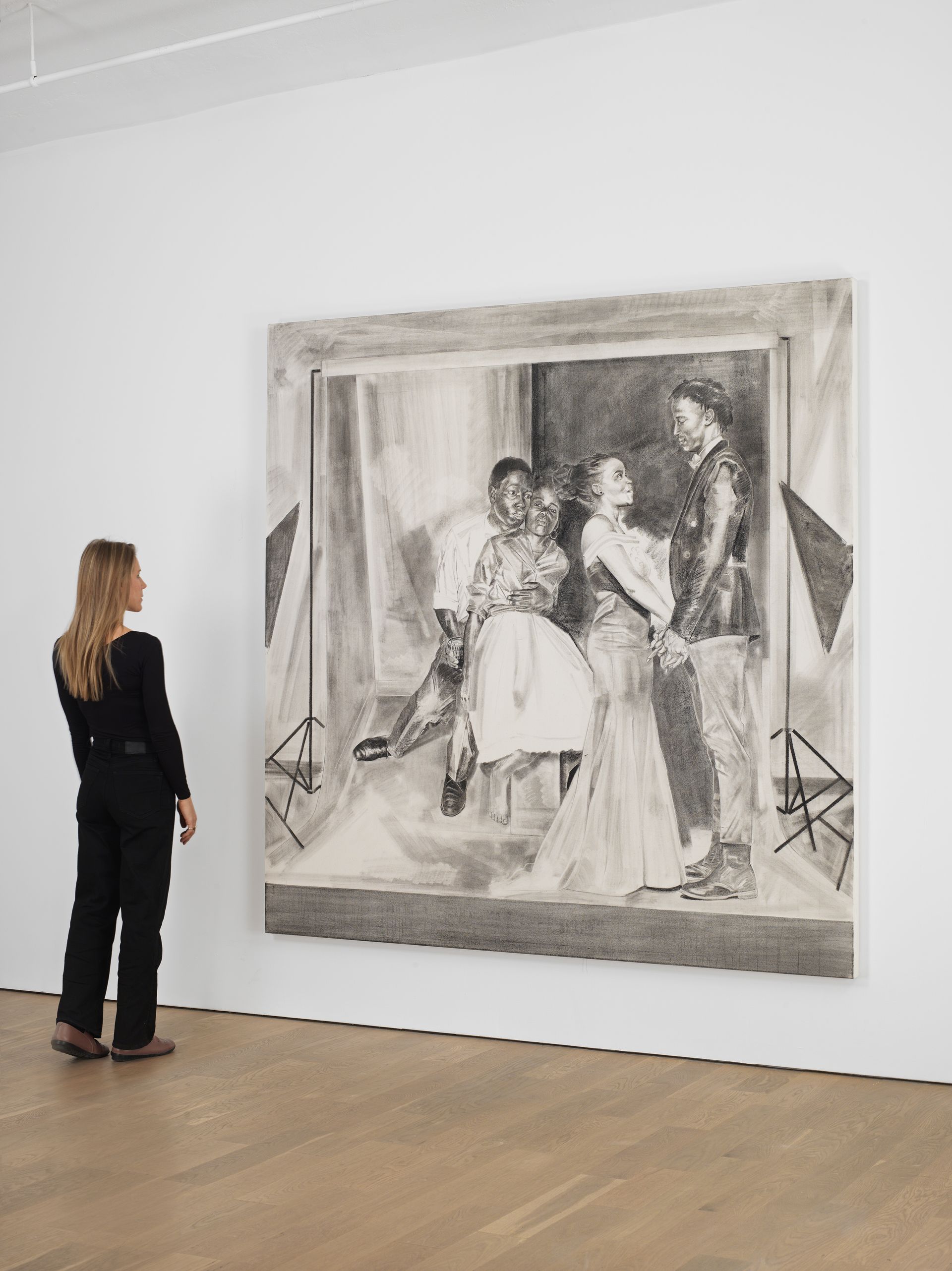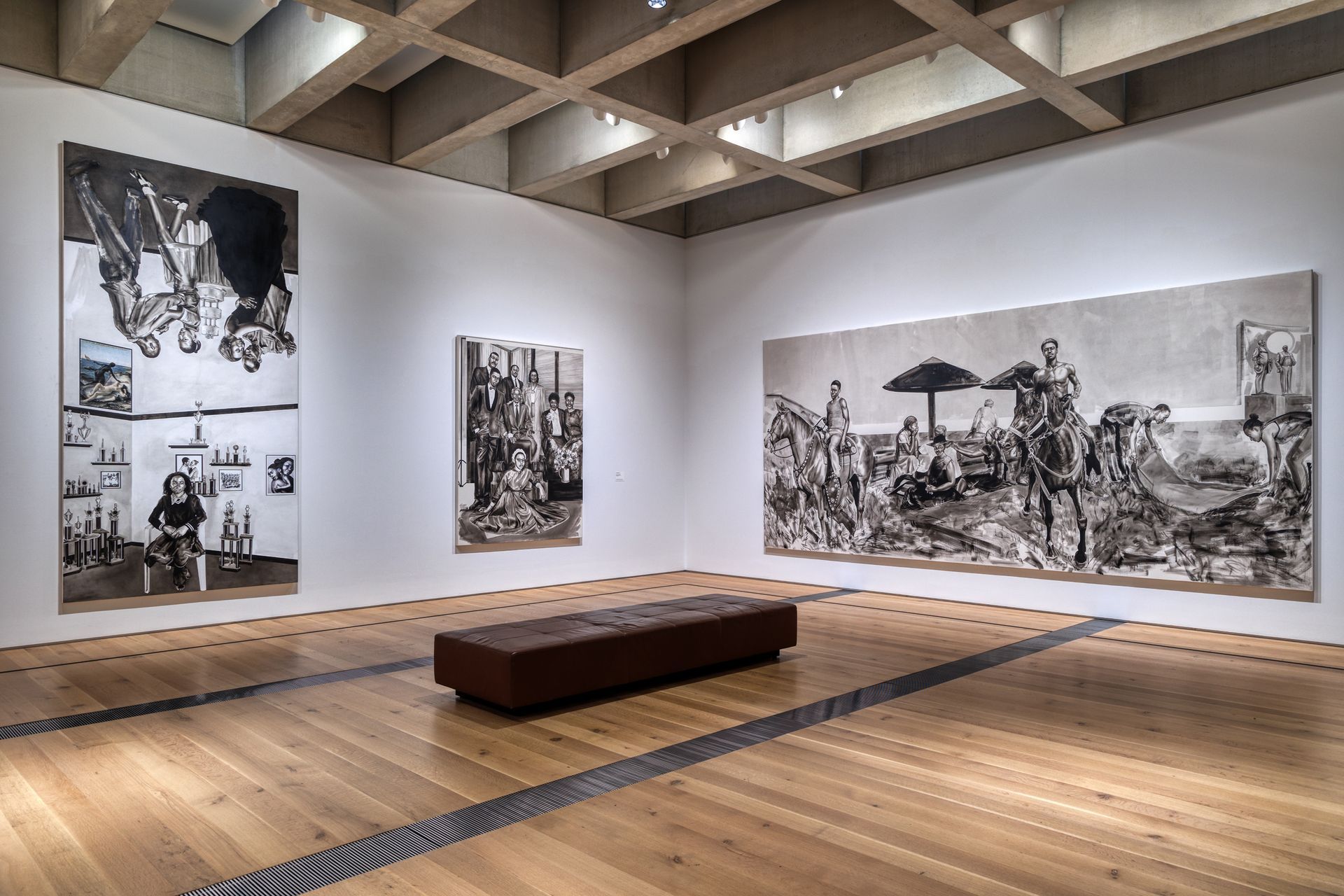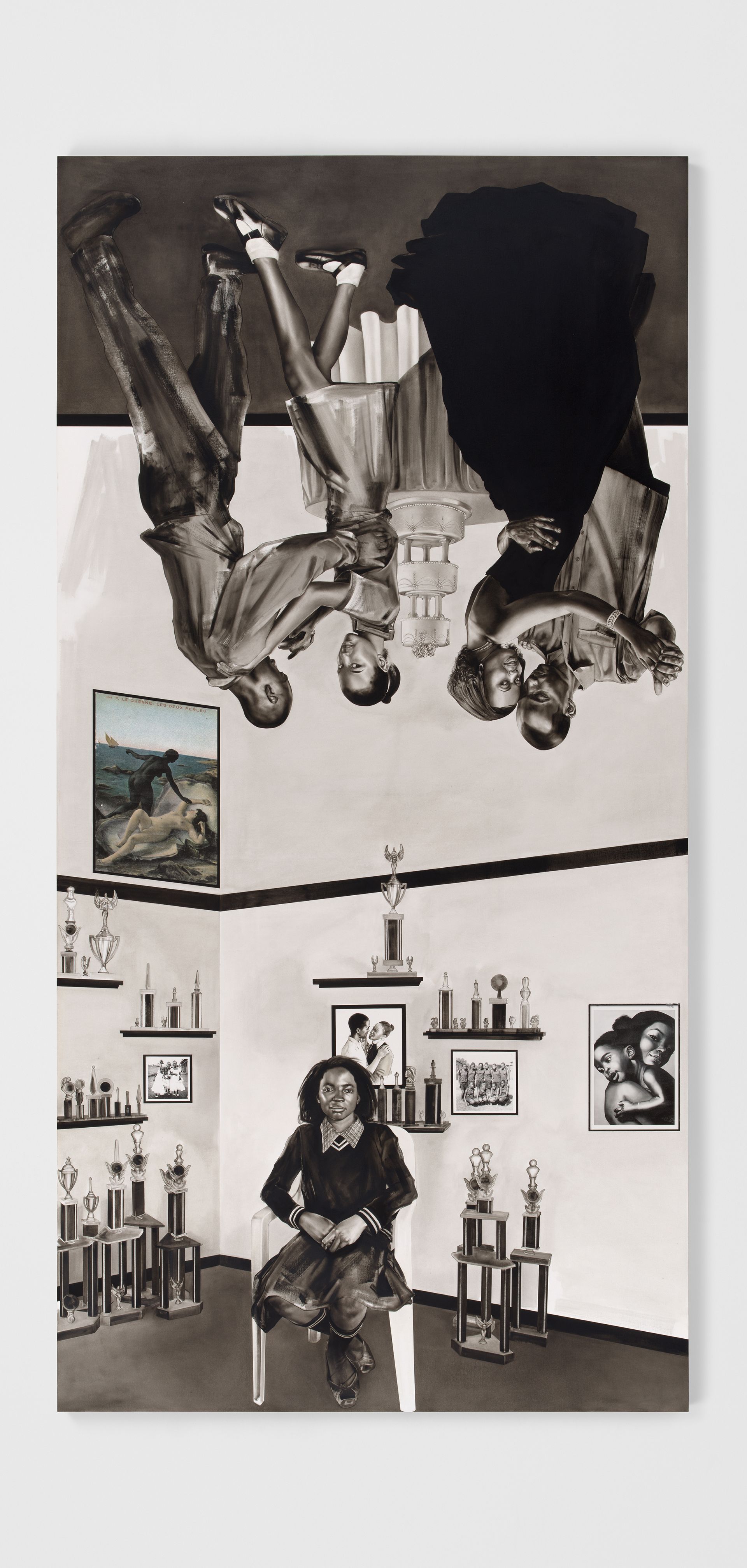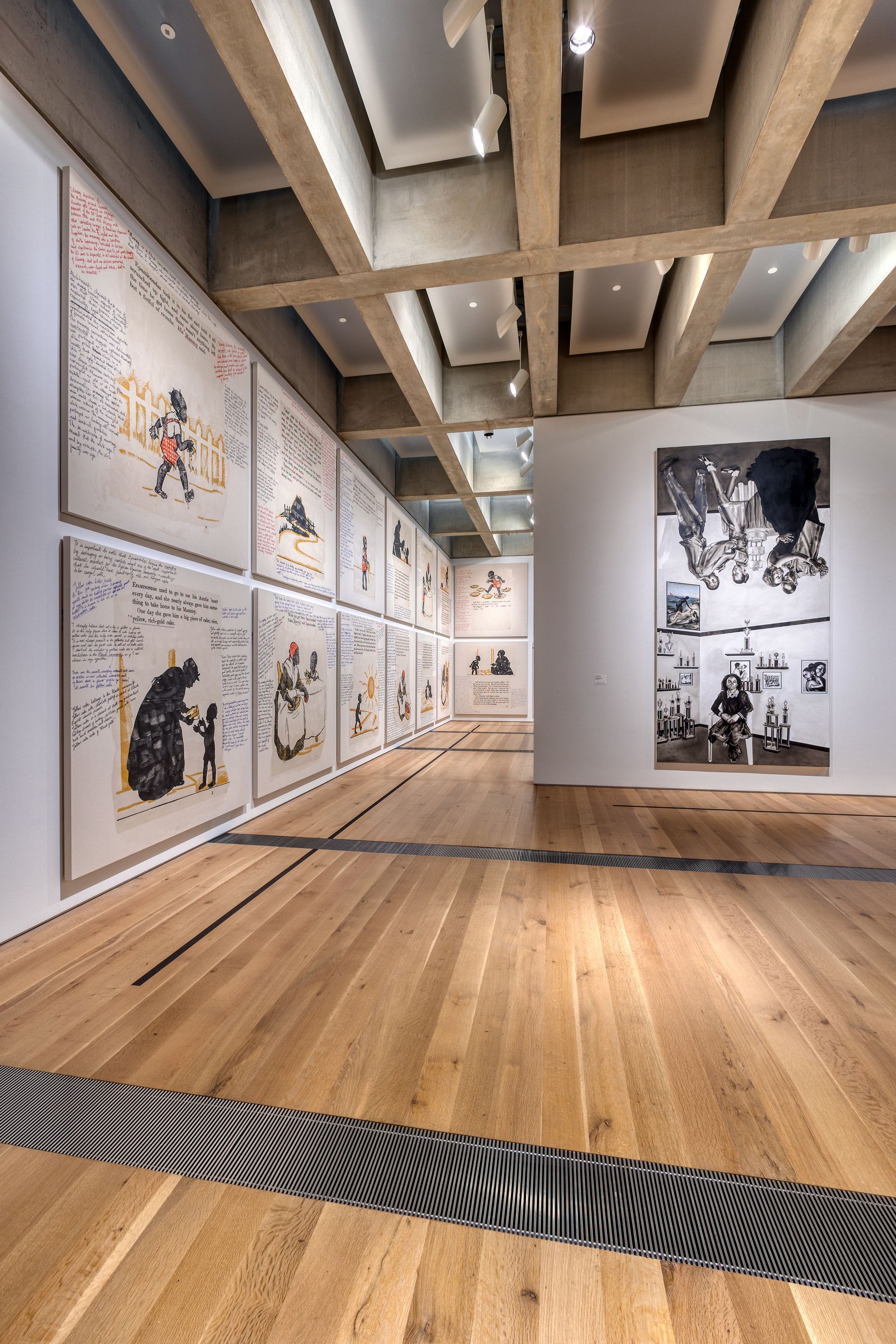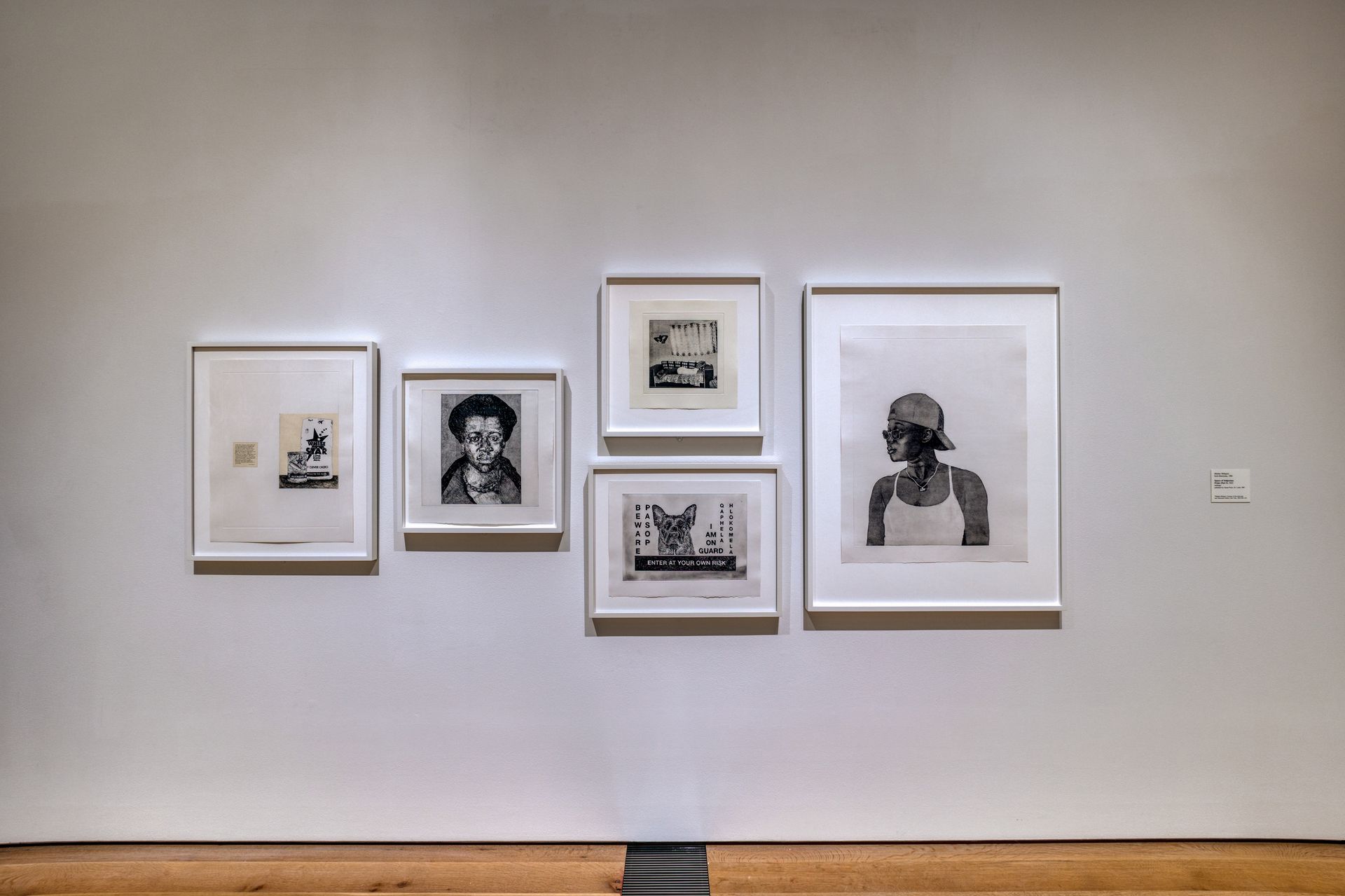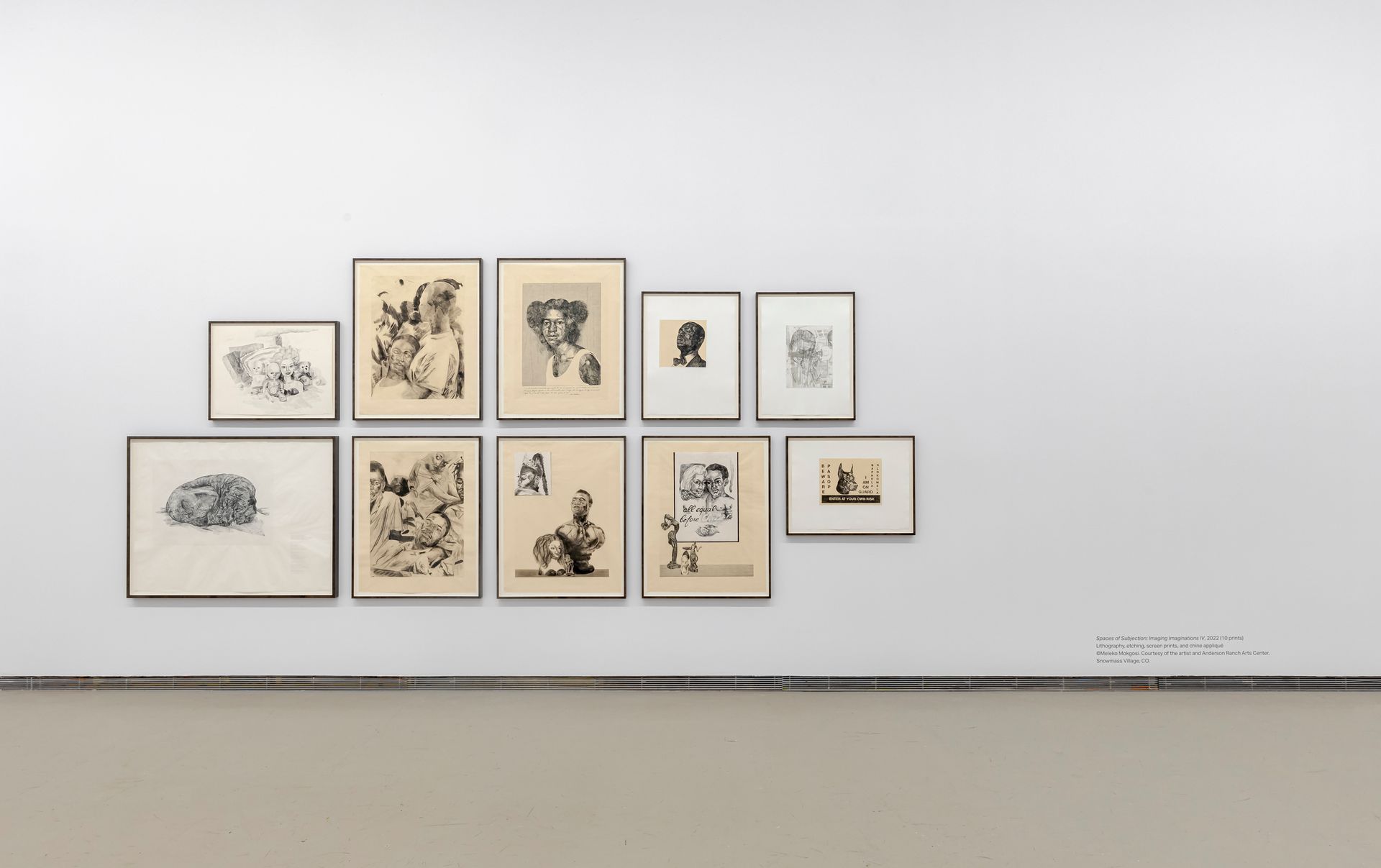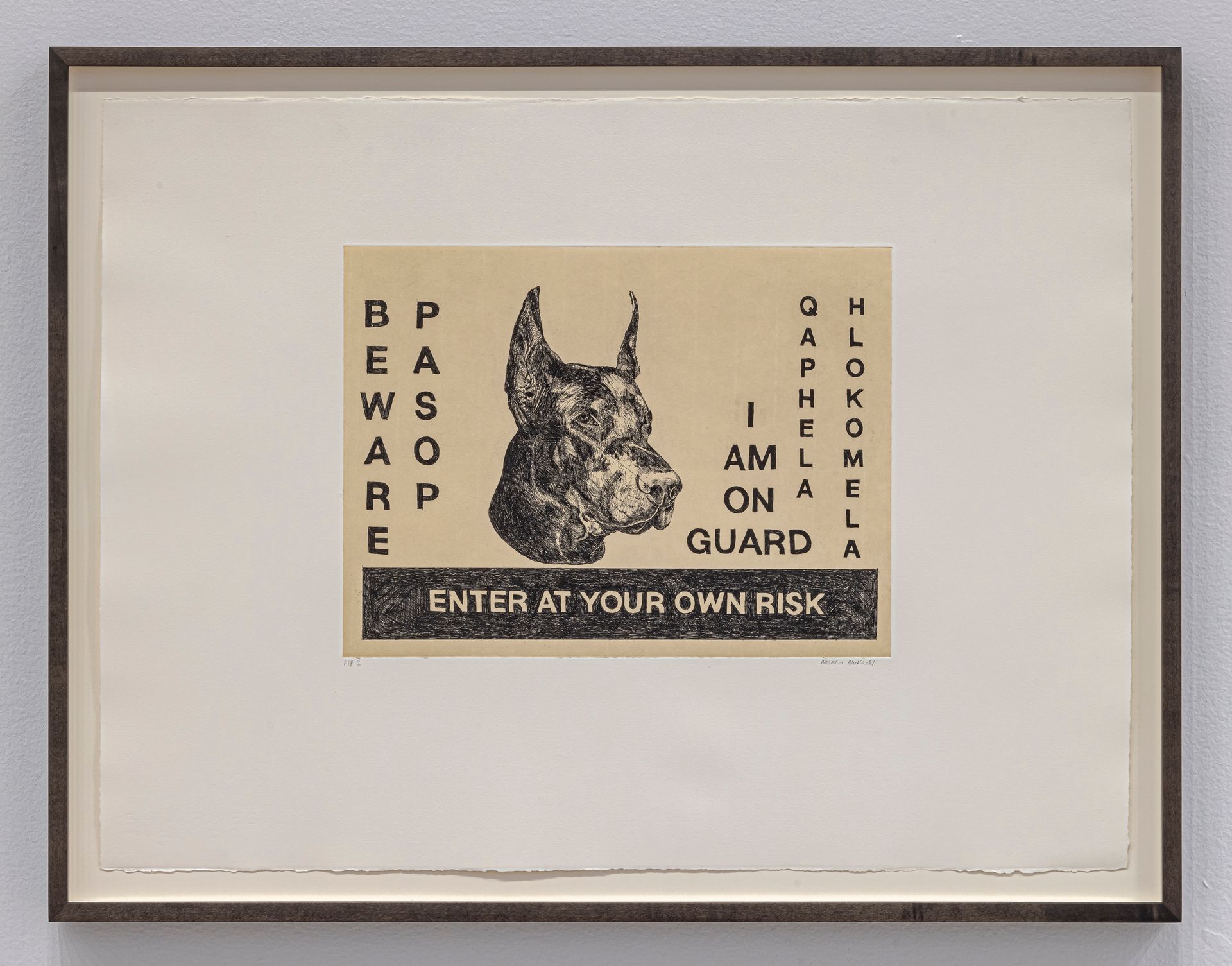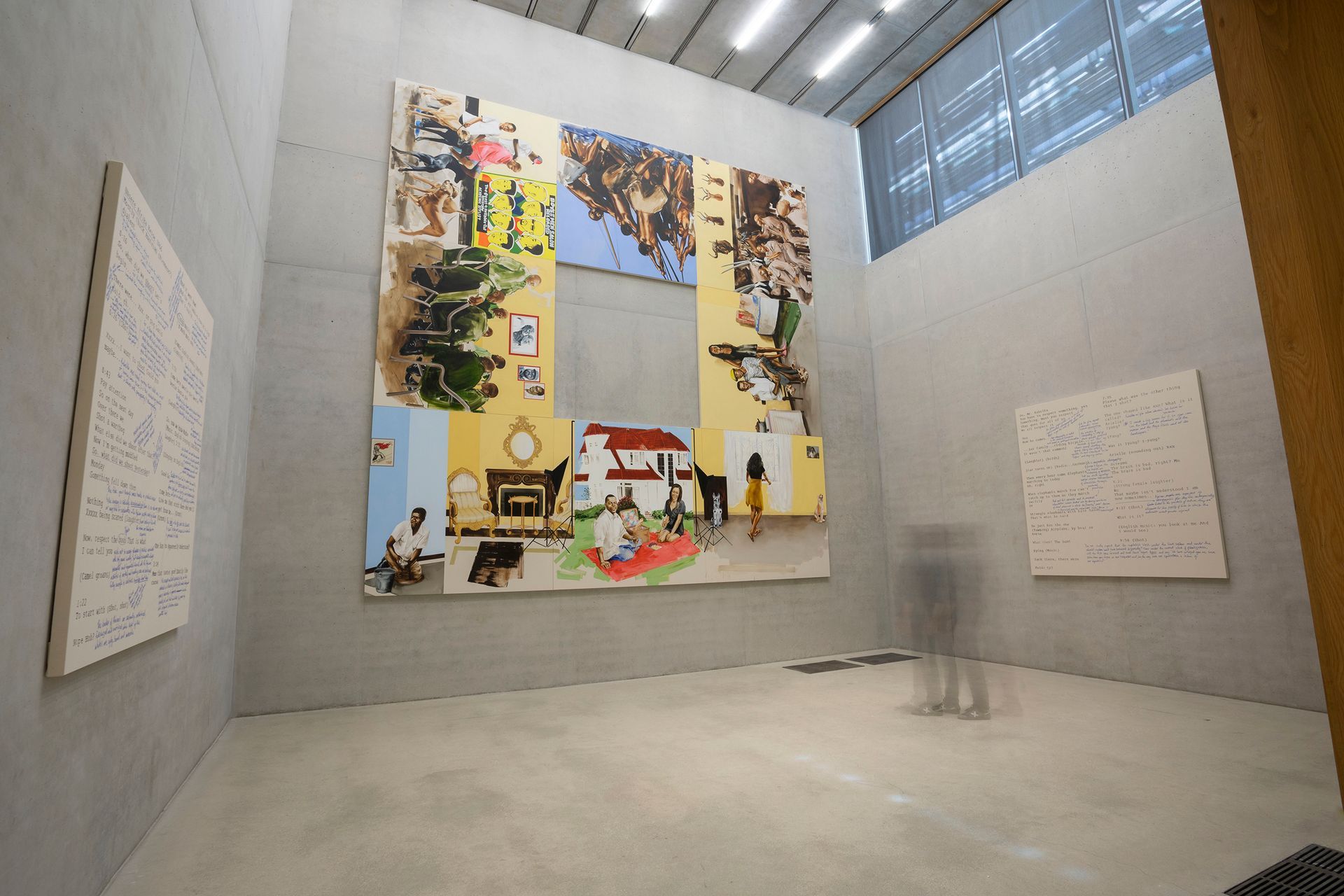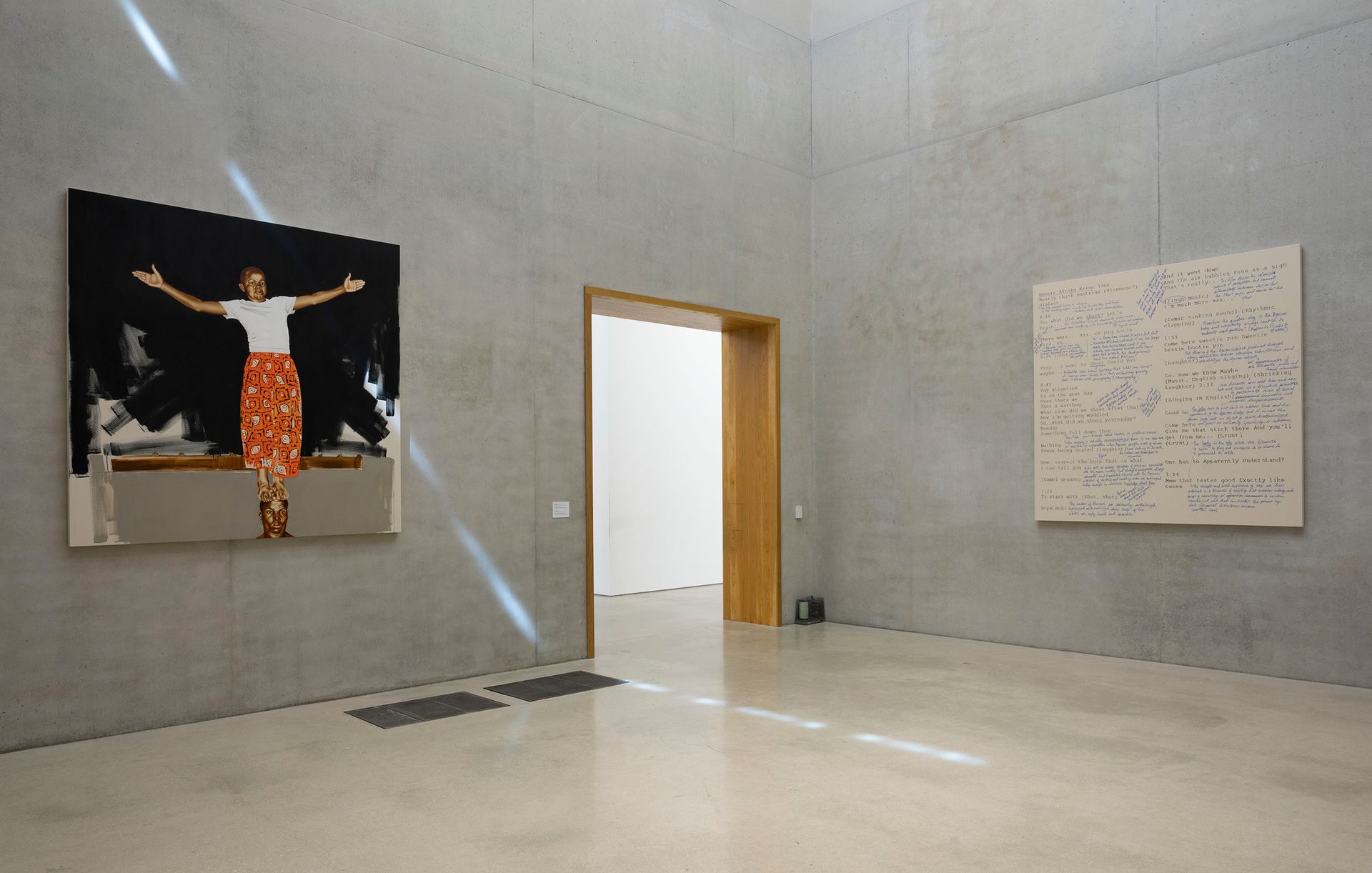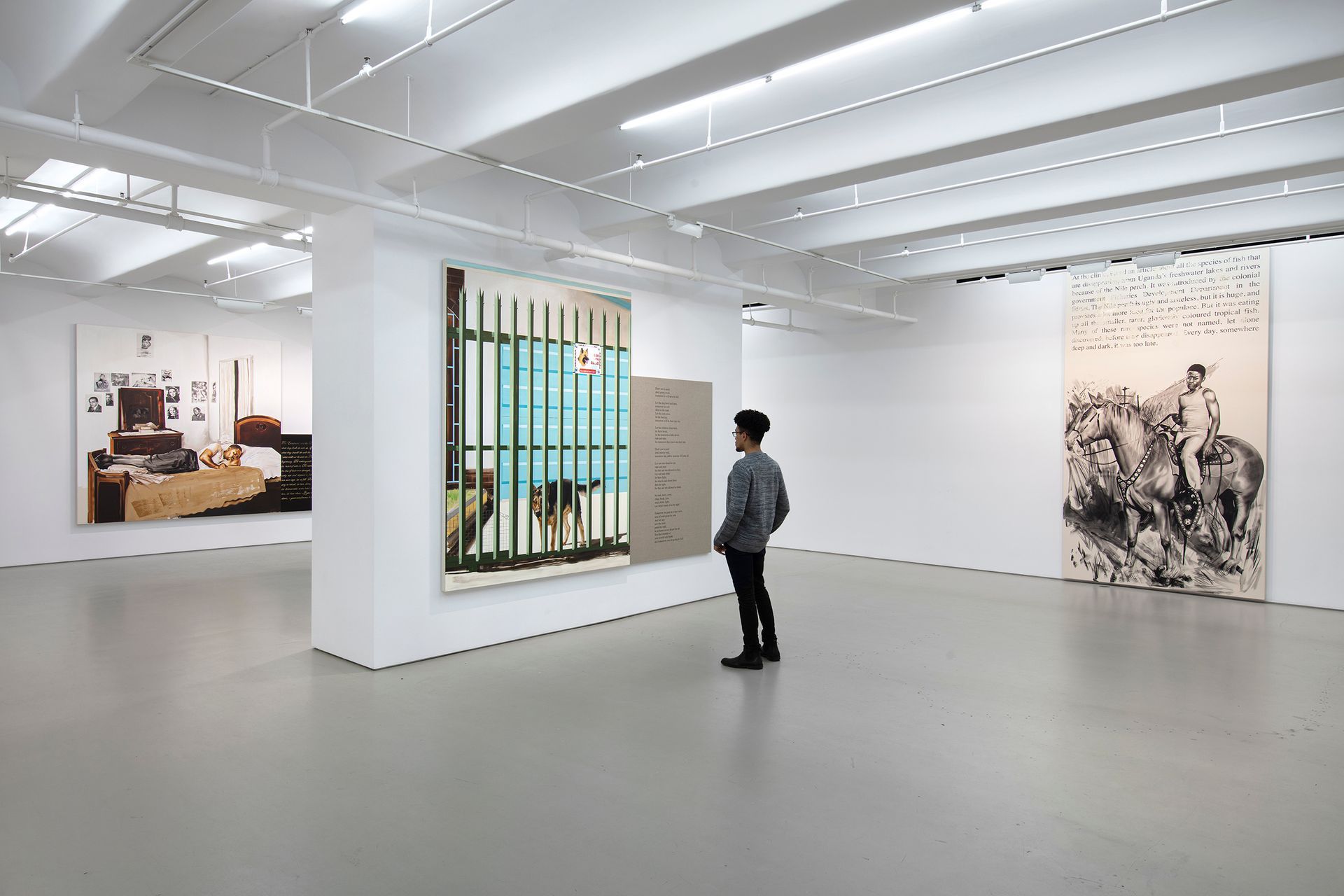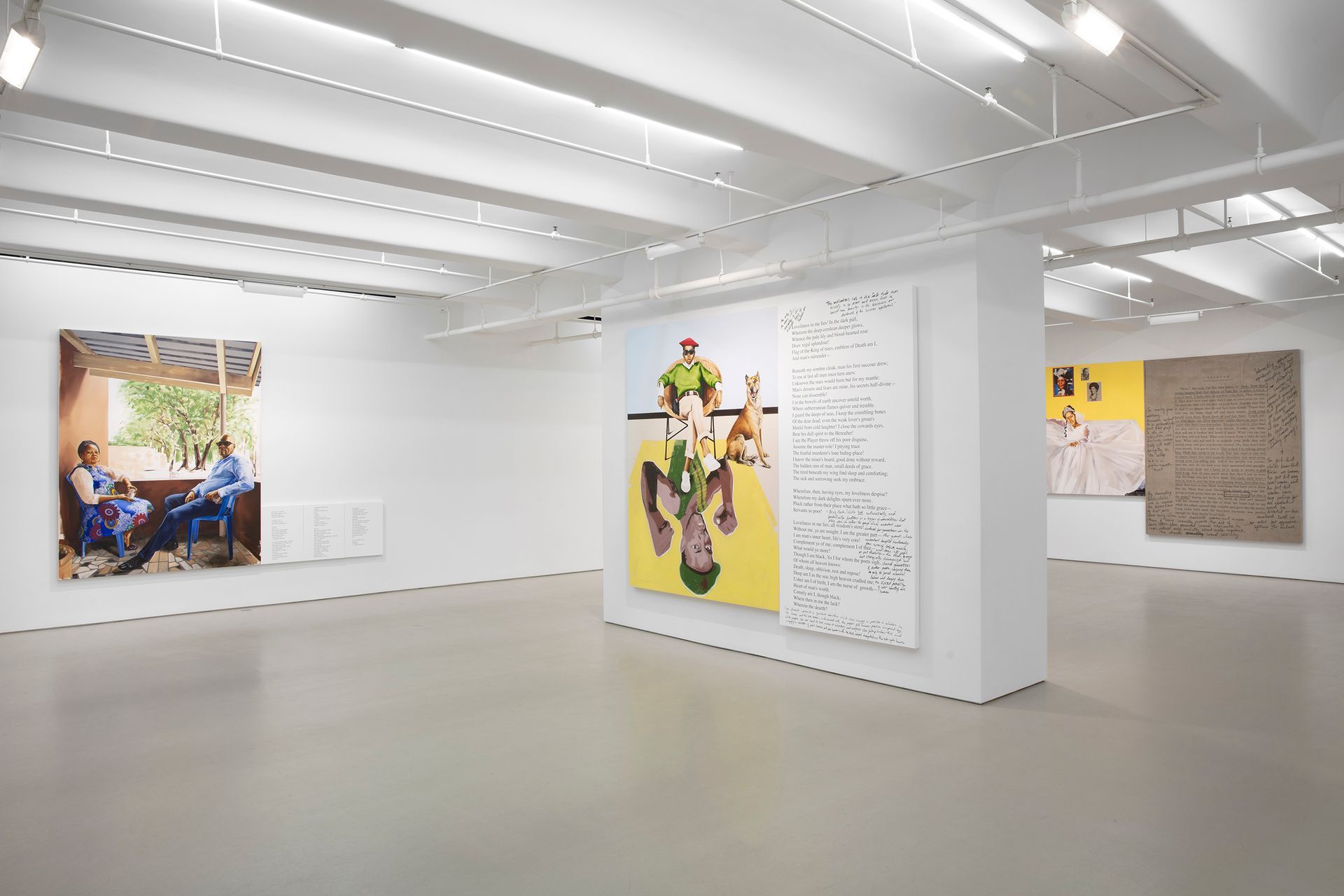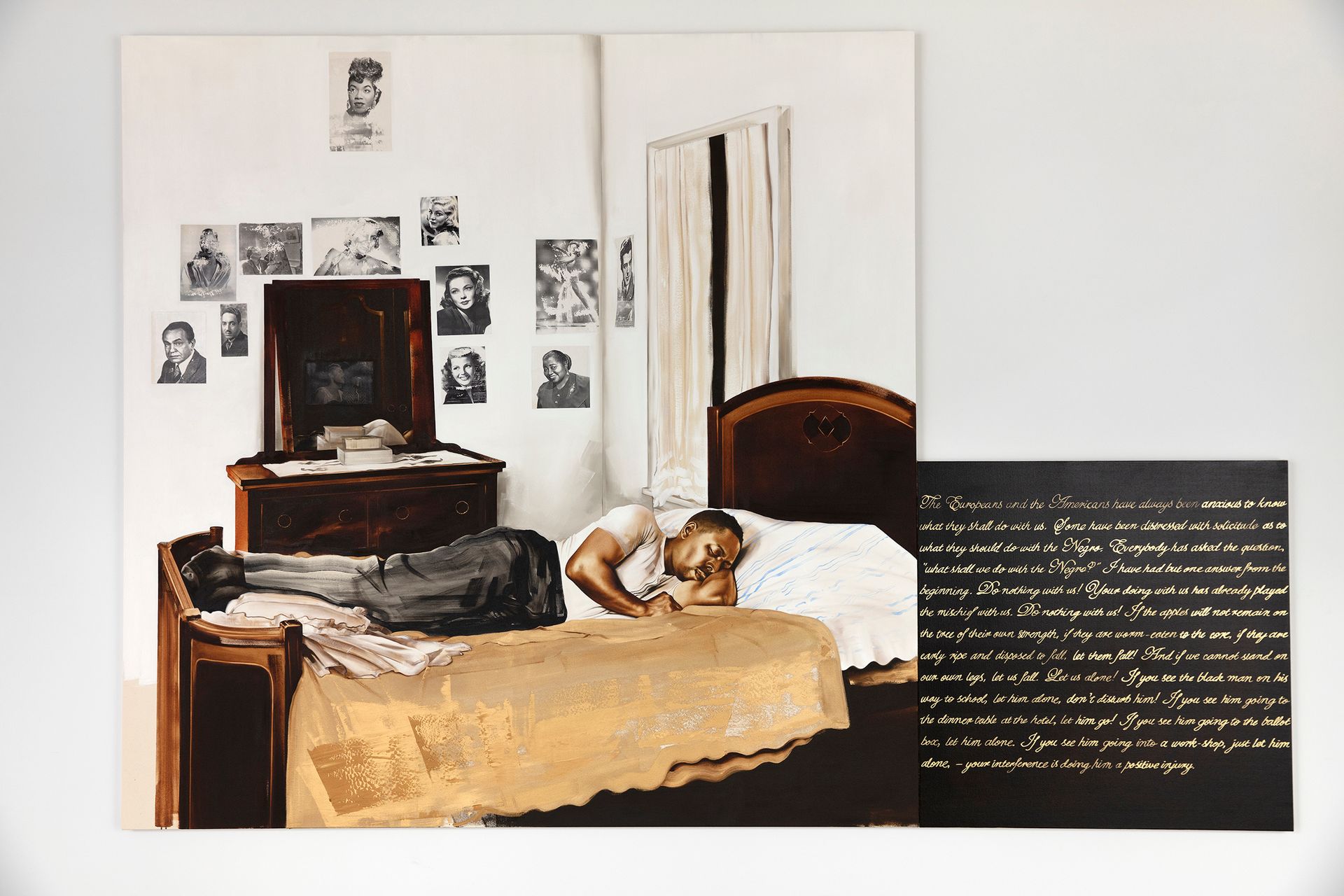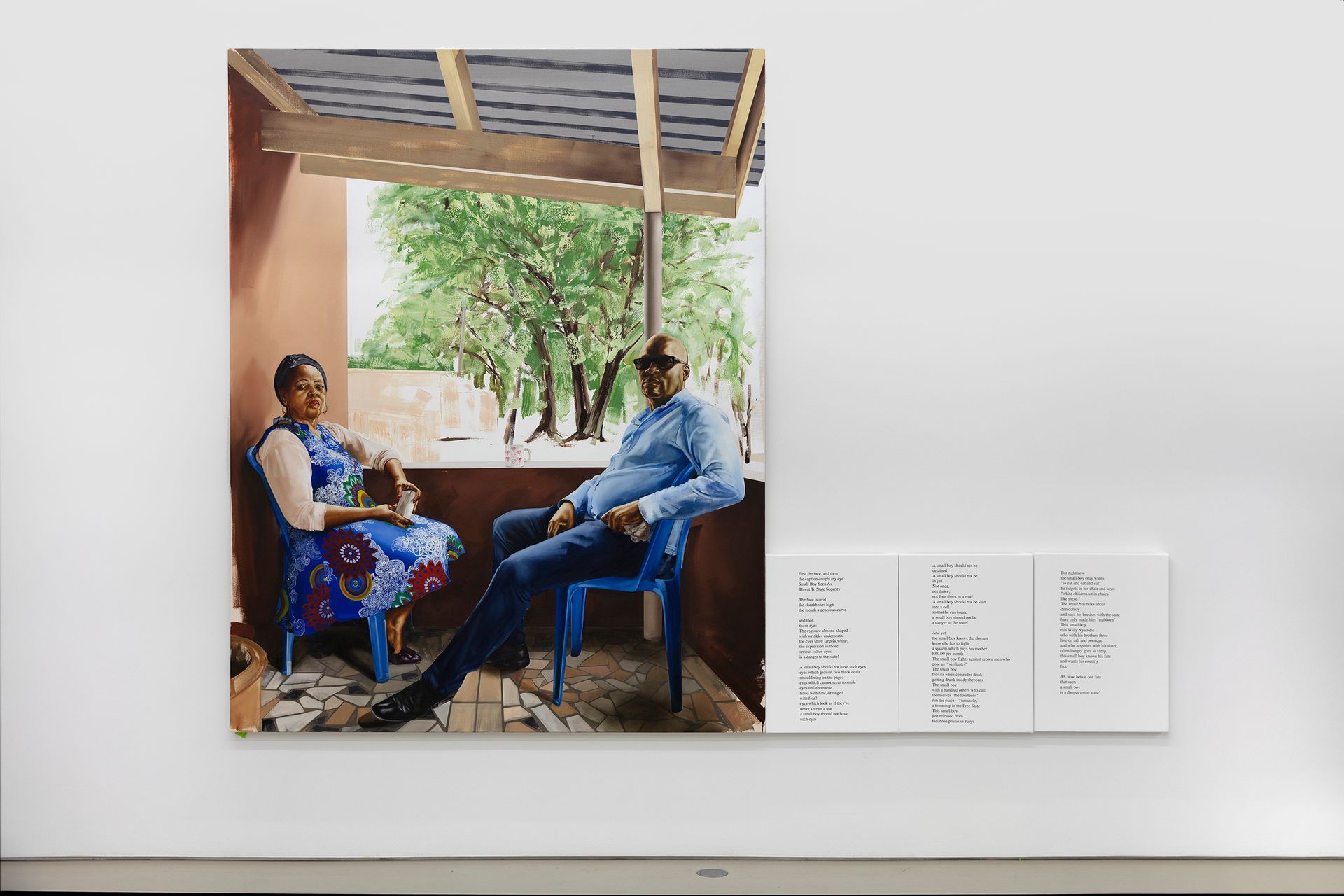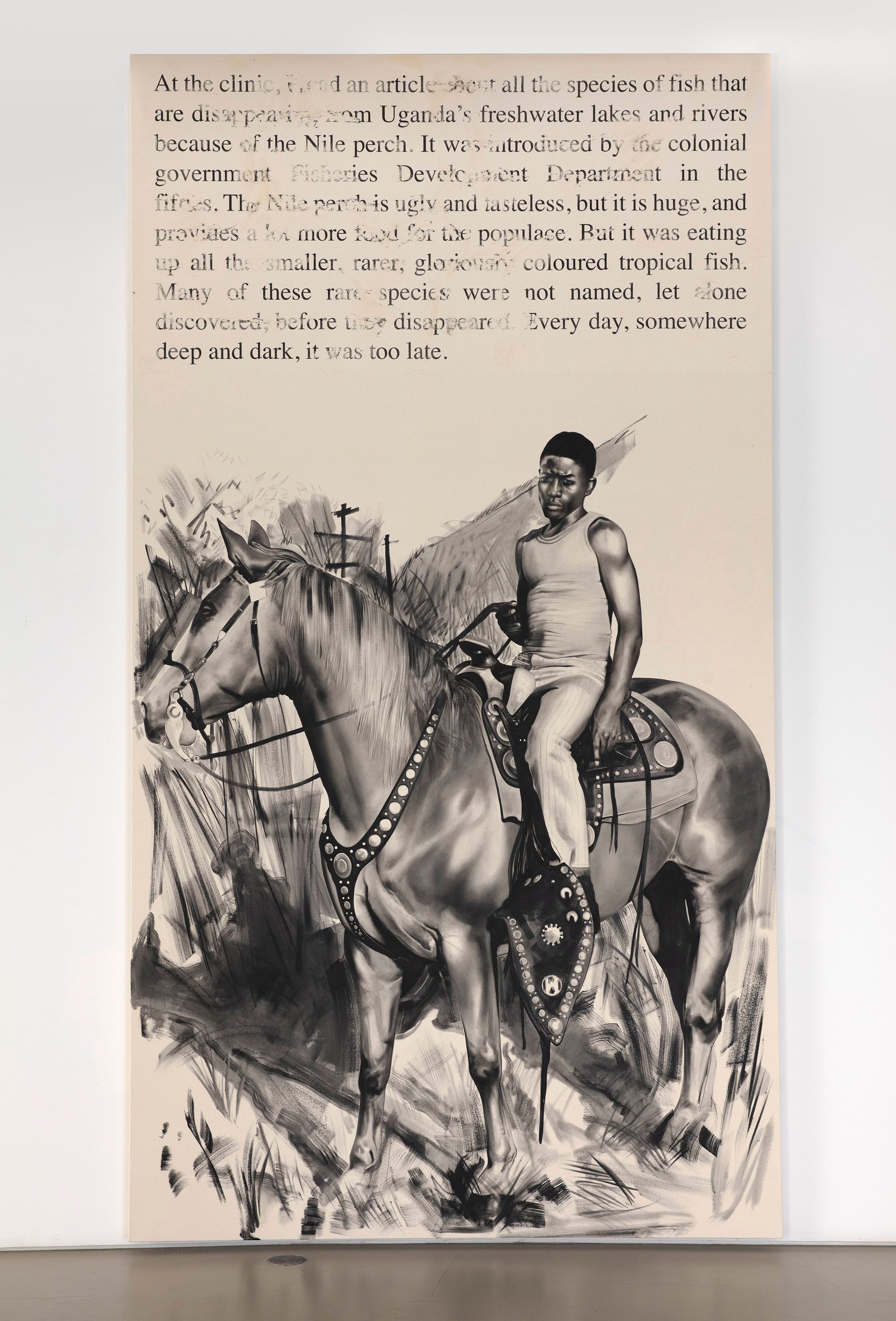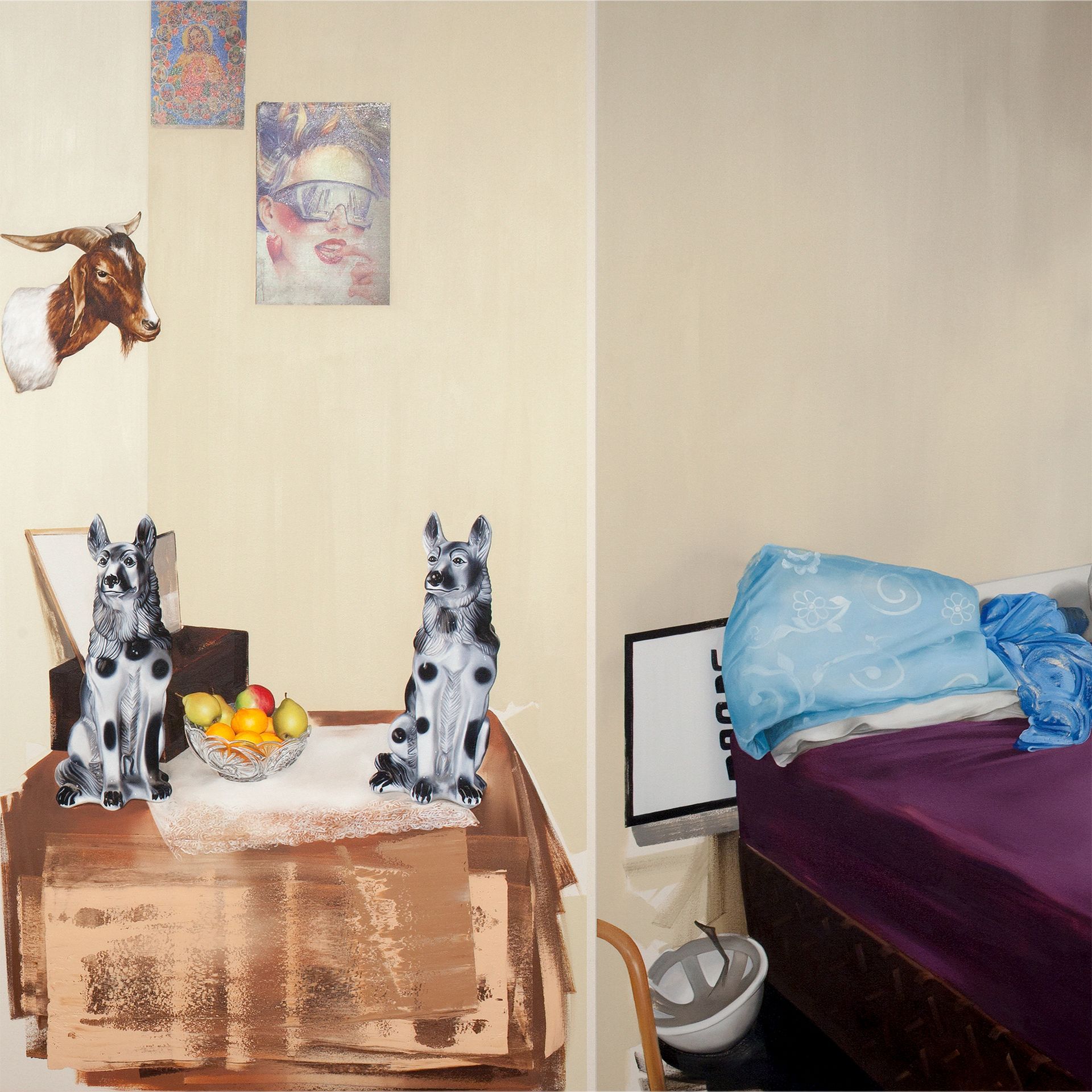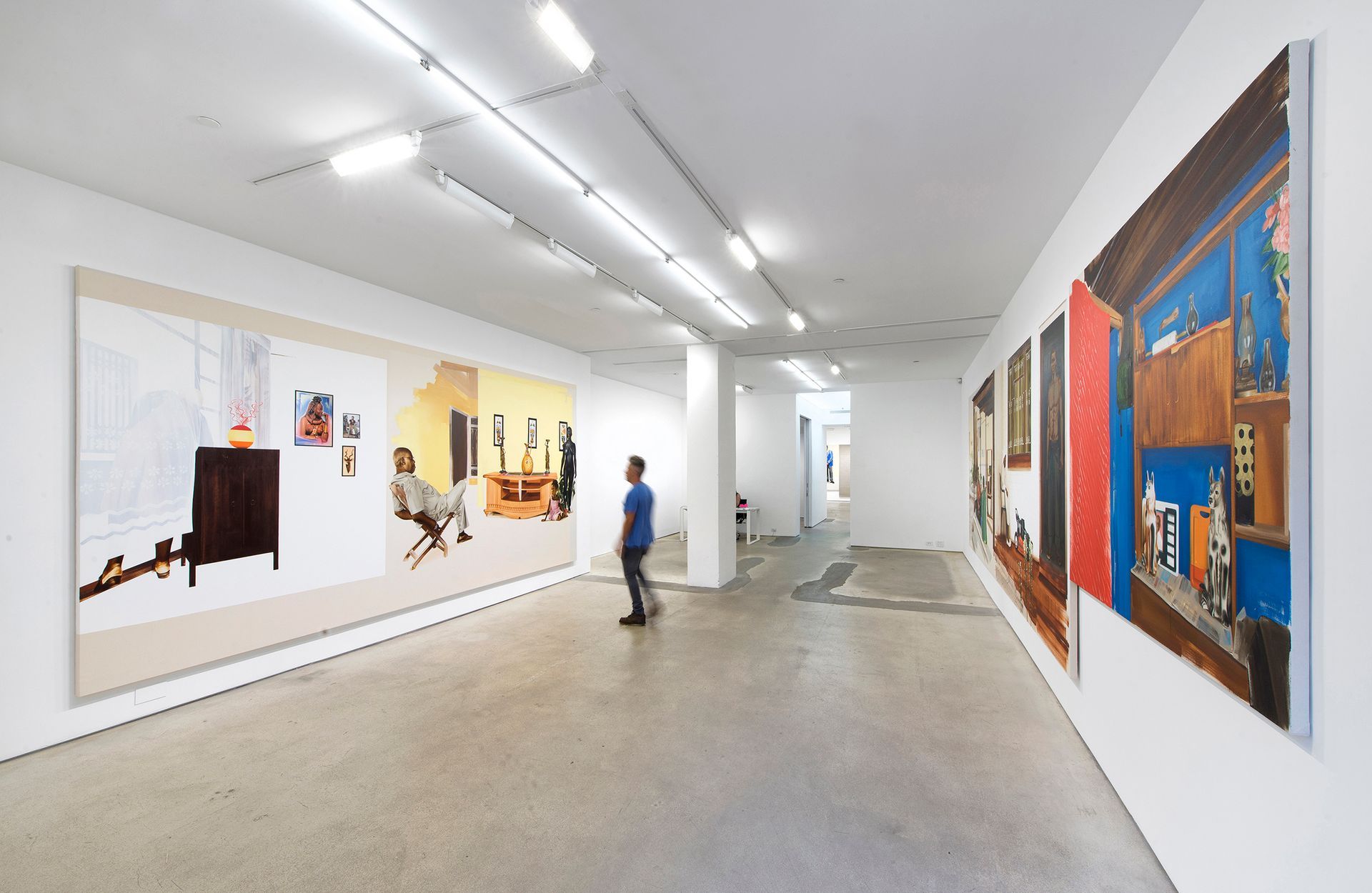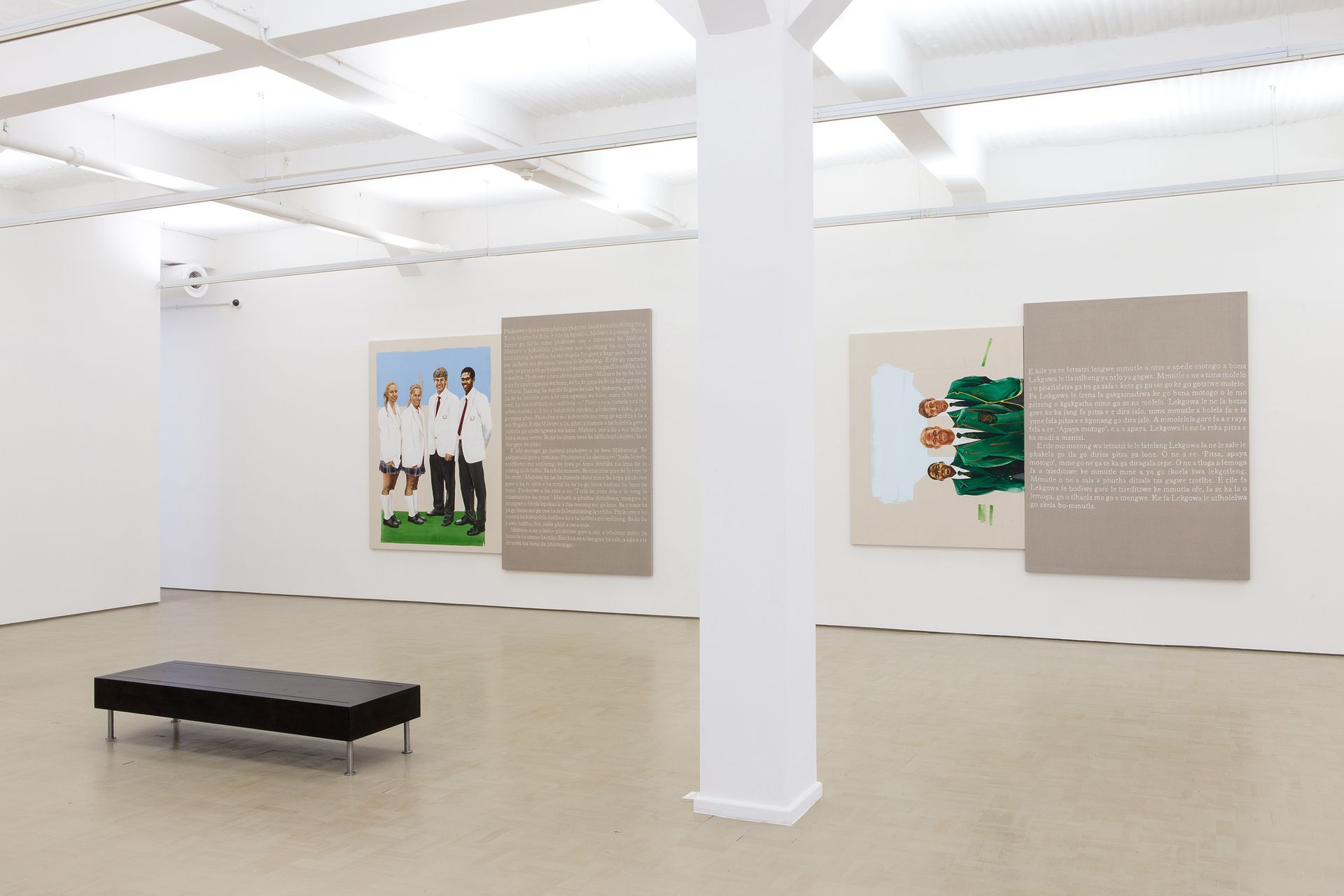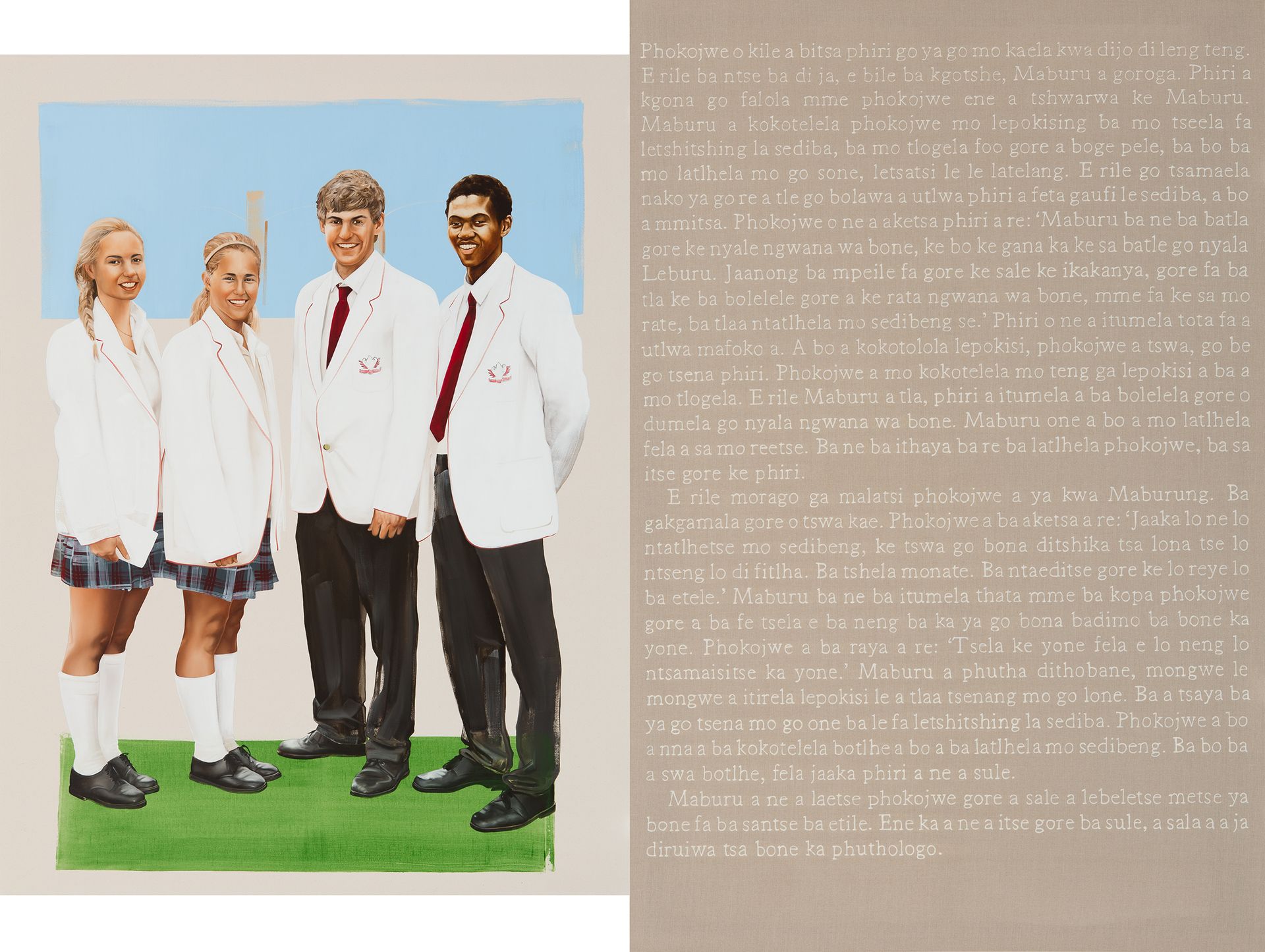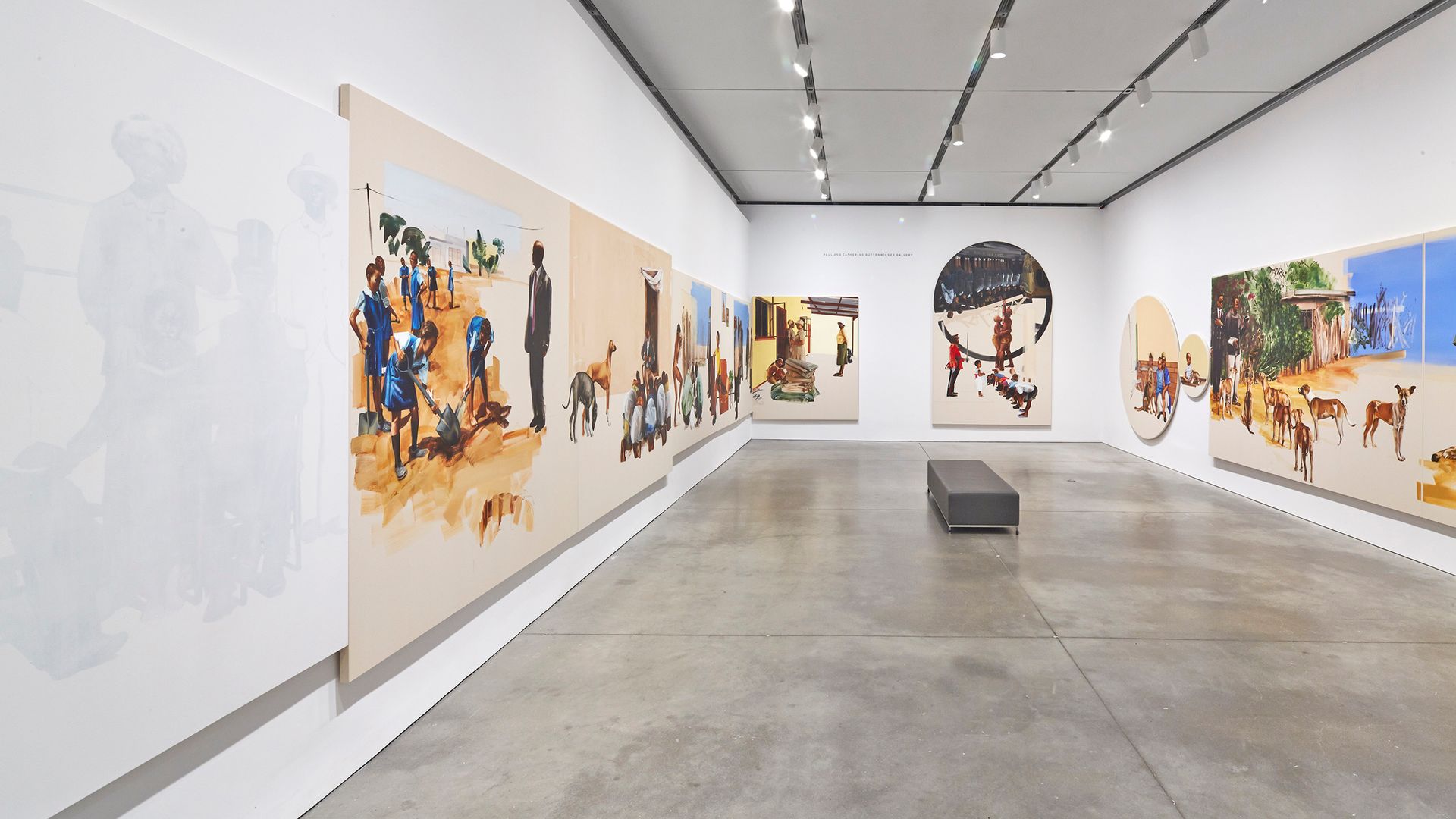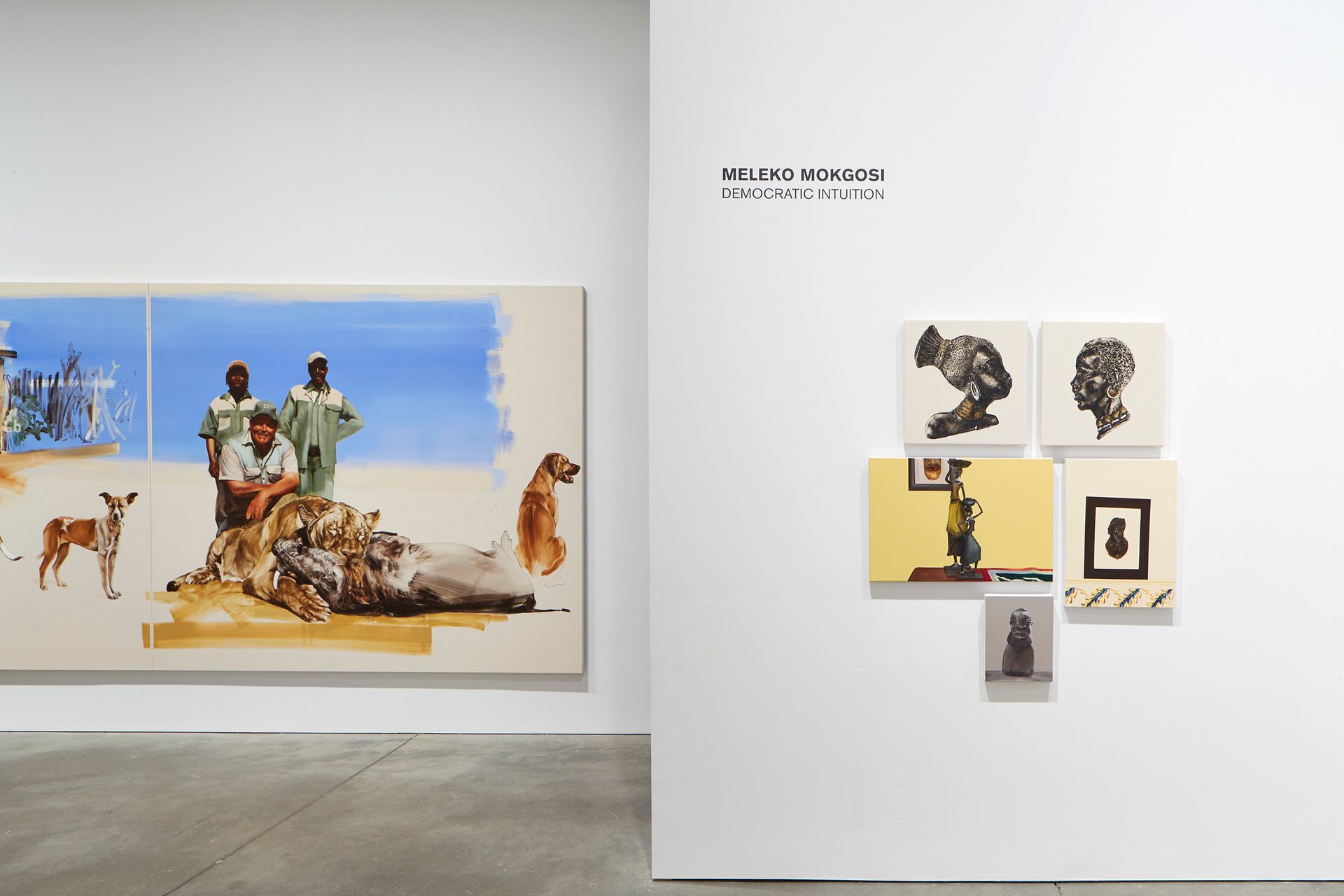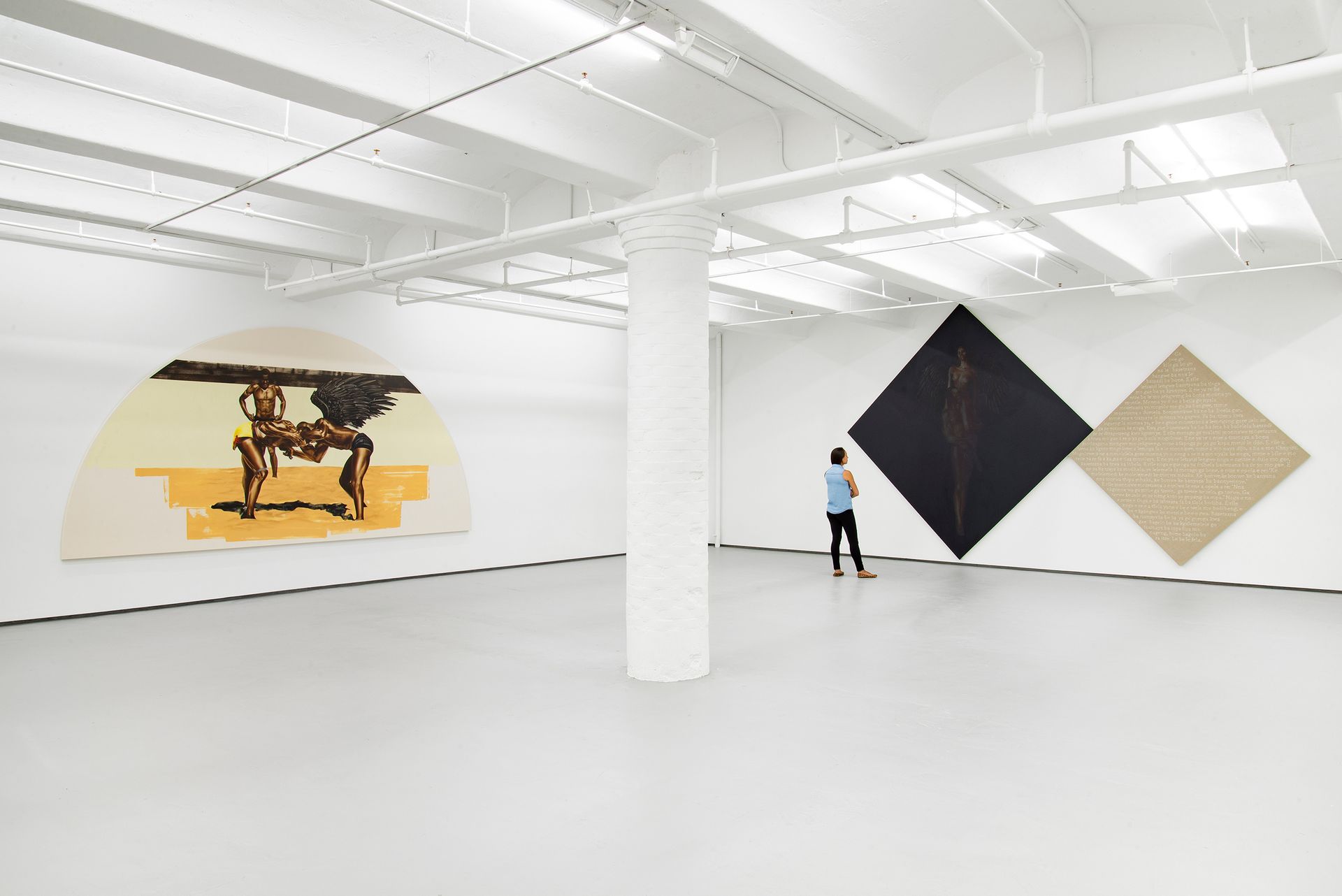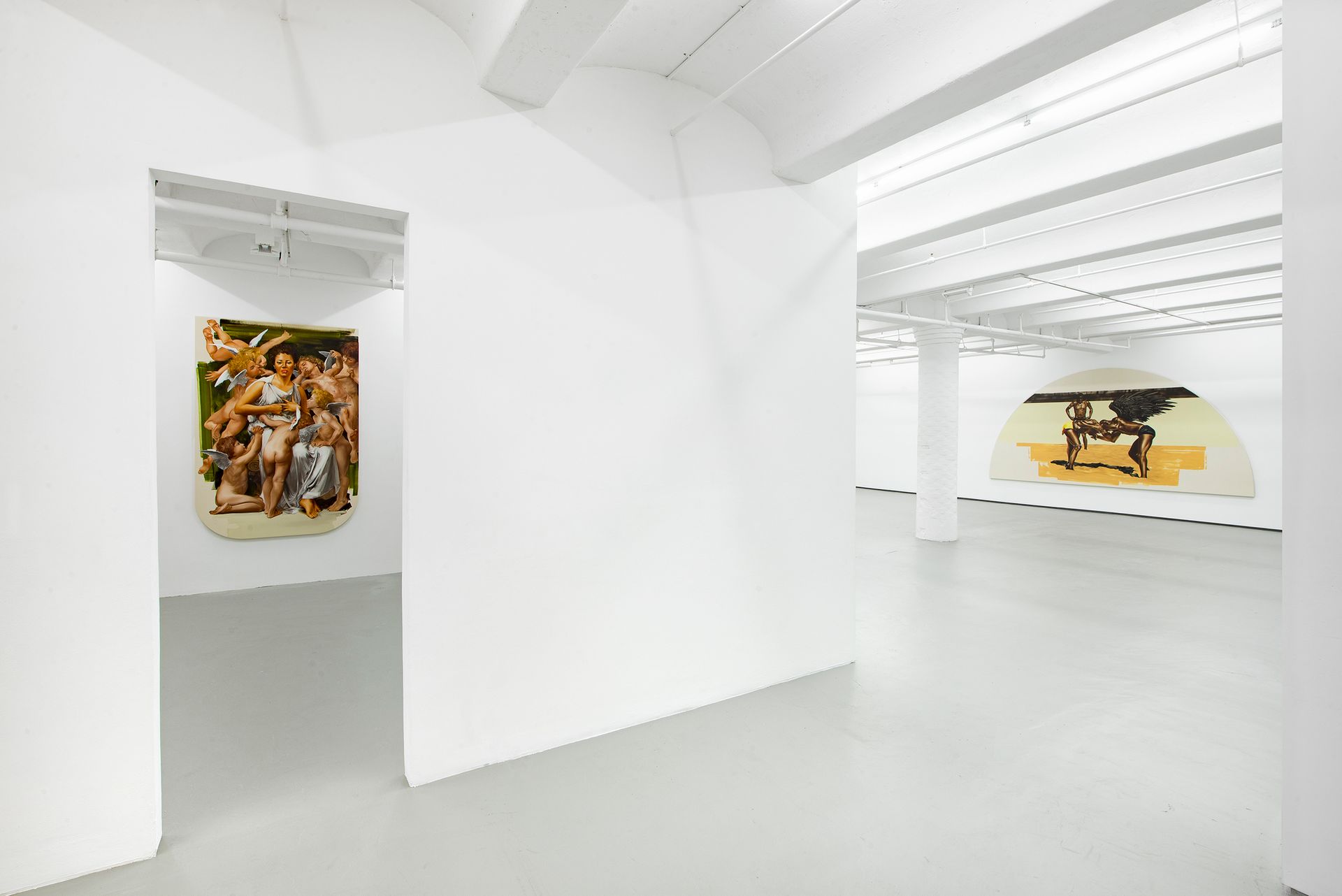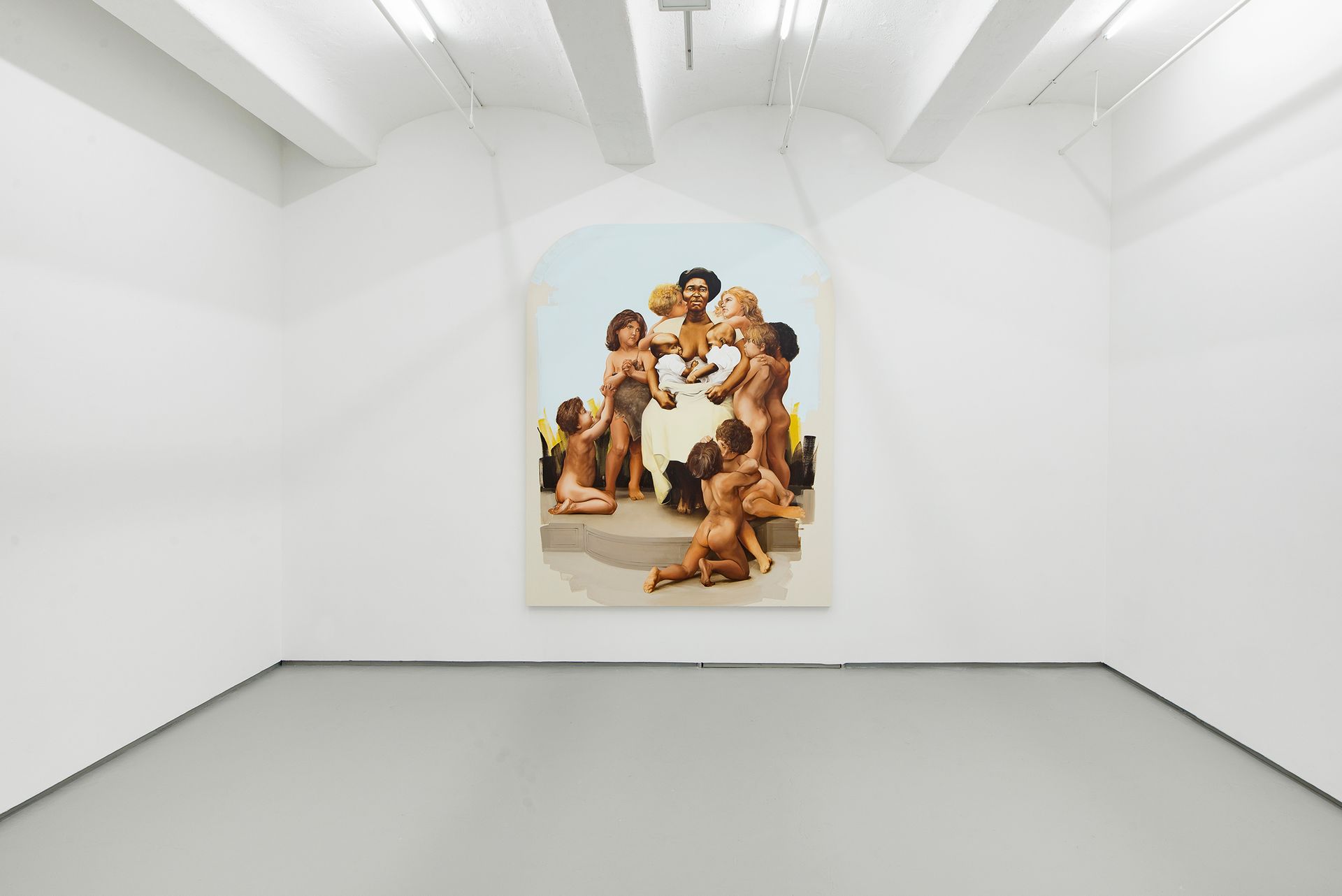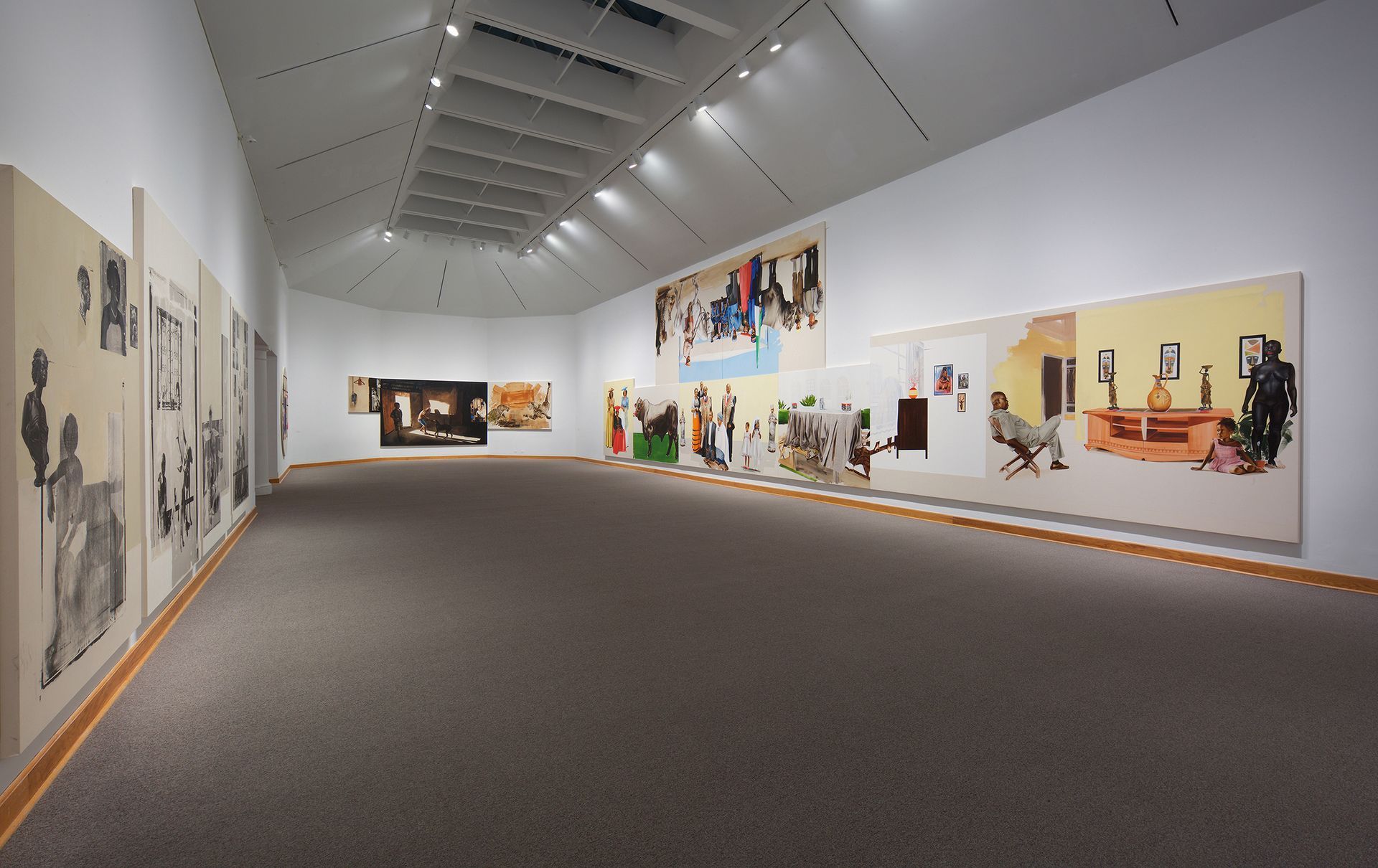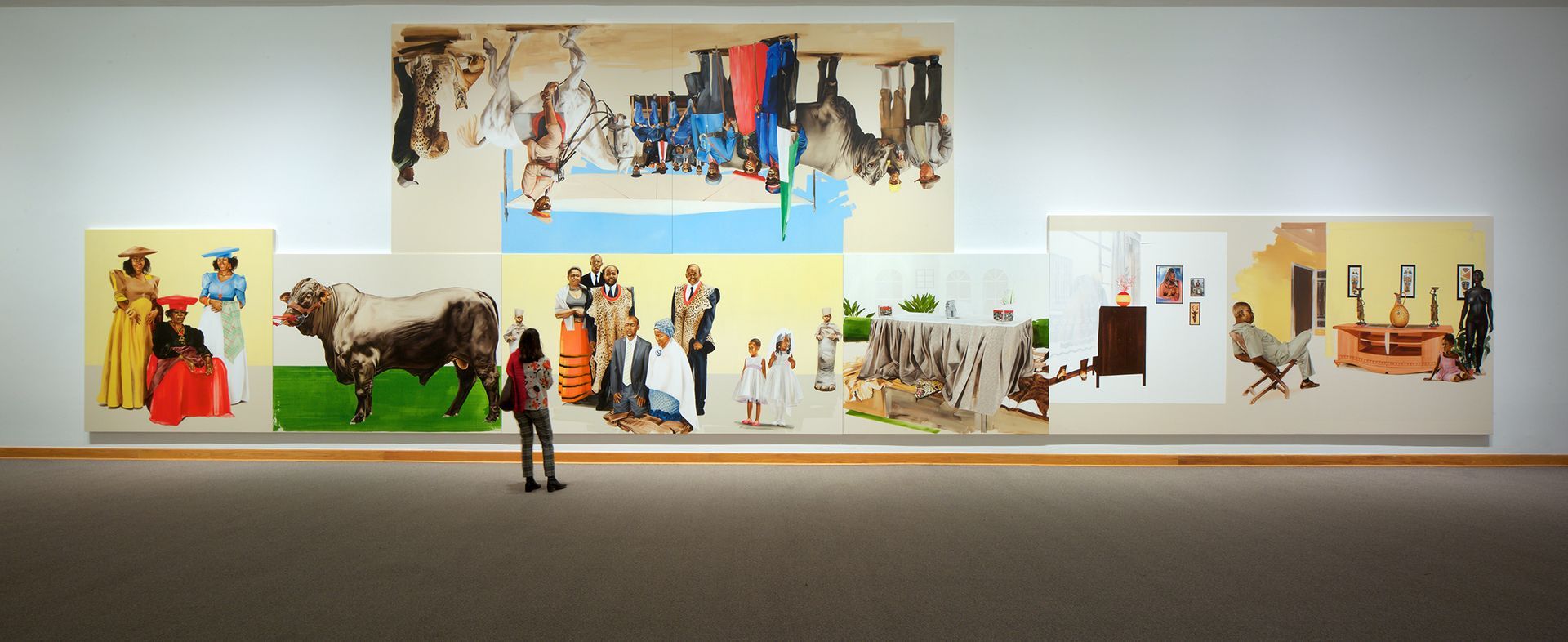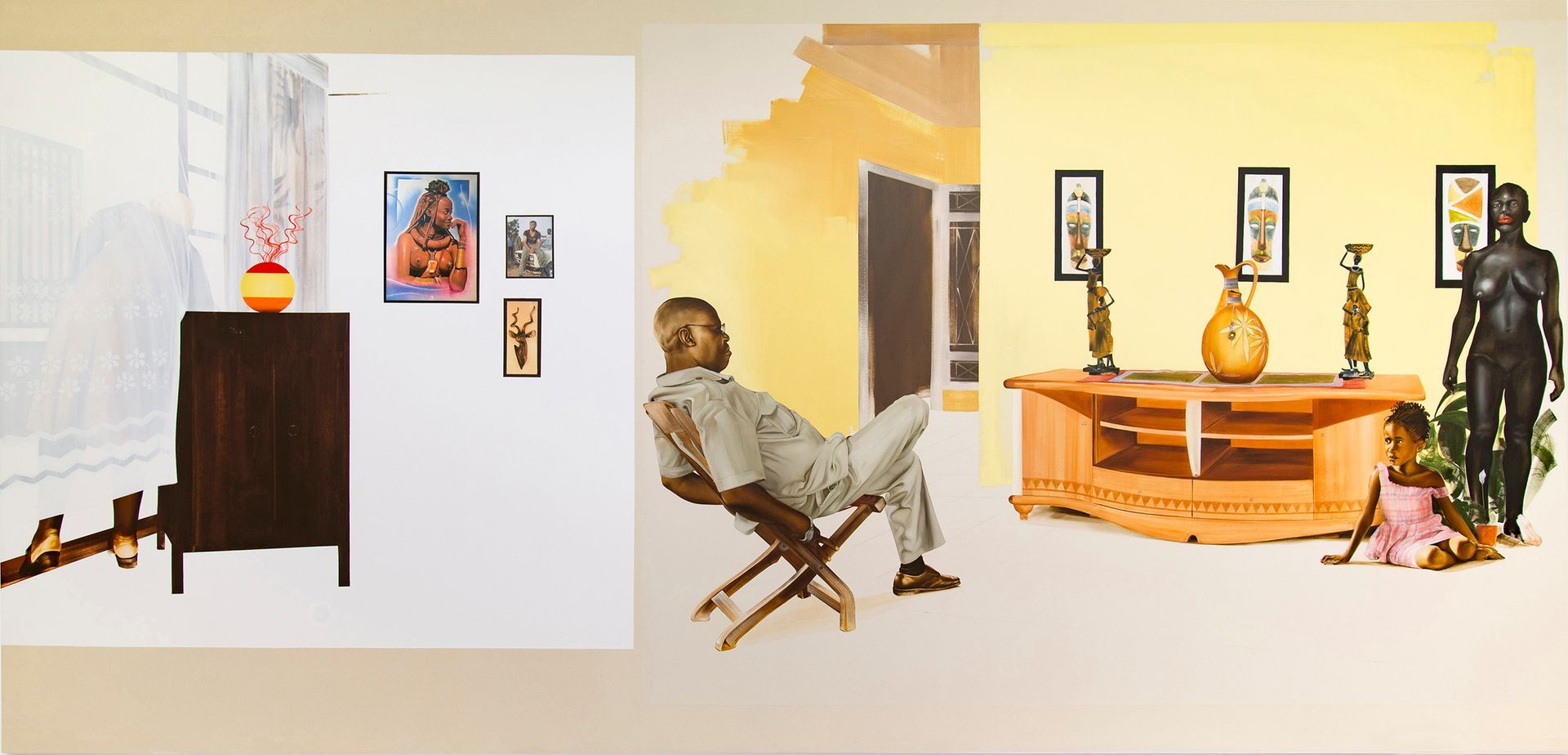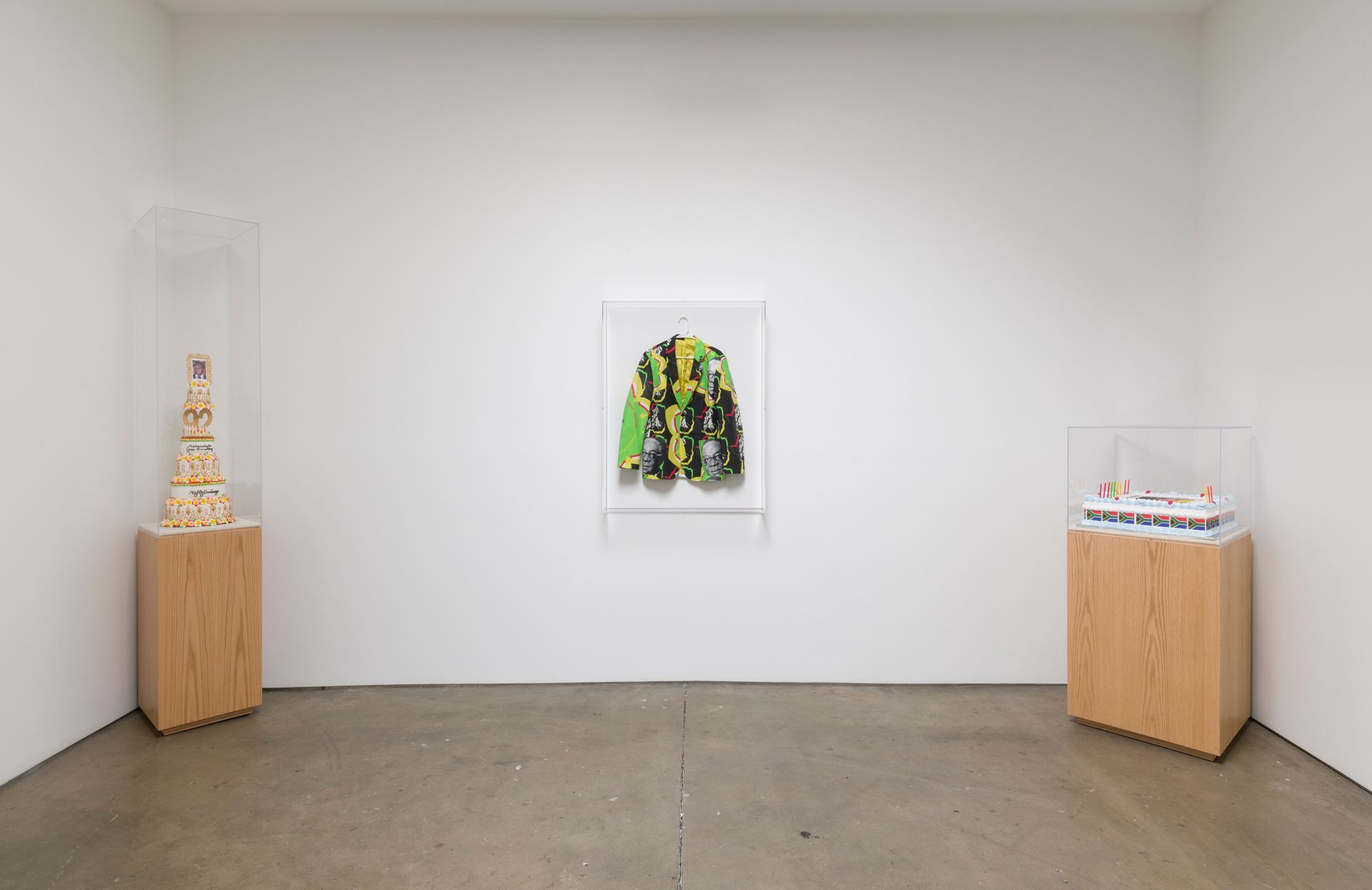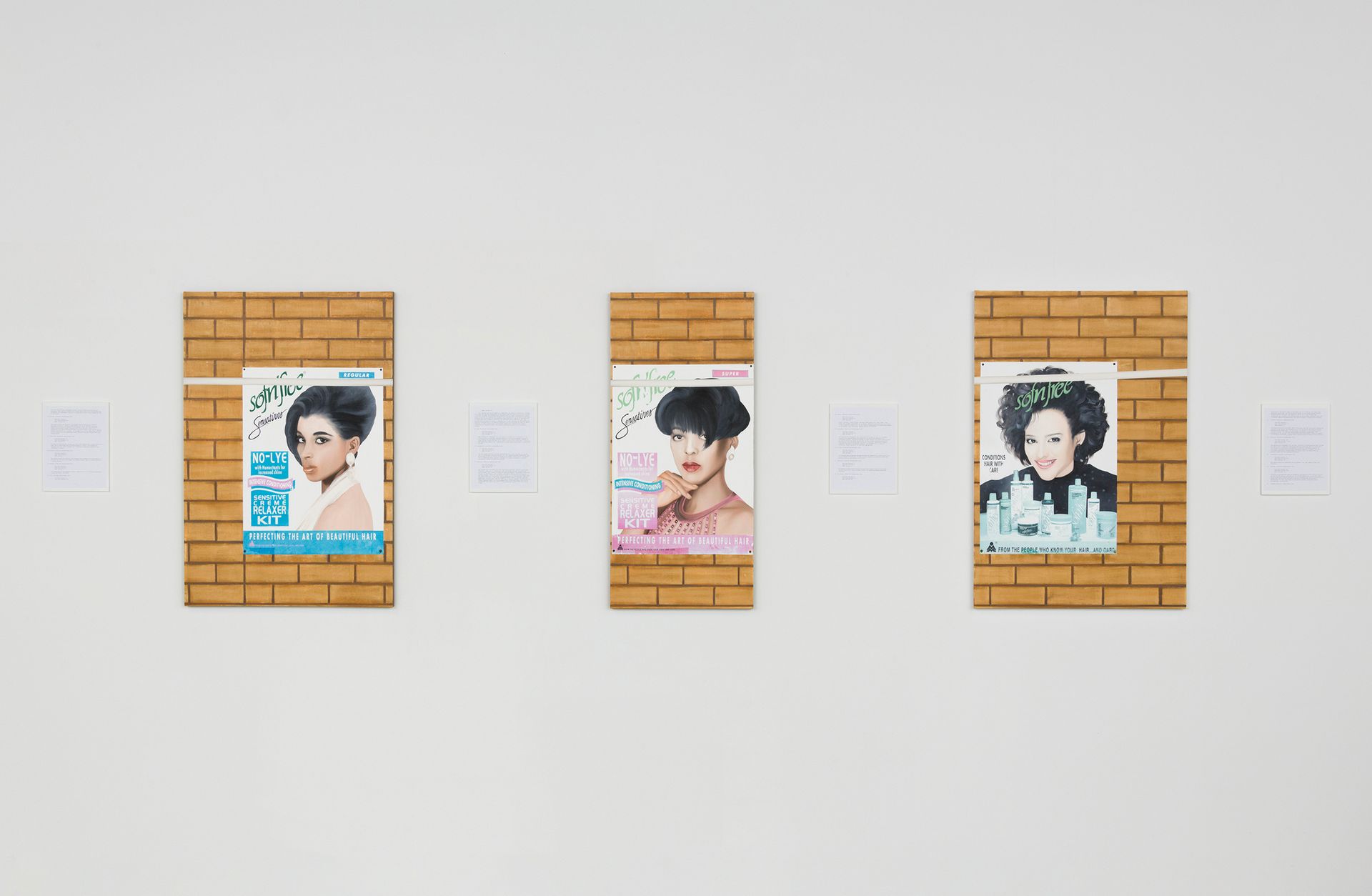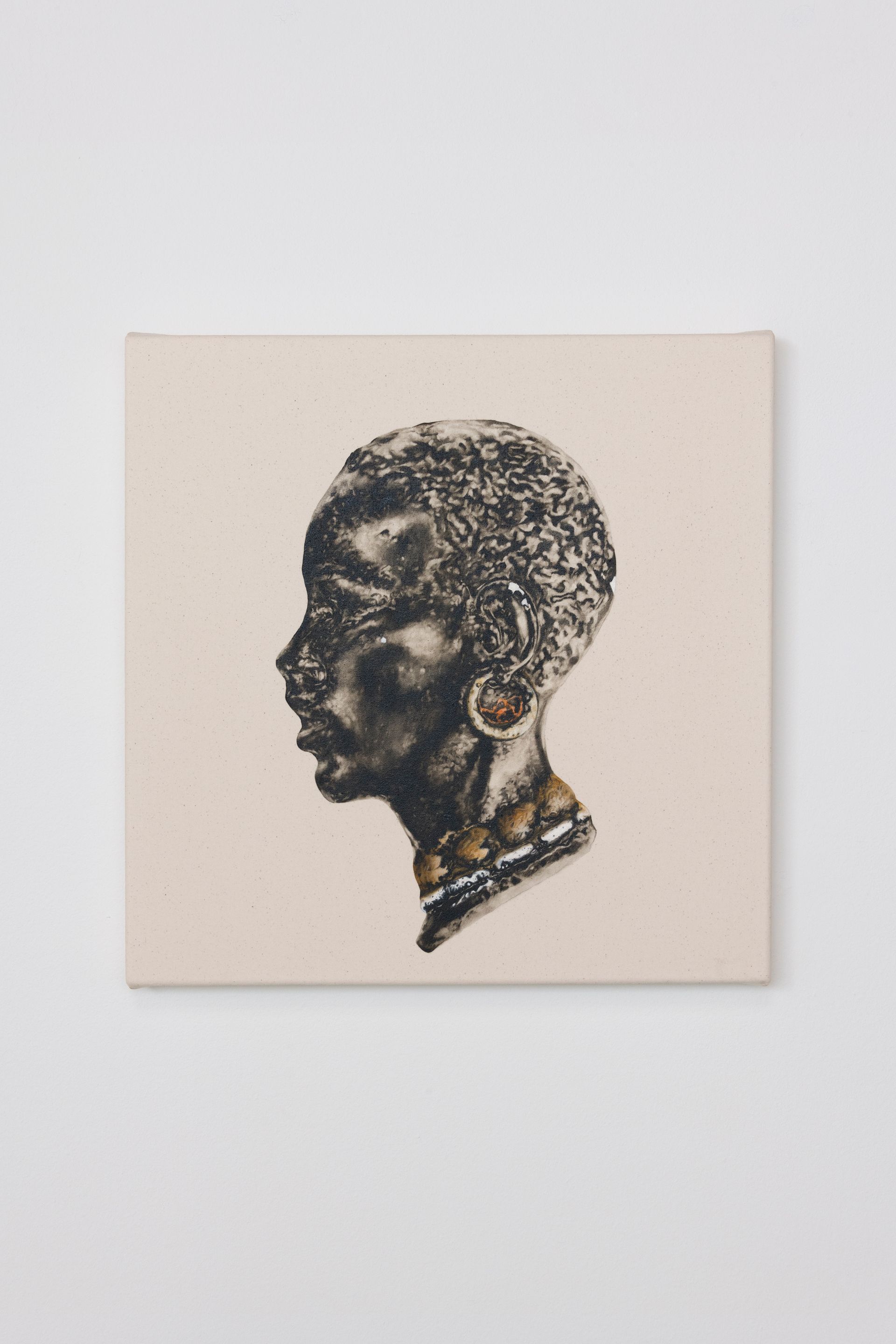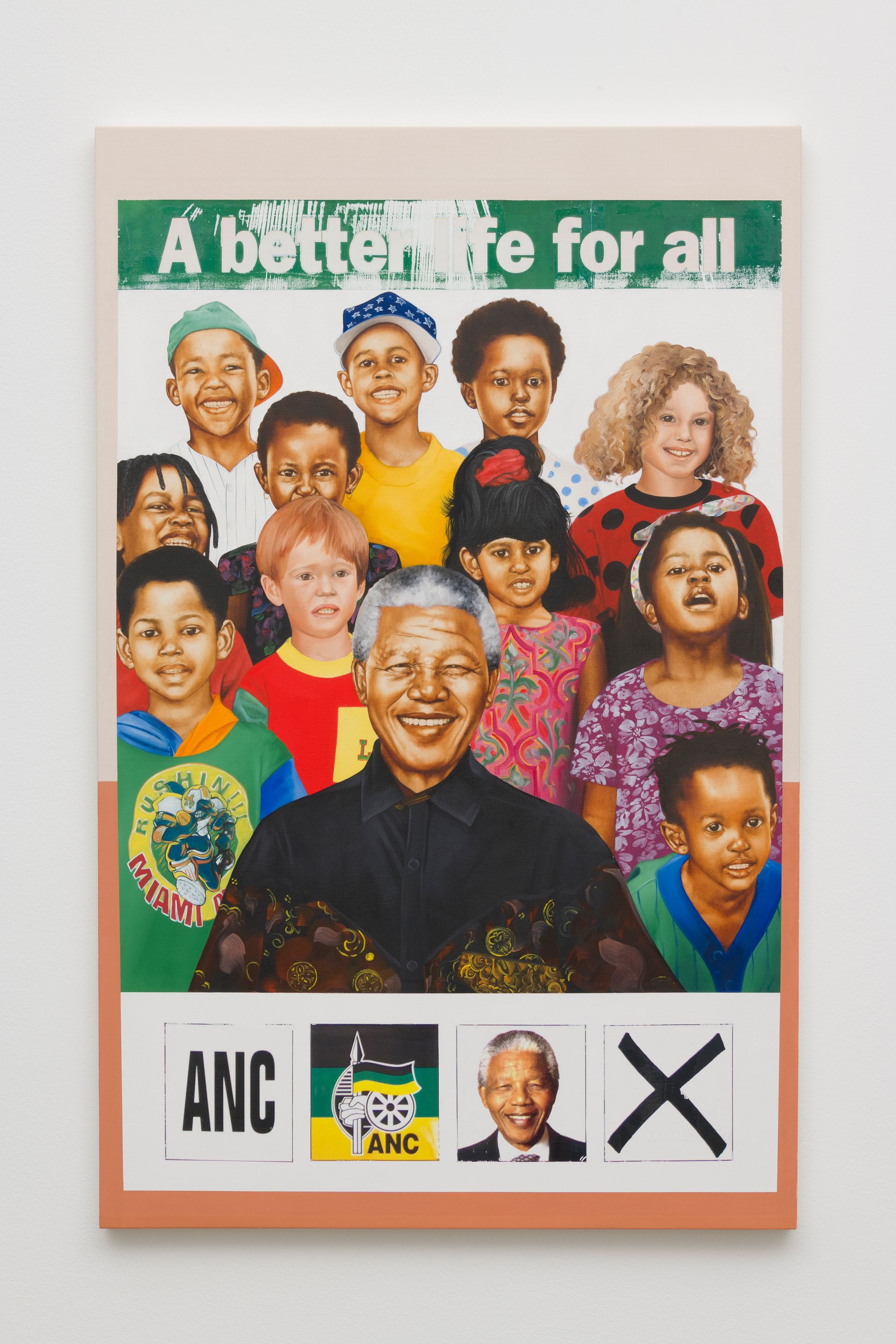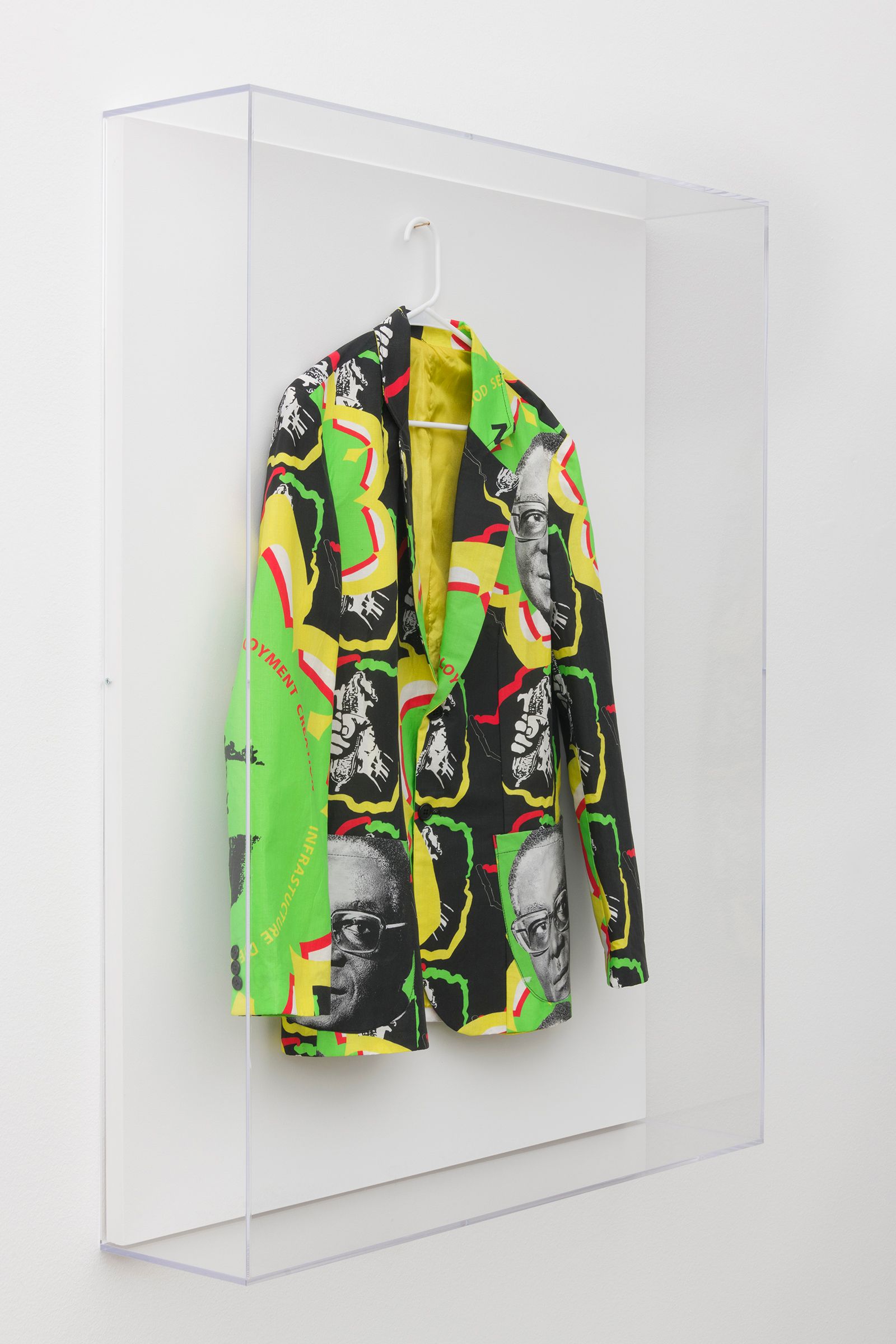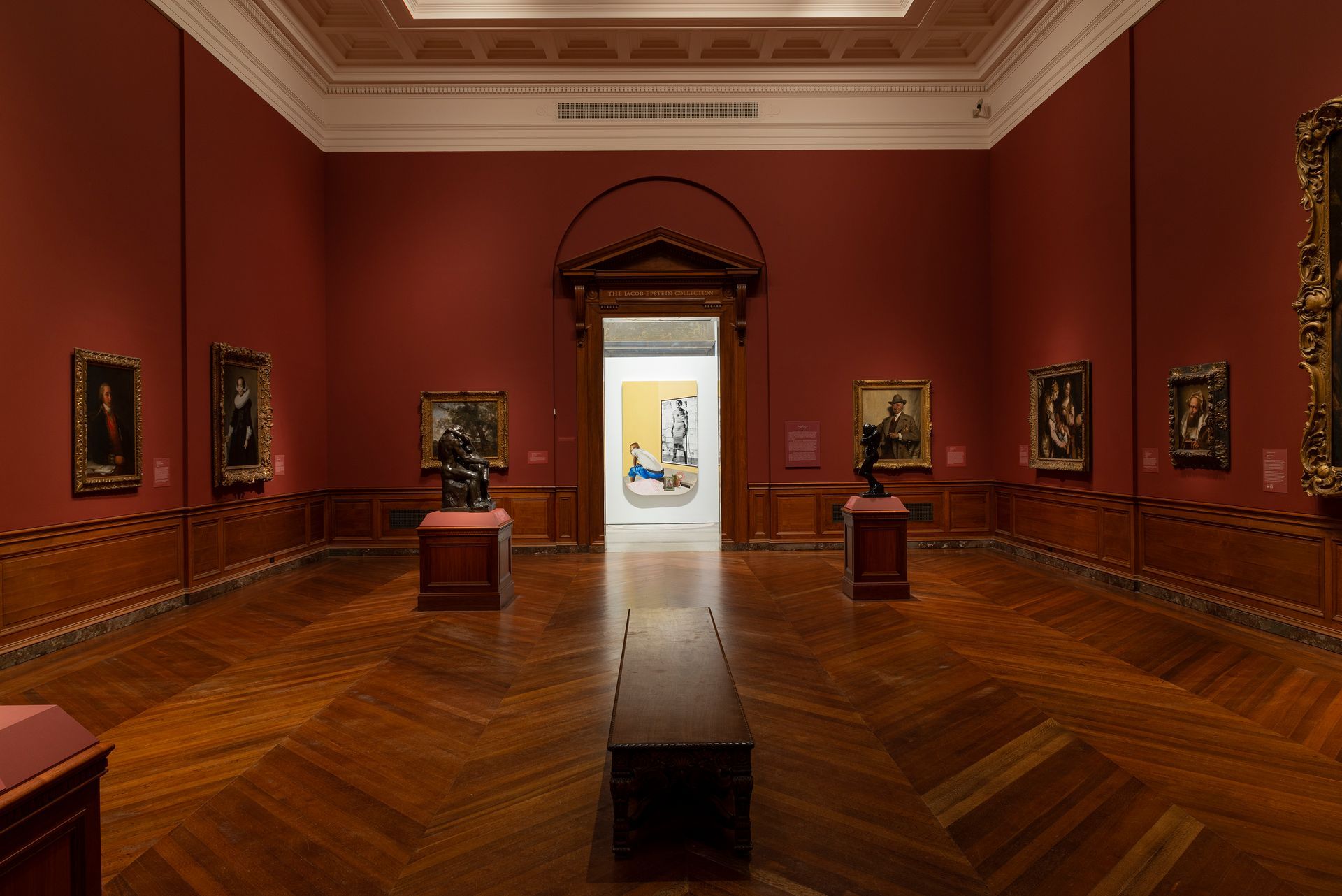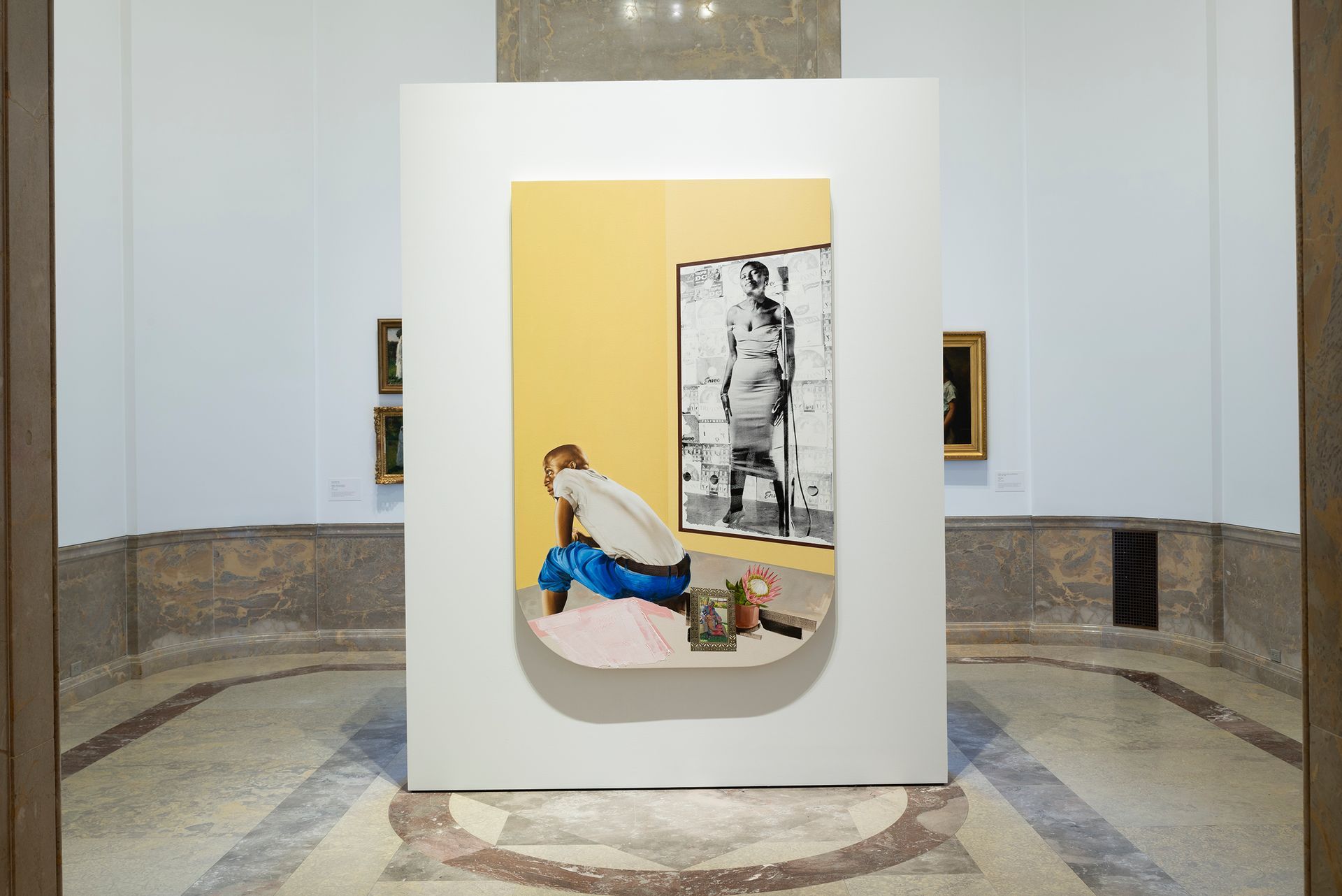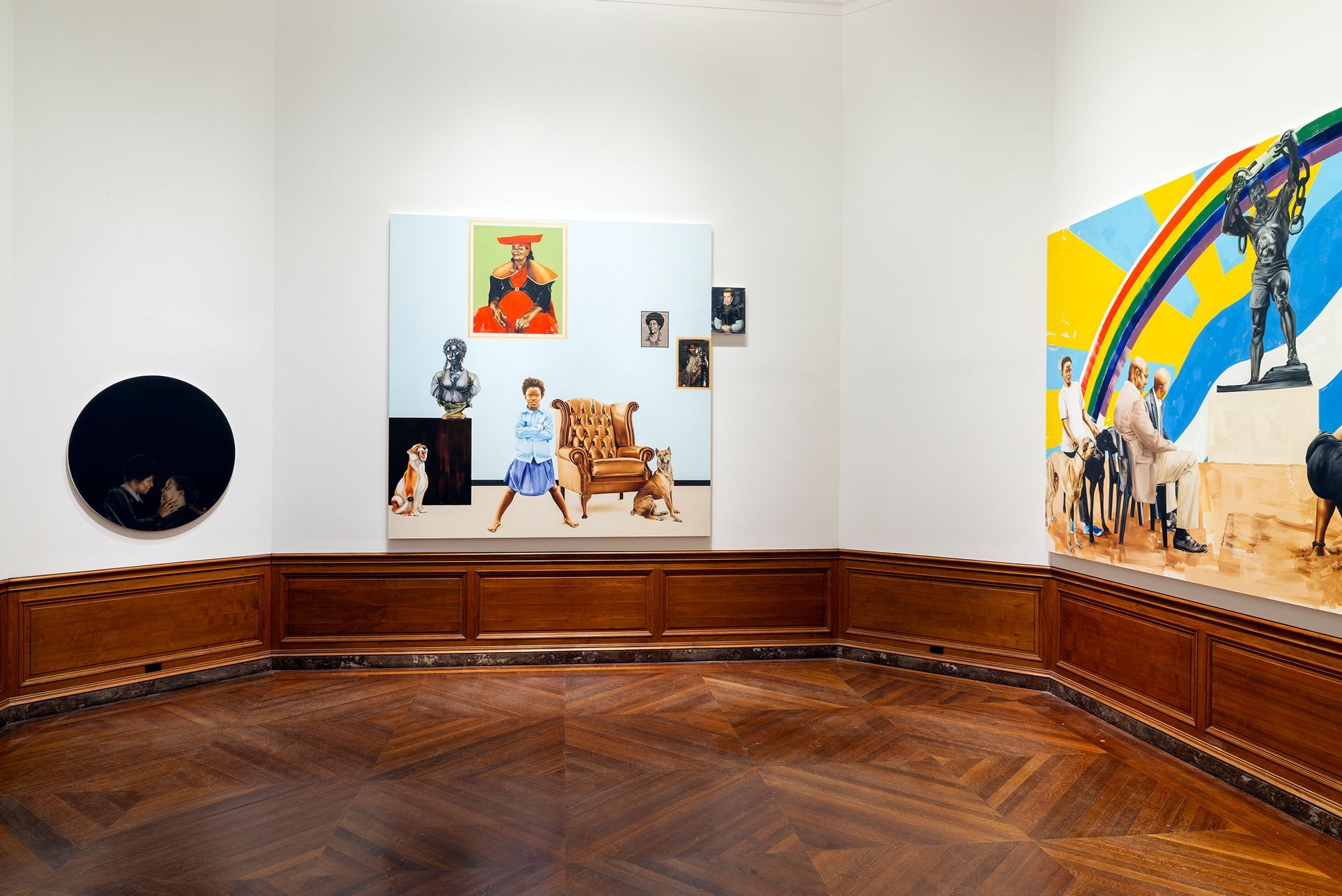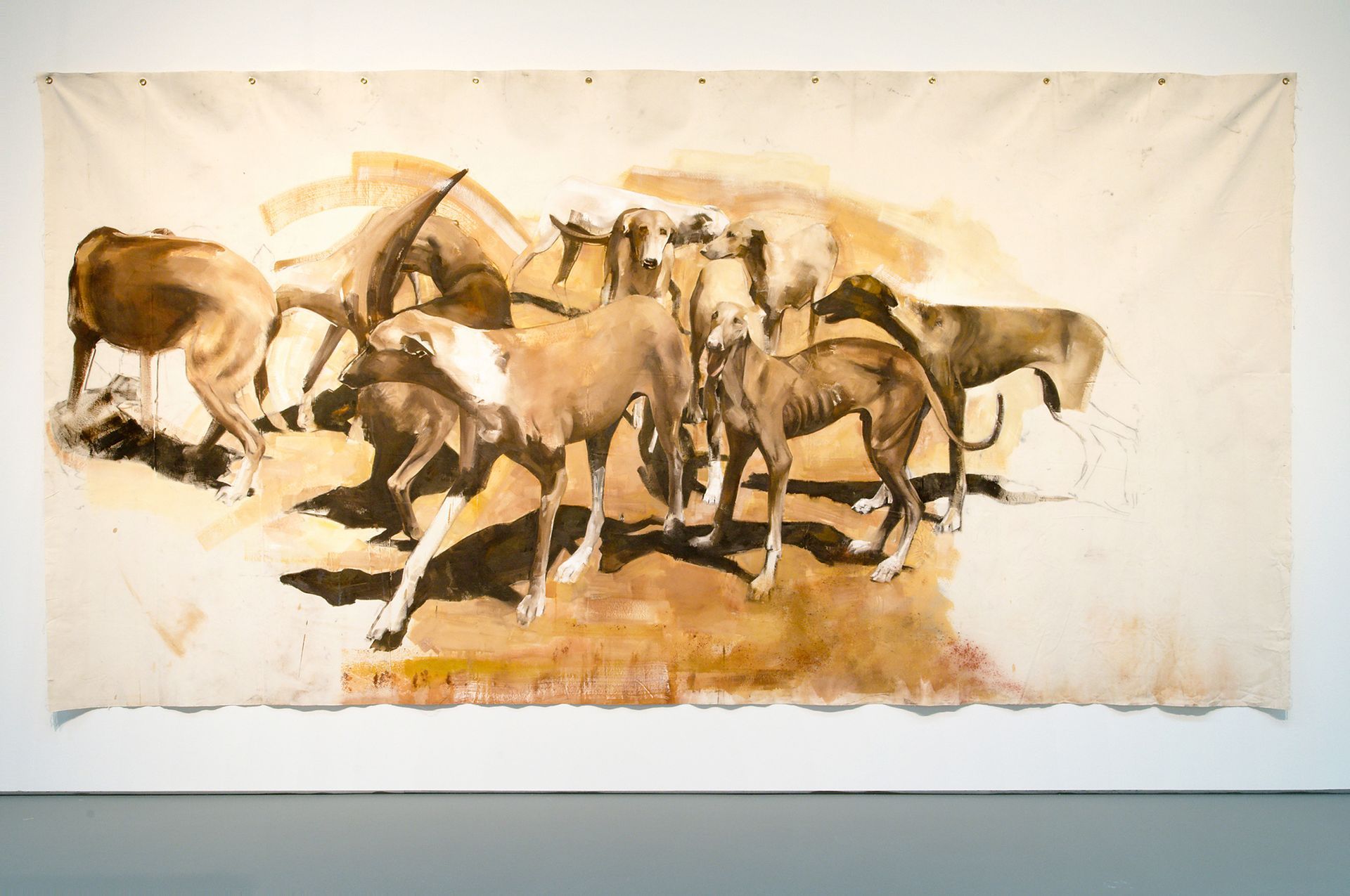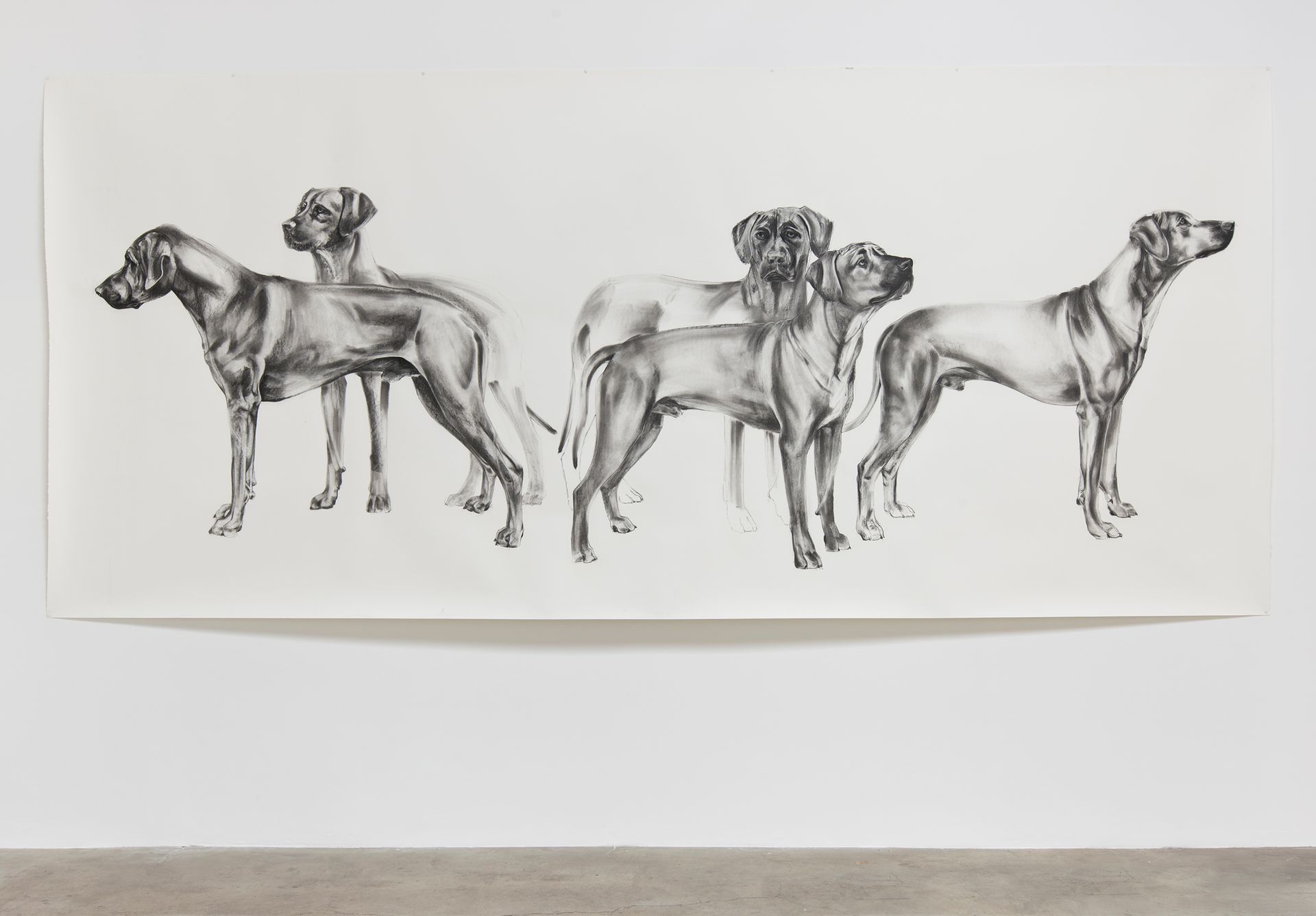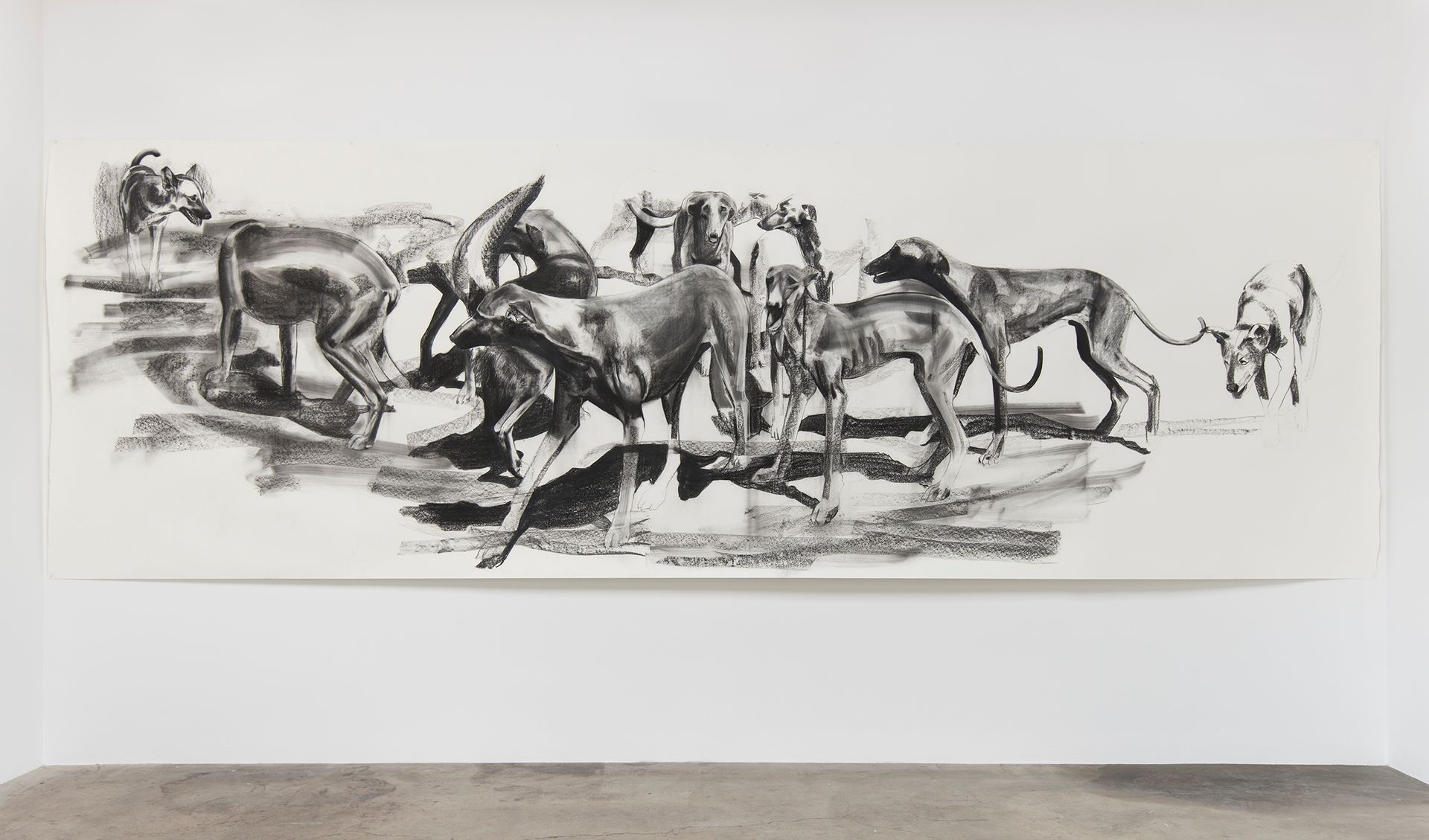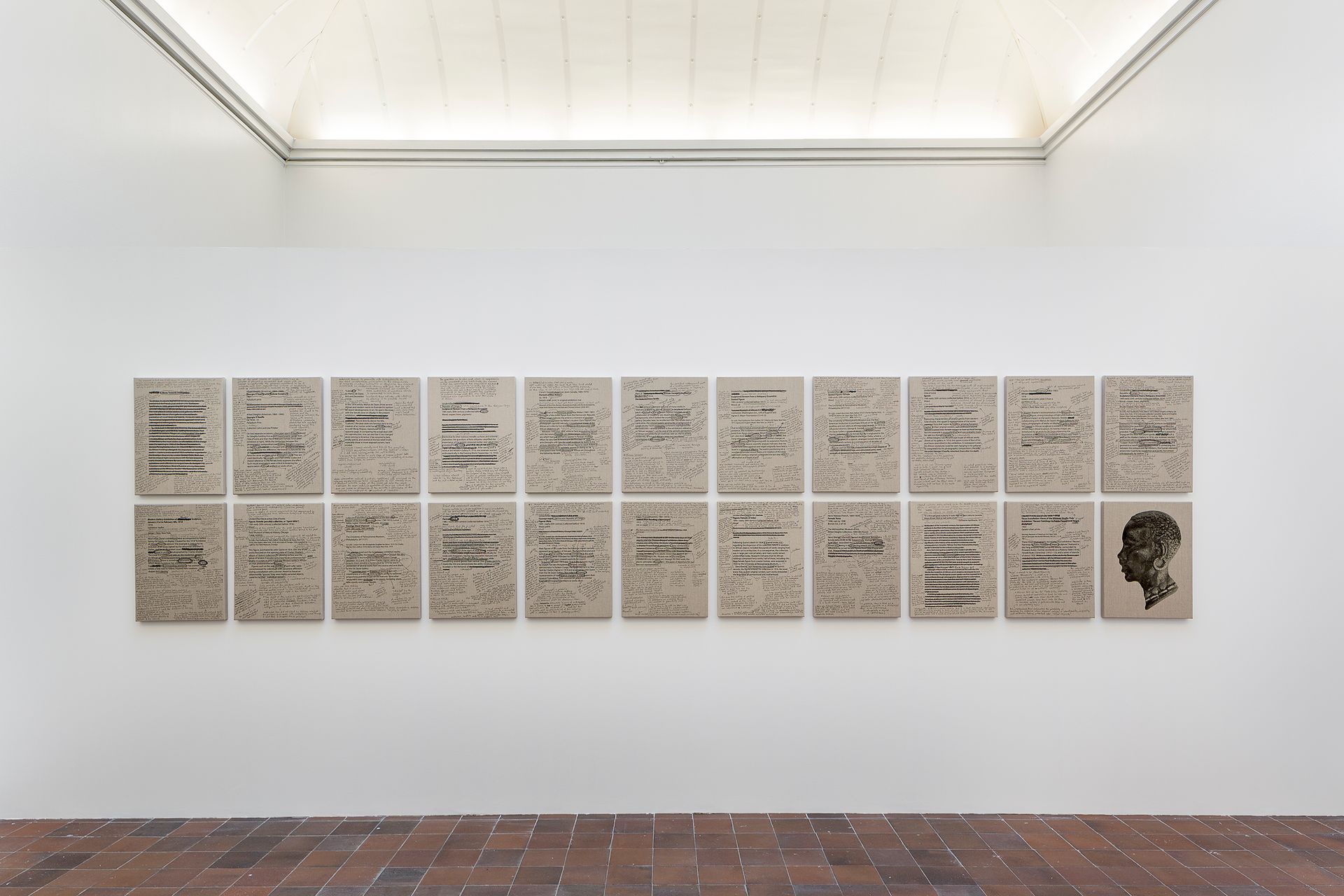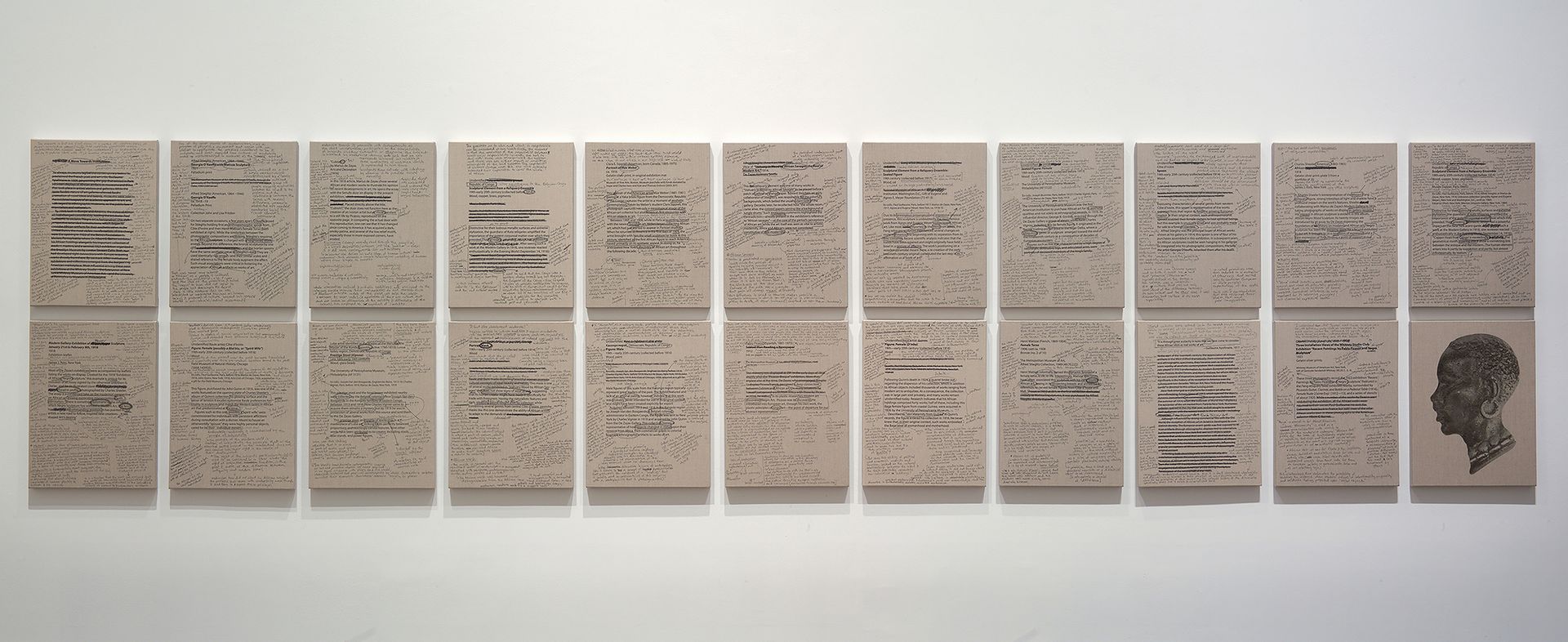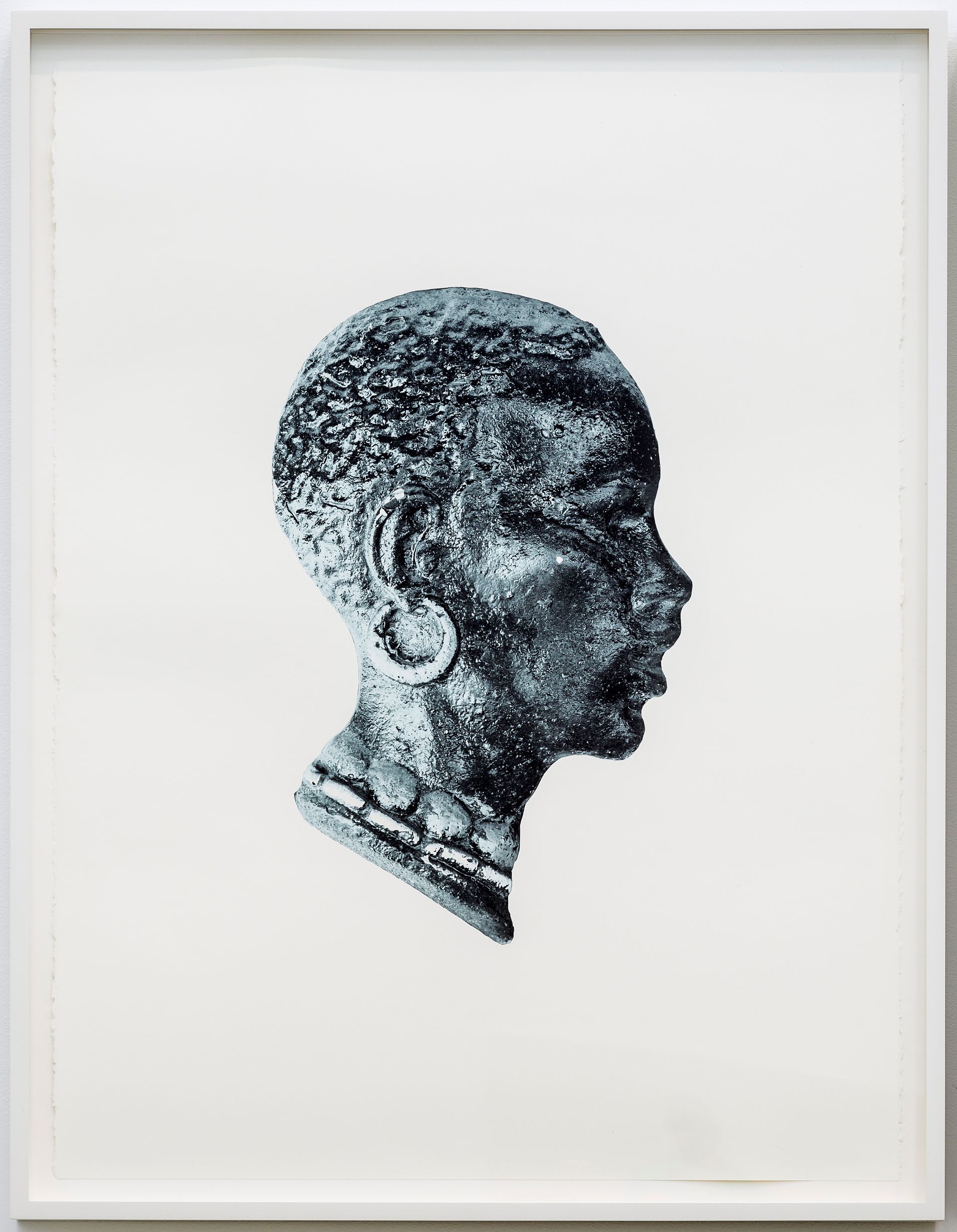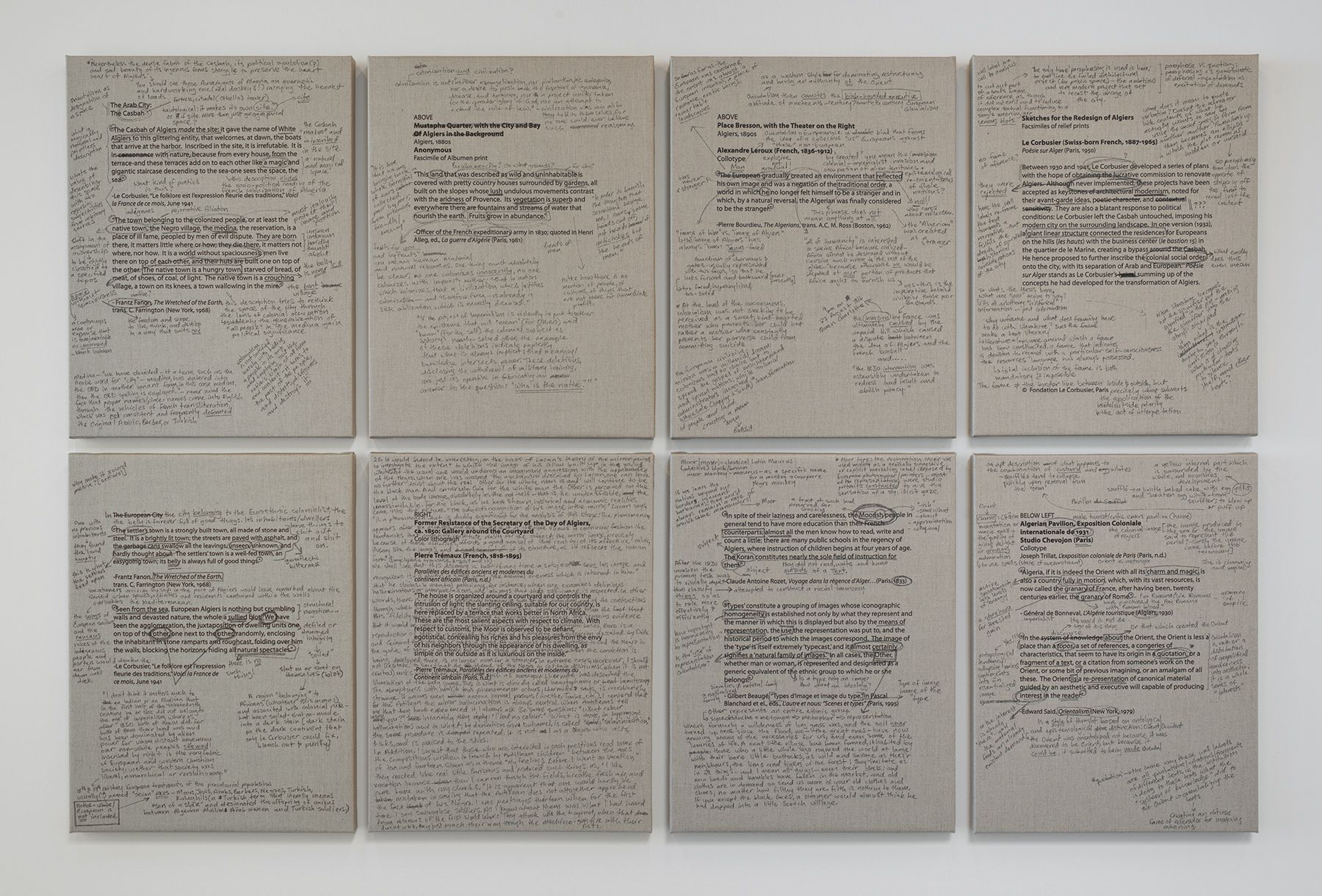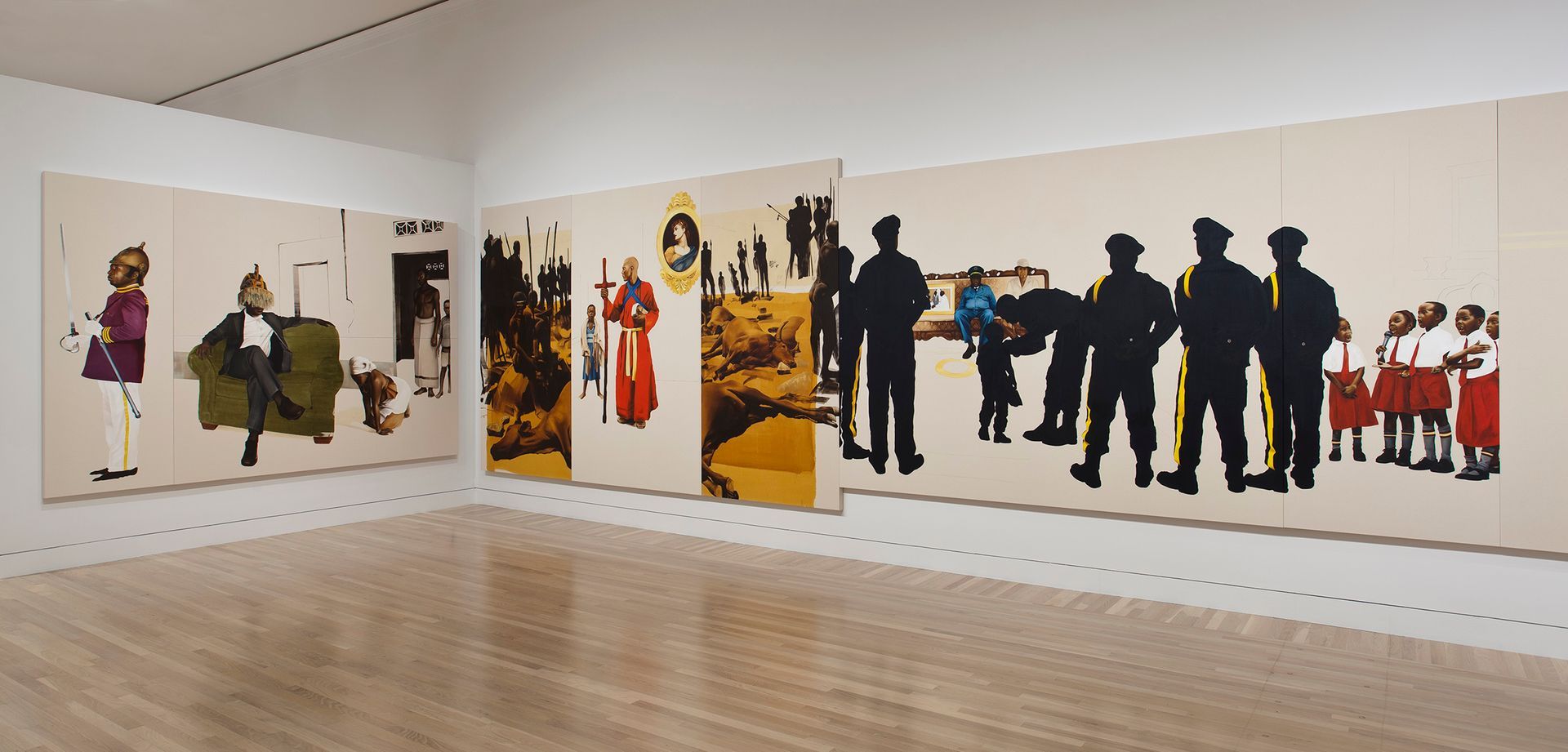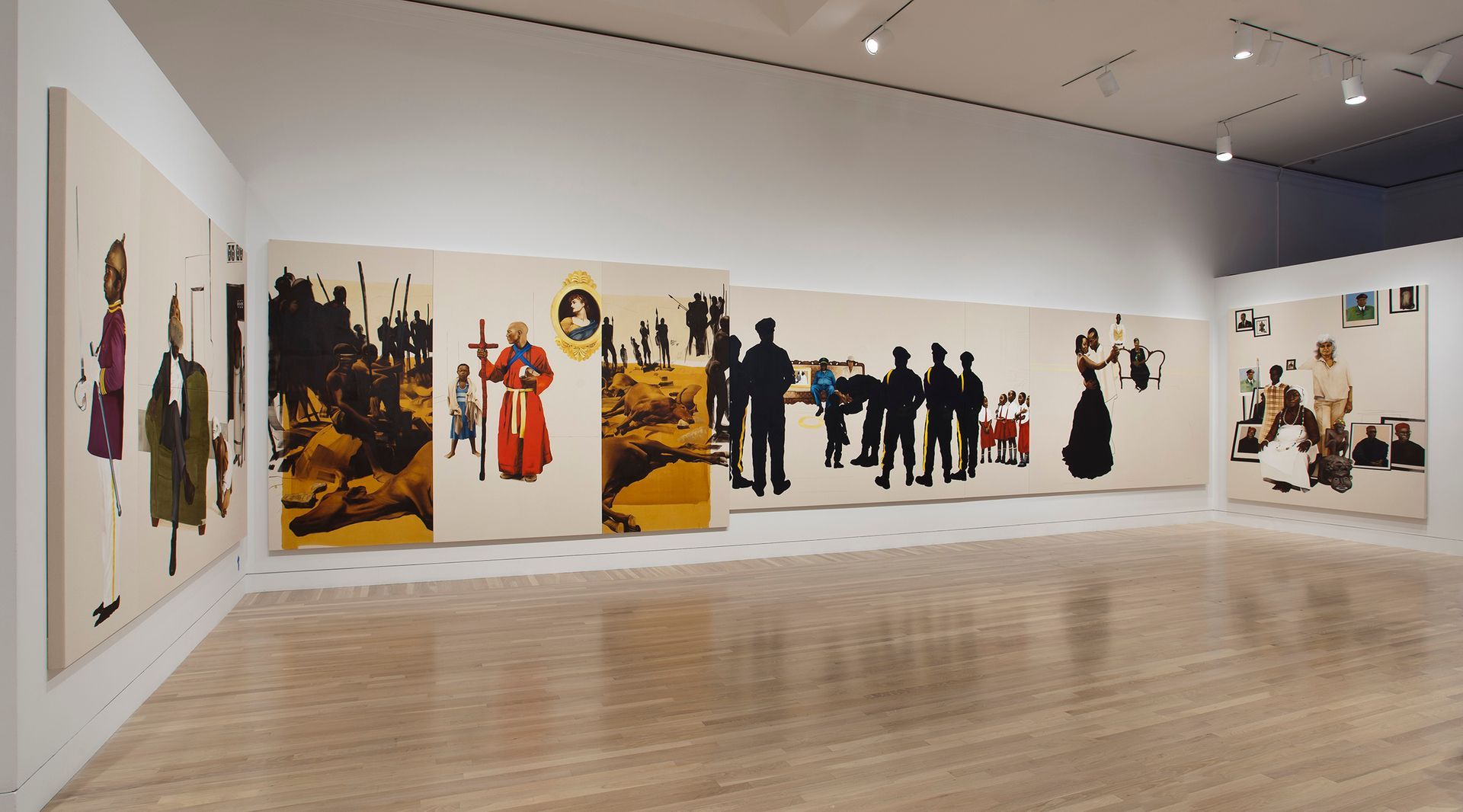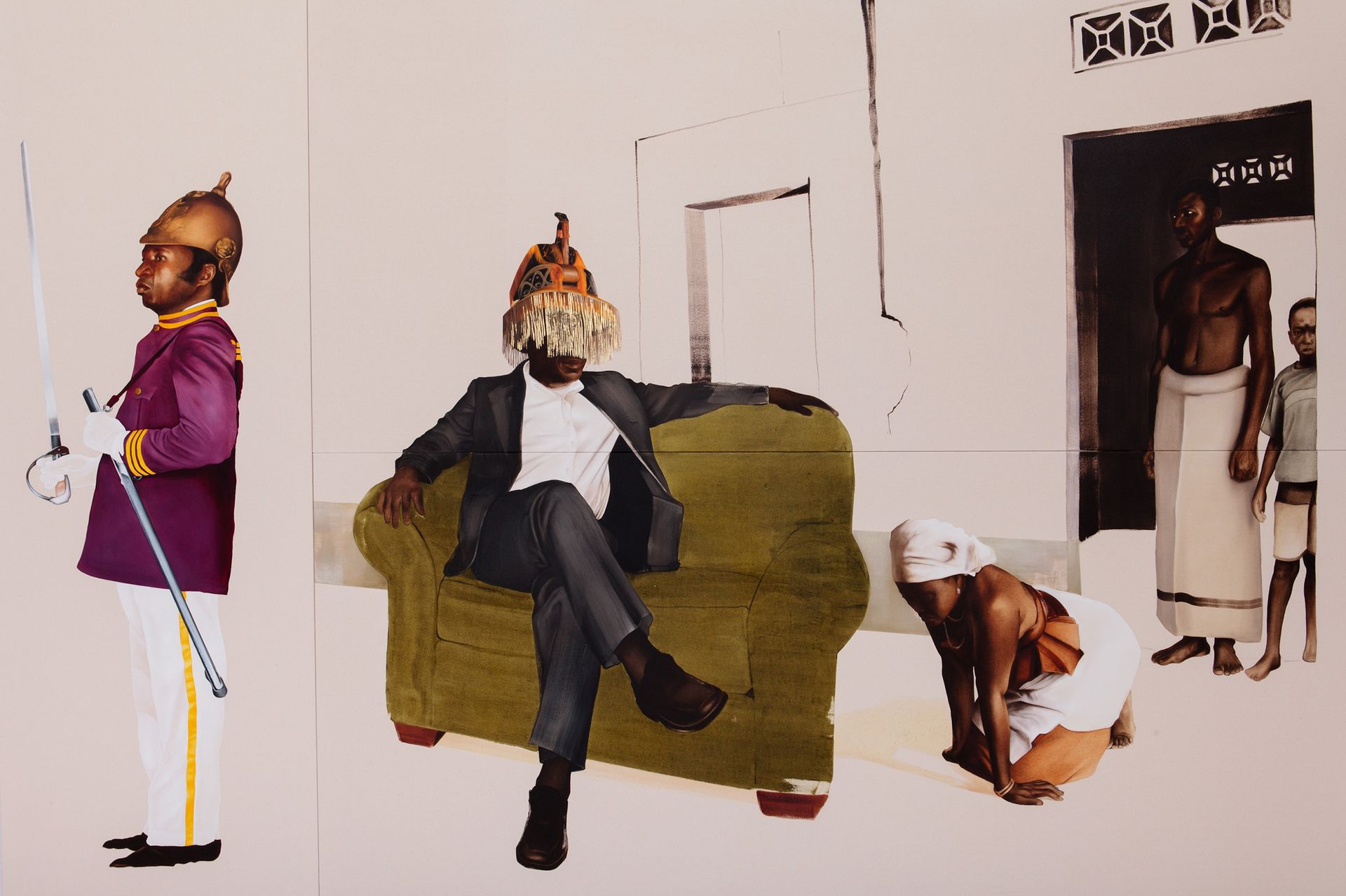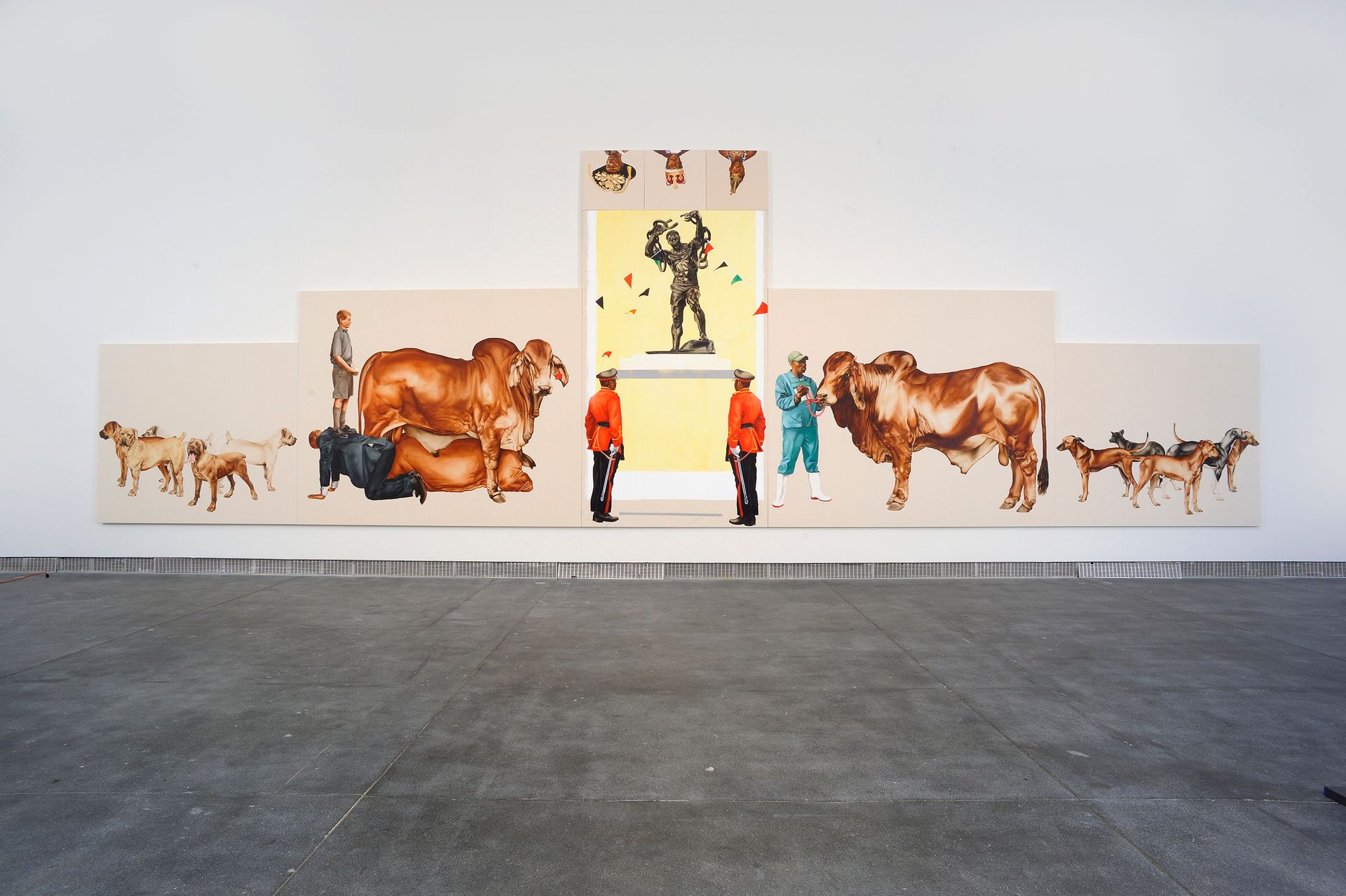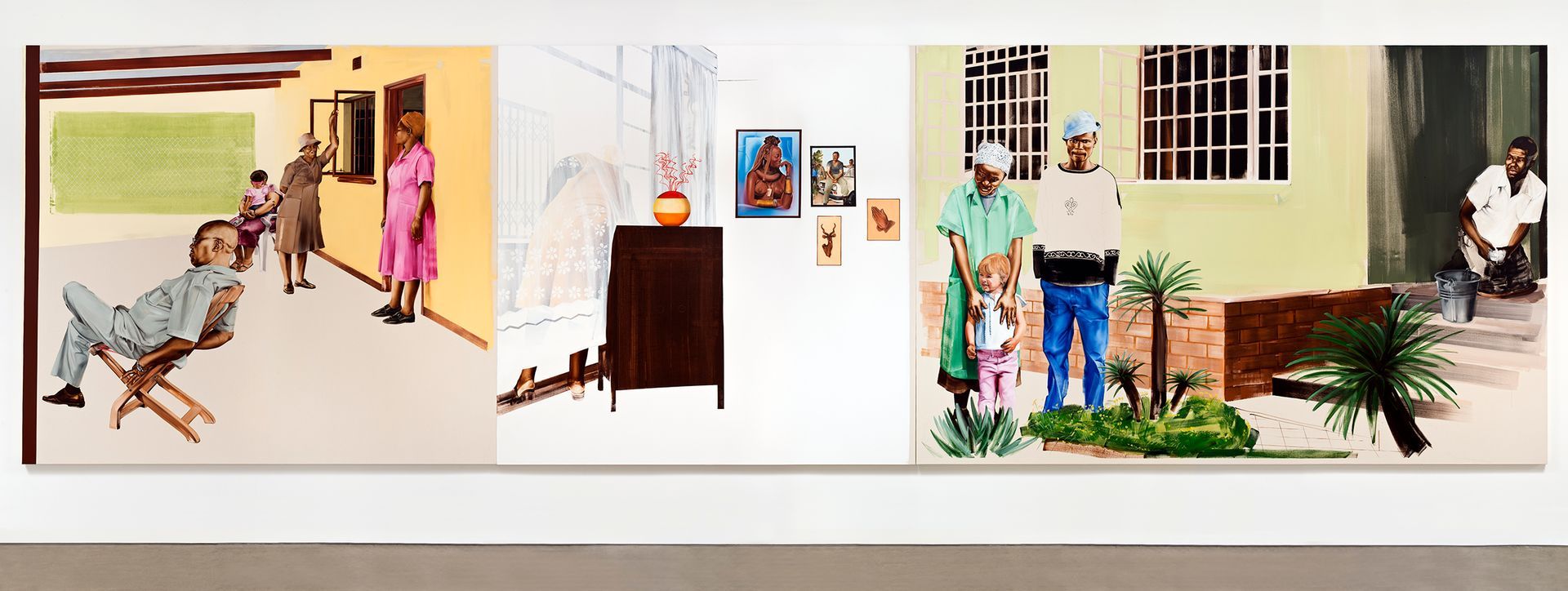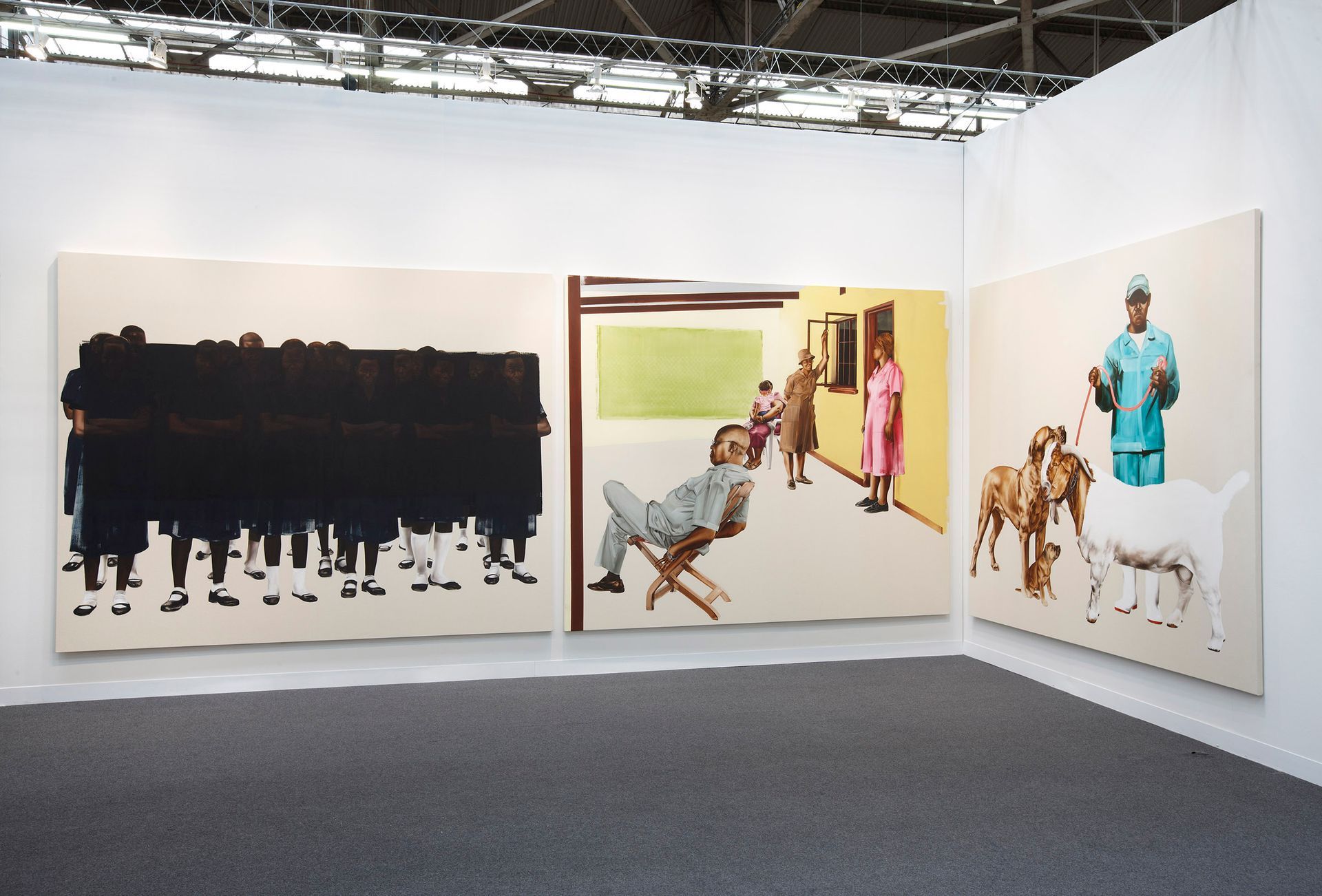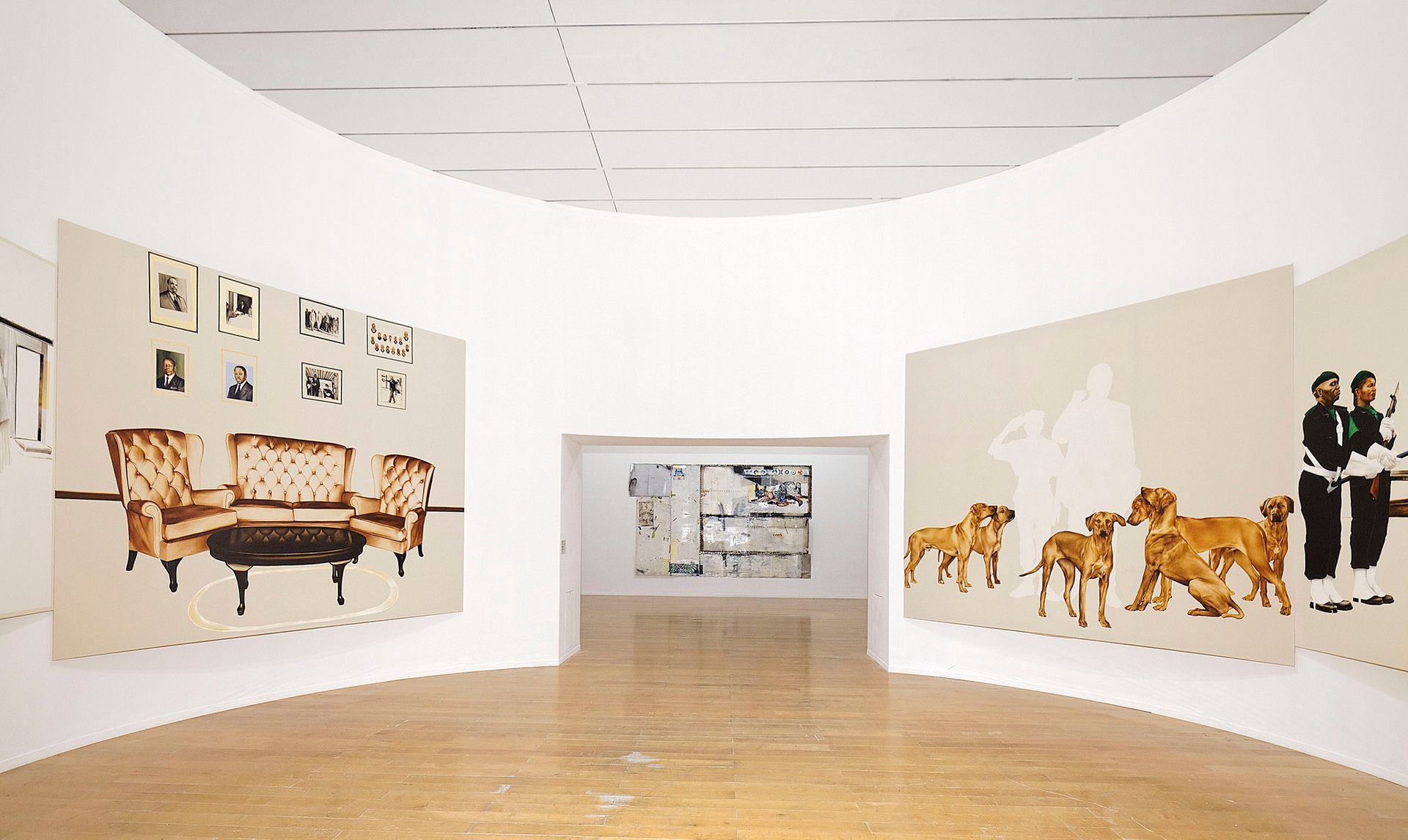Spaces of Subjection (2020 - Present)
Spaces of Subjection brings together the scope of historiography, human versus non-human, ancestral and indigenous histories, contours of divination, processes of socialization, discursive spaces that are constitutive of imagining (such as Black romanticism), and gaps that distinguish realism from magical realism, and surrealism from capriccio. Meditating on references ranging from Maya Angelou’s lecture “Rainbow in the Clouds,” James Baldwin’s film Take This Hammer, Michel Foucault’s treatise “The Subject and Power,” Beverly Jenkins’ romance novels, Michael Kelly’s analysis of aesthetic philosophies, to Jacques Lacan’s mirror stage theory, Mokgosi furthers the argument that subjection is a structural necessity for becoming.
Spaces of Subjection, Imaging Imaginations (2020-2023)
York University Art Gallery, installation view. Oil on canvas, 8 panels: 1) 96 x 132", 2) 84 x 84", 3) 96 x 96", 4) 104 X 120", 5) 72 x 92", 6) 72 x 96", 7) 120 x 96", 8) 72 x 96".
York University Art Gallery, installation view. Oil on canvas, 8 panels: 1) 96 x 132", 2) 84 x 84", 3) 96 x 96", 4) 104 X 120", 5) 72 x 92", 6) 72 x 96", 7) 120 x 96", 8) 72 x 96".
York University Art Gallery, installation view. Oil on canvas, 8 panels: 1) 96 x 132", 2) 84 x 84", 3) 96 x 96", 4) 104 X 120", 5) 72 x 92", 6) 72 x 96", 7) 120 x 96", 8) 72 x 96".
York University Art Gallery, installation view. Oil on canvas, 8 panels: 1) 96 x 132", 2) 84 x 84", 3) 96 x 96", 4) 104 X 120", 5) 72 x 92", 6) 72 x 96", 7) 120 x 96", 8) 72 x 96".
Spaces of Subjection: Black Paintings (2020-2023)
Saint Louis Art Museum, installation view. Oil on canvas. 108 x 240 x 2 inches, 108 x 240 x 2 inches, 108 x 216 x 2 inches, 96 x 72 x 2 inches, 156 x 72 inches.
Saint Louis Art Museum, installation view. Oil on canvas. 108 x 240 x 2 inches, 108 x 240 x 2 inches, 108 x 216 x 2 inches, 96 x 72 x 2 inches, 156 x 72 inches.
Saint Louis Art Museum, installation view. Oil on canvas. 108 x 240 x 2 inches, 108 x 240 x 2 inches, 108 x 216 x 2 inches, 96 x 72 x 2 inches, 156 x 72 inches.
Spaces of Subjection: Zones of Nonbeing (2018-2023)
Spaces of Subjection: Prints (2021-2023)
Five etchings.
36 1/4 x 28 1/2 inches, 28 1/4 x 22 inches, 16 1/2 x 16 1/2 inches , 23 x 17 inches, 22 1/4 x 22 inches (each sheet)
Edition 6
Published by Island Press
10 prints. Etching, drypoint, lithograph, screenprint. Various sizes. Edition of 6
Published by Anderson Ranch Arts Center
Etching
Your Trip to Africa (2018-2020)
The project centers on the 1962 film Unsere Afrikareise (Our Trip to Africa), by the filmmaker Peter Kubelka. Kubelka is widely recognized as one of the progenitors of the Structural film movement, which attempts to distill the cinematic experience to its purest material form. The film came about when Kubelka was invited by a wealthy Austrian family to record their safari trip through Africa.
The social revolution of our time cannot take its poetry from the past but only from the poetry of the future. (2019)
The title of this project, taken from Karl Marx's The Eighteenth Brumaire of Louis Bonaparte, refers to revolutionary discourses, and proposes that it is only through disavowing the past that revolutionary action can occur. Similar to this argument, this body of work argues for a disavowal of past grand narratives as well as the recuperation of non-Western forms of knowledge that were not privileged to coexist with conventional or established discursive frameworks. All twelve paintings are paired with a texts that is taken from the writings of women either from Africa or the African diaspora. The texts and paintings examine a wide range of issues from African feminism to the struggle for liberation by African countries, love, solidarity, and aesthetics, to mention a few. By pairing text and image, Mokgosi's work aims to further questions around the politics of representation and strategies of resistance.
Democratic Intuition (2013-2019)
Democratic Intuition, an 8-chapter project of oil on canvas paintings and sculptures, examines the ways in which democracy is conceptualized and practiced within the life worlds of subjects that occupy southern Africa. In dealing with this material, Mokgosi focuses on how democracy can be thought of as something that is inscribed within the individual from various institutions; i.e. as Gayatri Spivak argues, the intuitions of democracy reside in state apparatuses.
Chapters: Objects of Desire; Chimurenga; Acts of Resistance; Bread, Butter, and Power; Lex; Lerato (Love); Comrades I and II; Exordium
Bread, Butter, and Power
The paintings in this chapter take up the specific issue of gendered divisions of labor, depicting the multitude of ways these divisions are manifest in daily life. Some paintings show children and market stands, alluding to the work women do in informal markets to provide for their families. In other interior scenes, it is the absence of women that speaks to the hurdles they are yet to overcome. And, two paintings covered in Setswana text retell allegorical stories that have been passed down orally for generations. This focus on gender roles intersects with issues of class, ethnicity, and education, woven throughout the series, with the aim of examining the history, meaning and practice of feminism in the southern African context.
Fowler Museum, installation view. Oil, acrylic, bleach, graphite, photo and pigment transfer, permanent marker on canvas
21 panels: 1 panel: 108 x 72 x 2 inches
18 panels: 96 x 96 x 2 inches
1 panel: 96 x 132 x 2 inches
1 canvas in tube: 12 x 84 inches
Fowler Museum, installation view. Oil, acrylic, bleach, graphite, photo and pigment transfer, permanent marker on canvas
21 panels: 1 panel: 108 x 72 x 2 inches
18 panels: 96 x 96 x 2 inches
1 panel: 96 x 132 x 2 inches
1 canvas in tube: 12 x 84 inches
Oil on canvas. 84"x84"
Comrades
Comrades I and II consider the historical, aesthetic, and conceptual links between southern African liberation movements and communism. This chapter is comprised of figurative paintings and text-based work, made by painting portrait linen with bleach. The stories painted on the linen, are referred to as dinaane in Setswana, a form of storytelling rooted in Setswana oral tradition.
Exordium
Denials of opportunities for intellectual labor take a number of forms in this introductory chapter. A group of young girls in blue uniforms holding gardening implements references at times the privileging in Botswana’s public schools of manual labor and “practical” skills, which often replace academic subjects depending on socio-economic contexts. Another panel showing white animals and a Zulu warrior alludes to the Bambatha Rebellion of 1906, in which a number of Zulu communities killed their own white animals (in symbolic resistance to their white oppressors) to protest a tax intended to move them into cities, where they would help meet South African mining companies’ need for exploitative manual labor. A man in a business suit is juxtaposed with women in housekeeping uniforms, underscoring the disparity in educational and professional prospects available to women and men.
Lerato
“Lerato” (meaning “love”) was developed around ideas of allegory and love, and used William-Adolphe Bouguereau’s paintings as a compositional case study. The chapter is informed by both allegorical paintings and literary theories on allegory, with special attention on the work of Walter Benjamin, Paul de Man, Jacques Derrida and Fredric Jameson. For Mokgosi, a viewer cannot help but be cognizant of the method of reading and interpretation at the moment they begin to engage with any allegorical narrative (whether visual or textual). Defined as “a narrative whose outward appearance is contrived to suggest a hidden meaning” – allegories always involve a re-writing or re-imagining of preexisting texts. Added to this inquiry, and perhaps more importantly, is the unacknowledged fact that William-Adolphe Bouguereau produced paintings, such as The Motherland (1883), during the Scramble for Africa at the turn of the 20th century.
Lex
Lex derives its title from the legal concept of lex loci actus, or the law of the place where an alleged act occurred. The paintings reflect on how the rules of a community, specifically those regarding labor and gender, govern individual autonomy and behavior. The symbols of democracy as a political system, such as community participation, voting booths, and houses of parliament, are but a spectral presence in the paintings. This absence is used to focus on the importance of intersubjective exchange and dialogue.
Williams College Museum of Art, installation view. Oil, acrylic and pigment transfer on canvas. Seven panels, 16' x 77' (approx. overall dimensions)
Williams College Museum of Art, installation view. Oil, acrylic and pigment transfer on canvas. Seven panels, 16' x 77' (approx. overall dimensions)
Objects of Desire
Research for Objects of Desire and Chimurenga is centered on the Museum of Modern Art’s archives, specifically the exhibitions “Primitivism” in 20th Century Art: Affinity of the Tribal and the Modern (1984) and Objects of Desire: The Modern Still Life (1997). “Primitivism” has become infamous for the public backlash, the main criticism involving the way in which curator William Rubin discussed the African works on view only as they were perceived and collected by the early Modernists, not as objects with their own histories. Objects of Desire made a strong argument for viewing the inanimate objects depicted by the Modernists as evidence of a growing lexicon of affluence among the cosmopolitan artists. Mokgosi approaches these two exhibitions through an examination of the contemporary African object in his own paintings with the aim of challenging the legacy of African art as a tool of the Modernists in developing their own methodologies.
Acts of Resistance
Acts of Resistance, developed over the course of two years, examines the idea of resistance. In this work, Mokgosi is interested in an expansive idea of resistance, which involves both formal and informal resistance. Formal resistance, whether armed or passive, targets the state and institutional forces. Informal resistance encompasses everyday acts, both unconscious and conscious. To the most part, informal resistance finds its expression through cultural resistance, which is central in the struggle against imperialism.
Africanis
Africanis (2009 – present) is an extension of Mokgosi’s large-scale project-based paintings. Titled after a breed of dog indigenous to southern Africa, Africanis explores ideas of nationalism and the effects of colonialism that are also present in works such as Pax Afrikaner (2008-2011) and Pax Kaffraria (2011-Present). In the aforementioned projects, Mokgosi uses other dog breeds such as the Rhodesian Ridgeback and the Boerboel, as well as bulls and goats. Africanis dogs, by contrast, are revered as one of the few breeds that arose by natural selection rather than through human breeding. Unlike most of his other projects, which encompass multi-panel paintings of human figures in specific geopolitical spaces, this work portrays domesticated animals that have come to represent ideas of 'purity' and 'native-ness' within the culture of southern African dog breeding. By purposely excluding human figures, Africanis addresses not only the effects that domesticated animals have had on colonial farm life and political contexts in southern Africa, but more importantly reveals how domesticated animals play a central role in the development of southern African cultural history and shaped human history.
Modern Art: The Root of African Savages
Modern Art: The Root of African Savages (2012 – 2014) addresses the re-inscription of colonial discourses in an ongoing series of paintings using museum labels as source material. In this project, Mokgosi makes critical interventions in the museum didactics that are primarily used by viewers to understands works of art. This work systematically deconstructs the power dynamics and cultural biases that underpin these presumably neutral, educational descriptors. Mokgosi takes as his subject the exhibition African Art, New York, and the Avant-Garde (The Metropolitan Museum of Art, New York, 2012).
Wall of Casbah
In Wall of Casbah (2009 – 2014), Mokgosi takes as his subject the exhibition Walls of Algiers: Narratives of the City (Getty Center, 2009). He makes critical interventions in the didactics that structure the way the public understands works of art, systematically deconstructing the power dynamics and cultural biases that underpin these presumably neutral, educational descriptors.
Pax Afrikaner
Pax Afrikaner examines the physical and epistemological violence towards black foreigners in Southern Africa, precipitated by xenophobia. The four-chapter project (Recto, Full Belly, Satisfaction of Sensation, and Good Boy), created between 2008 and 2010 uses psychoanalytic theory (specifically the work of Gayatri Spivak, Bruce Fink, Slavoj Žižek and Yannis Stavrakakis) as a framework to probe the persistence and fixity of national identification in the age of globalization, ‘trans-nationality’, and the so-called fluidity and multiplicity of identity formation.
